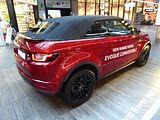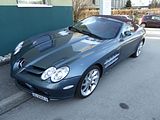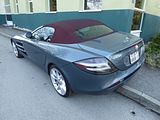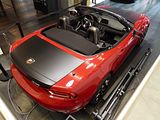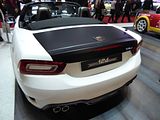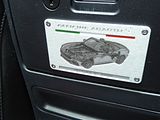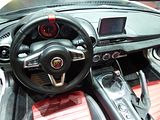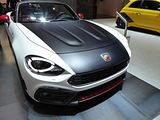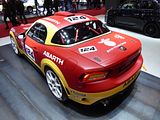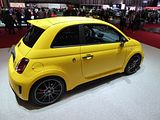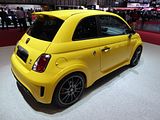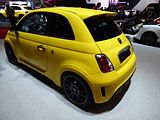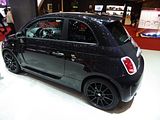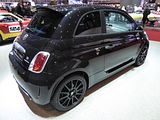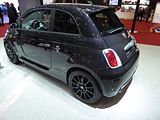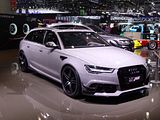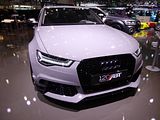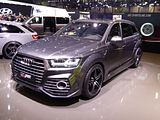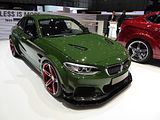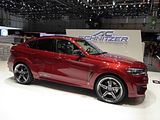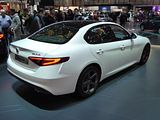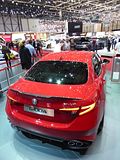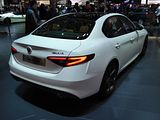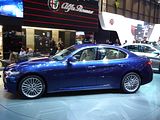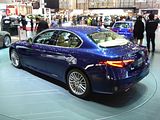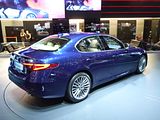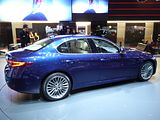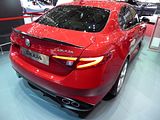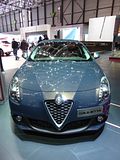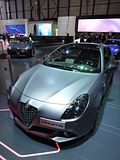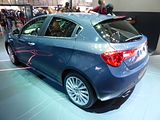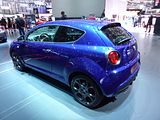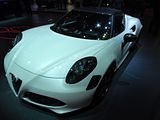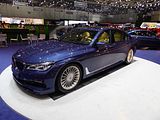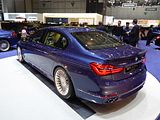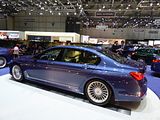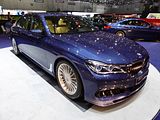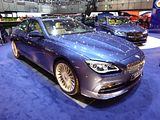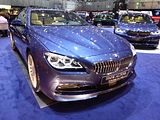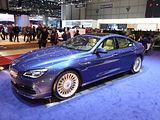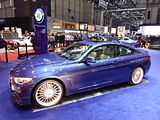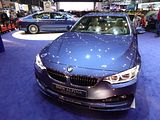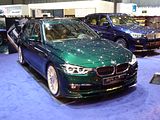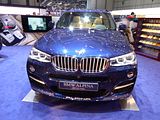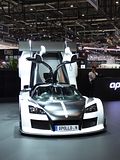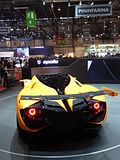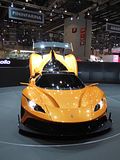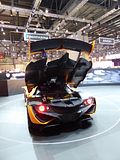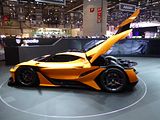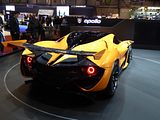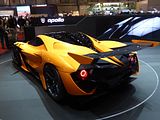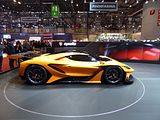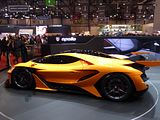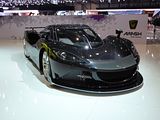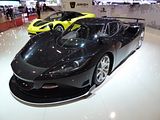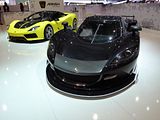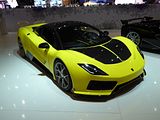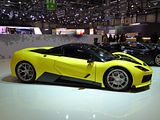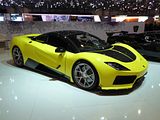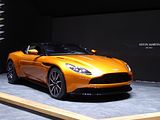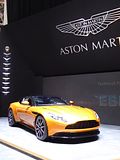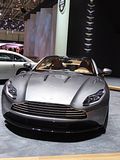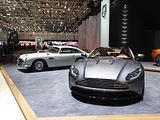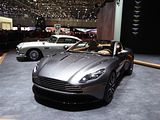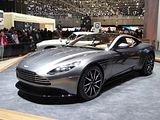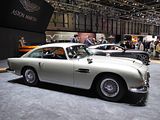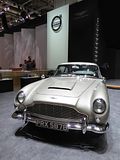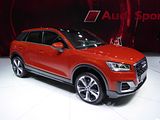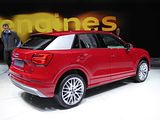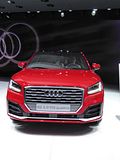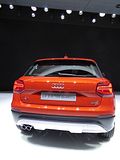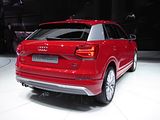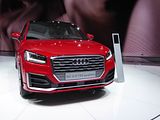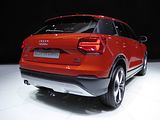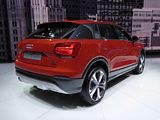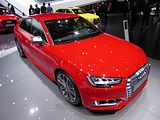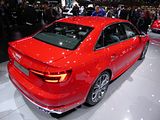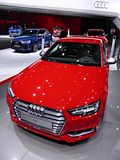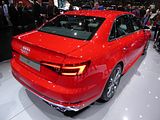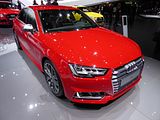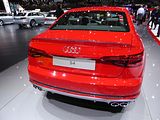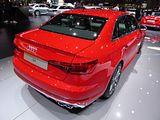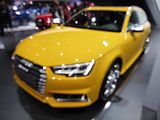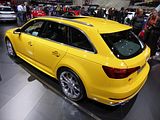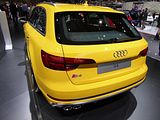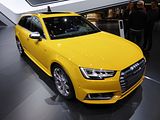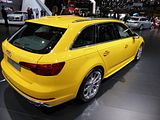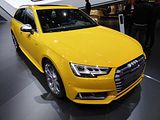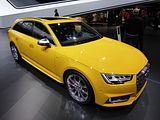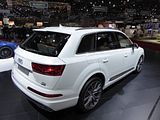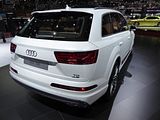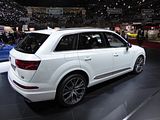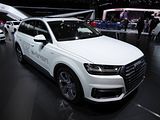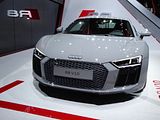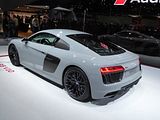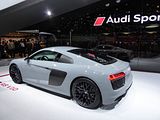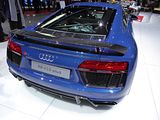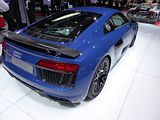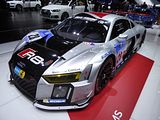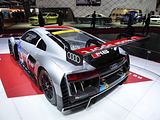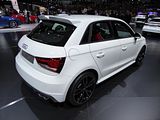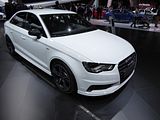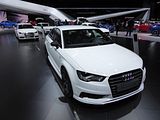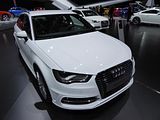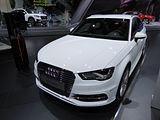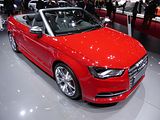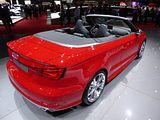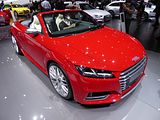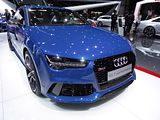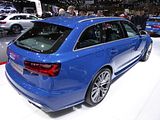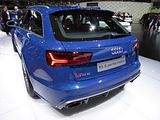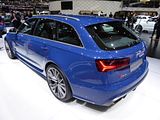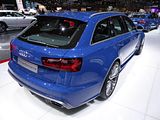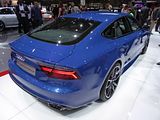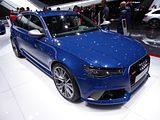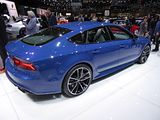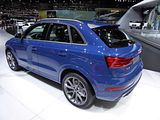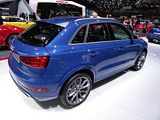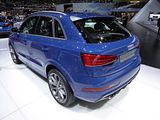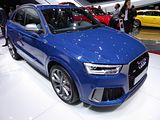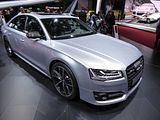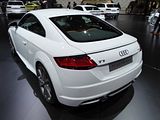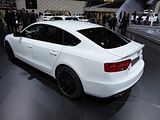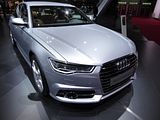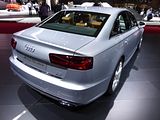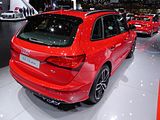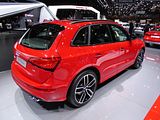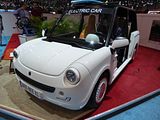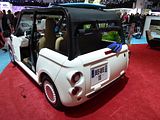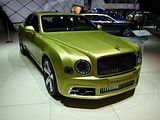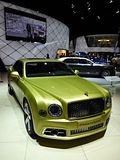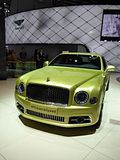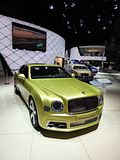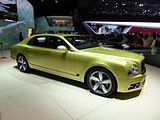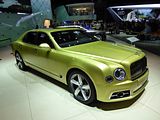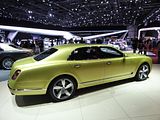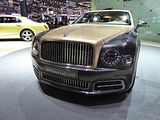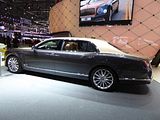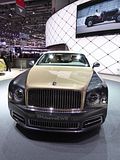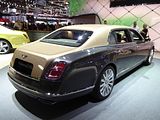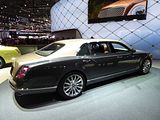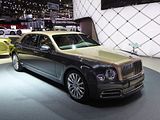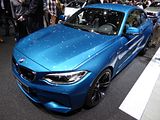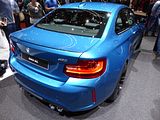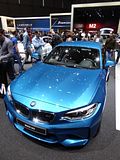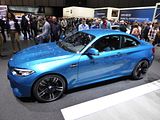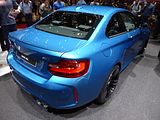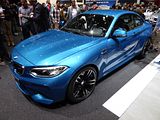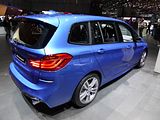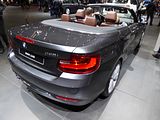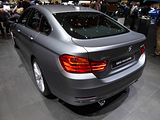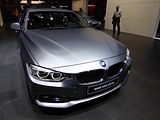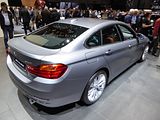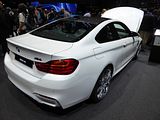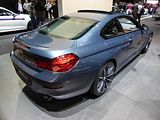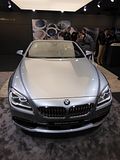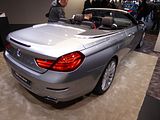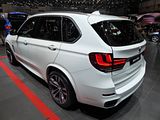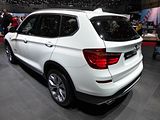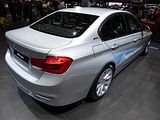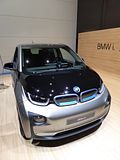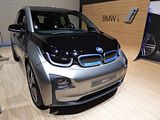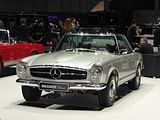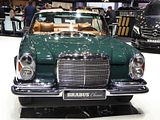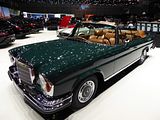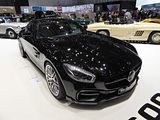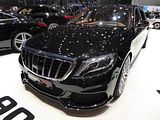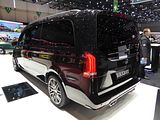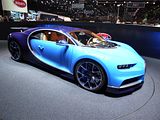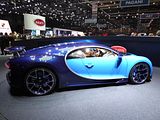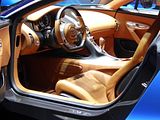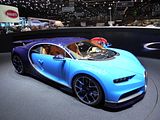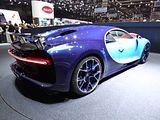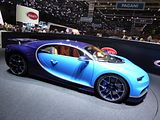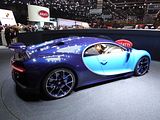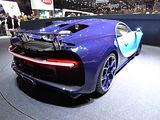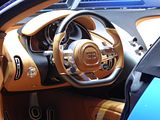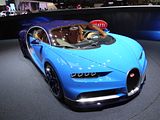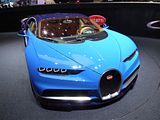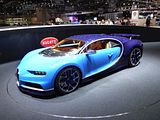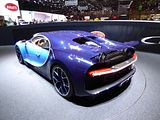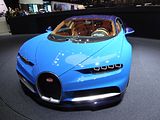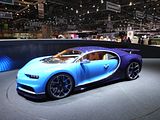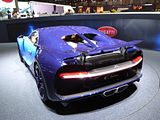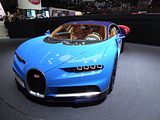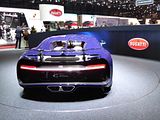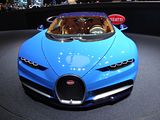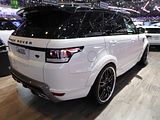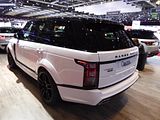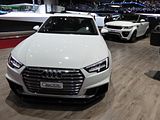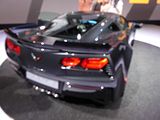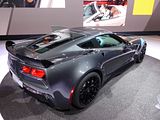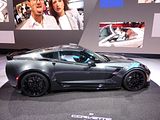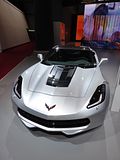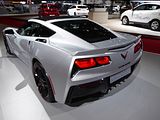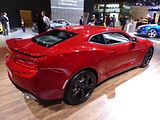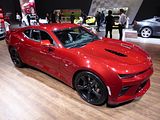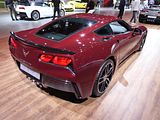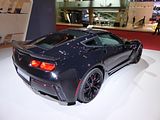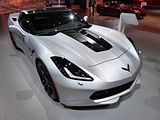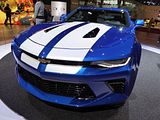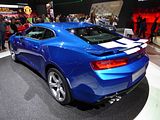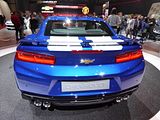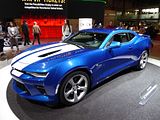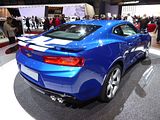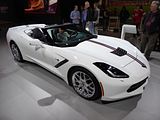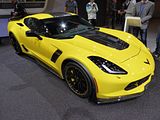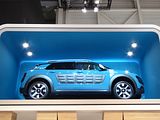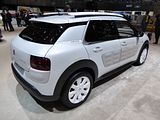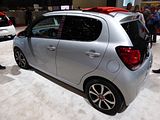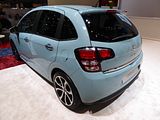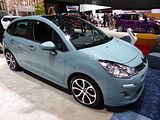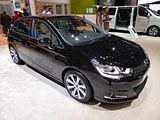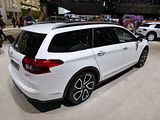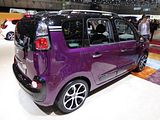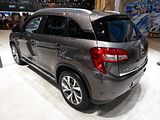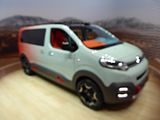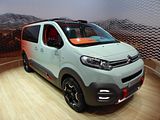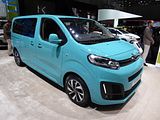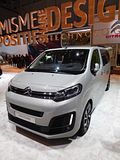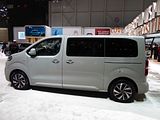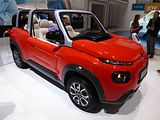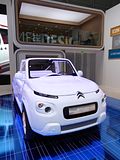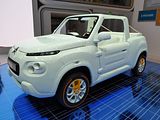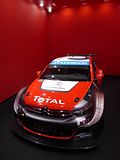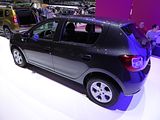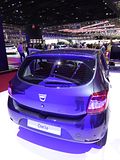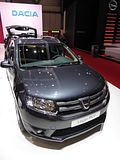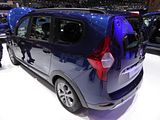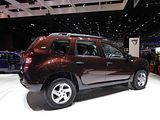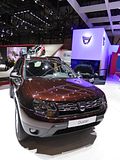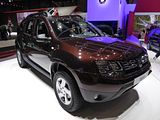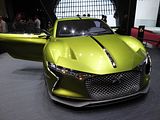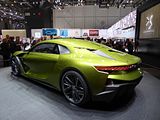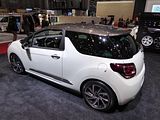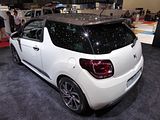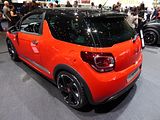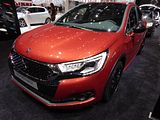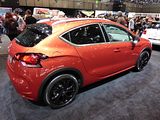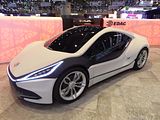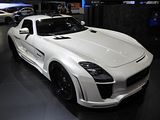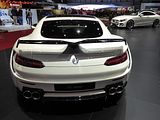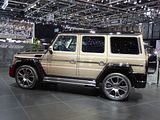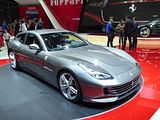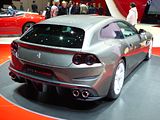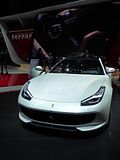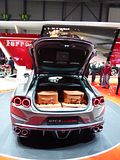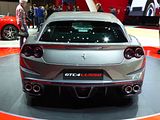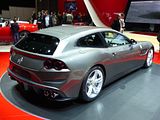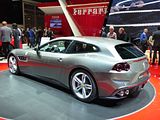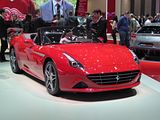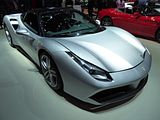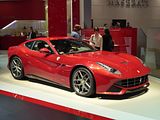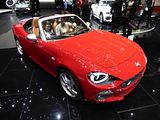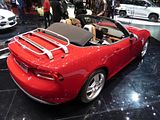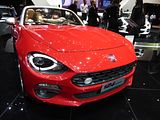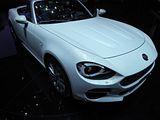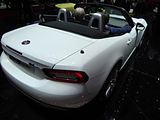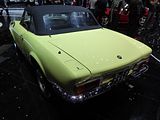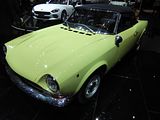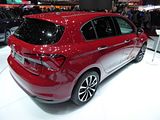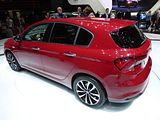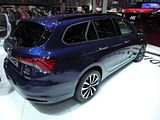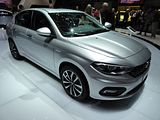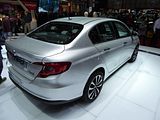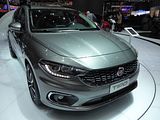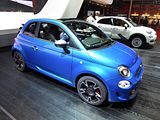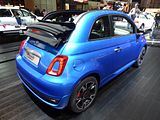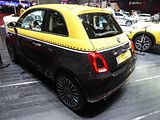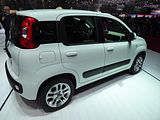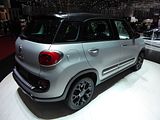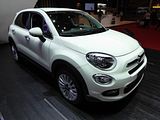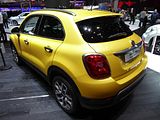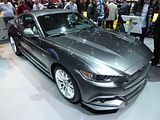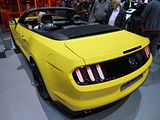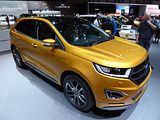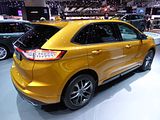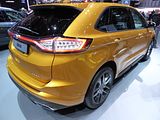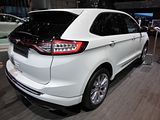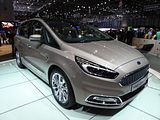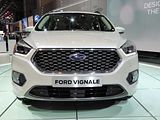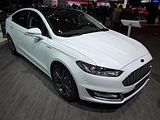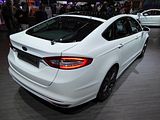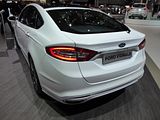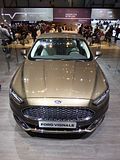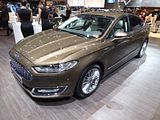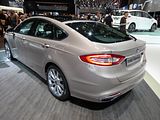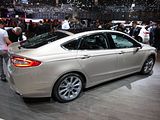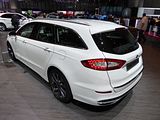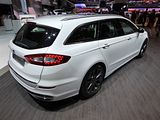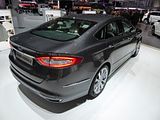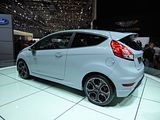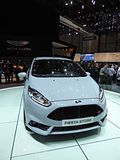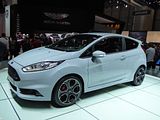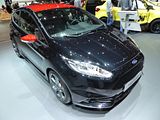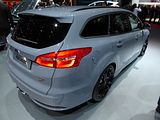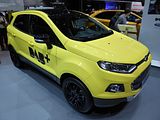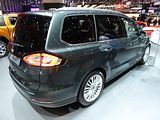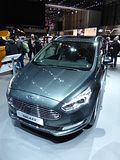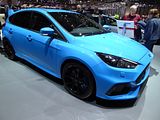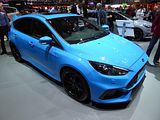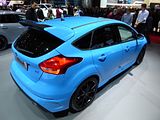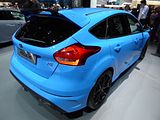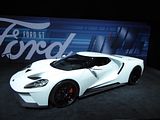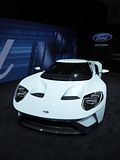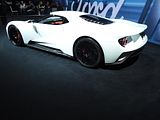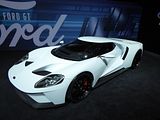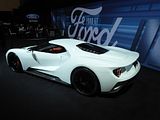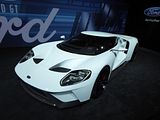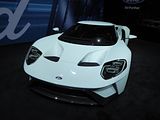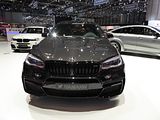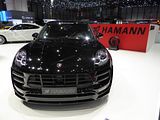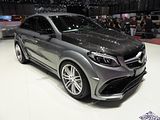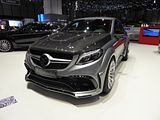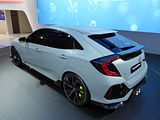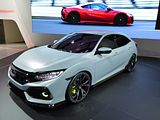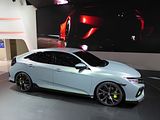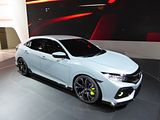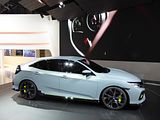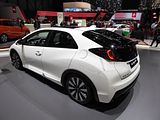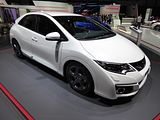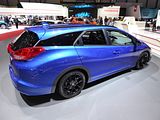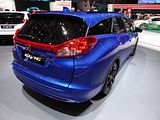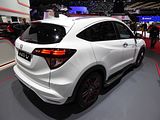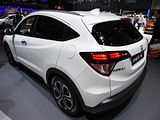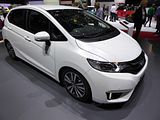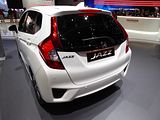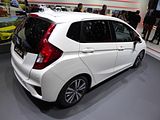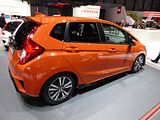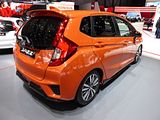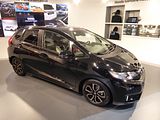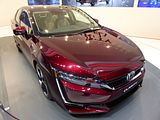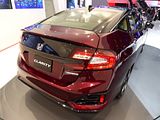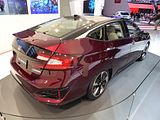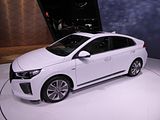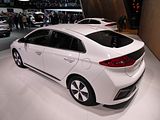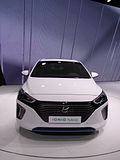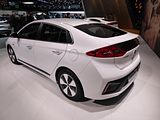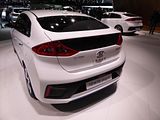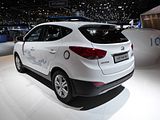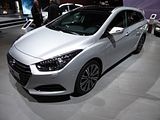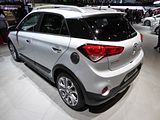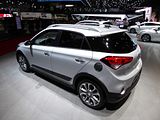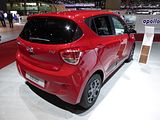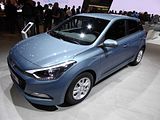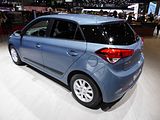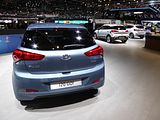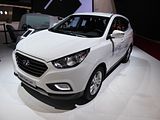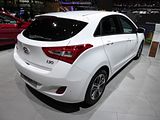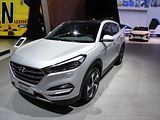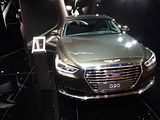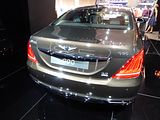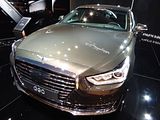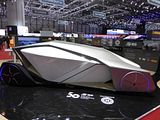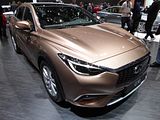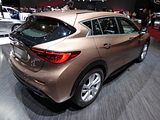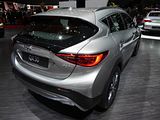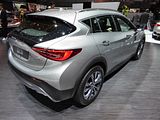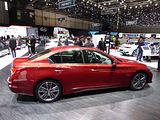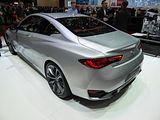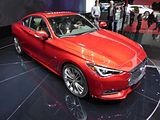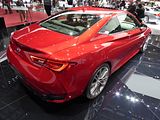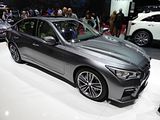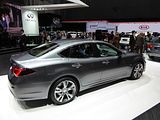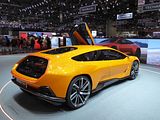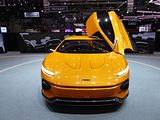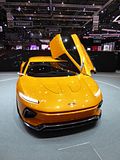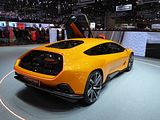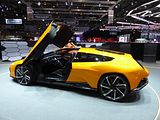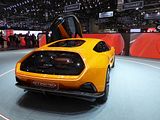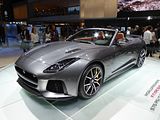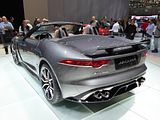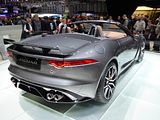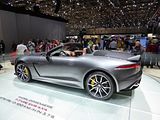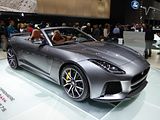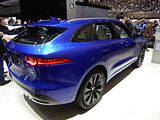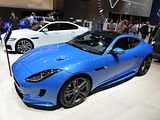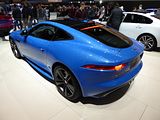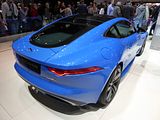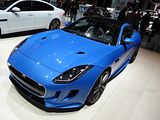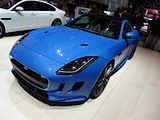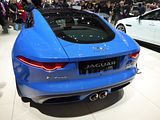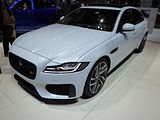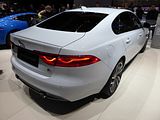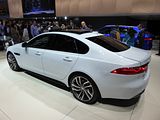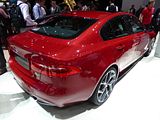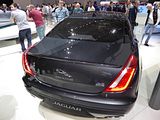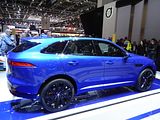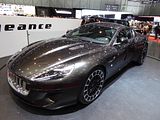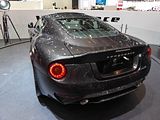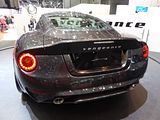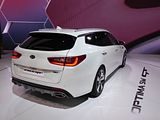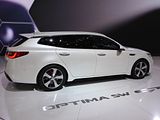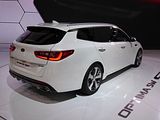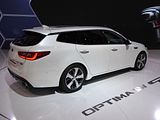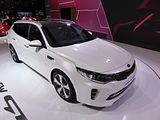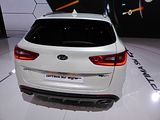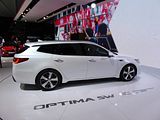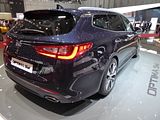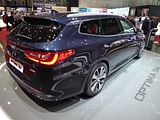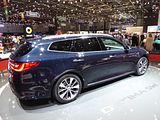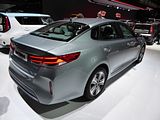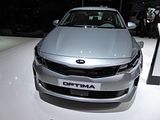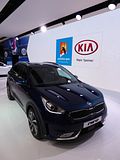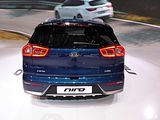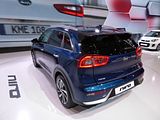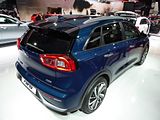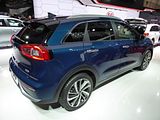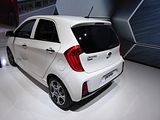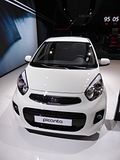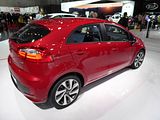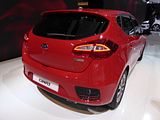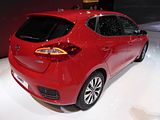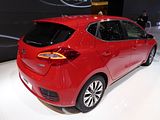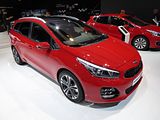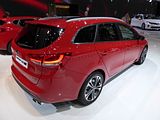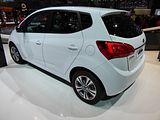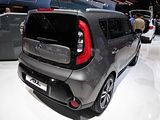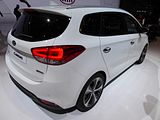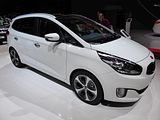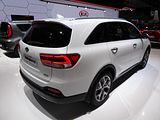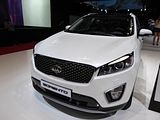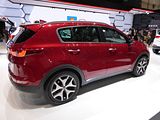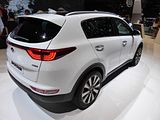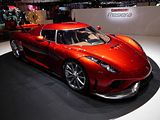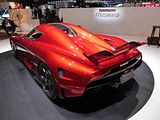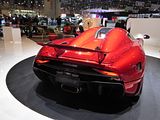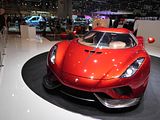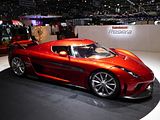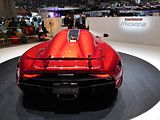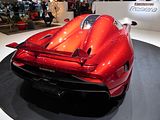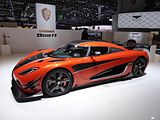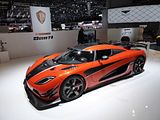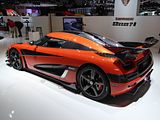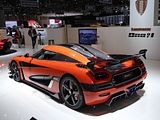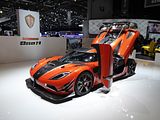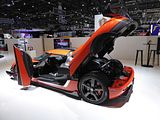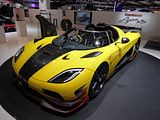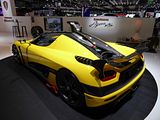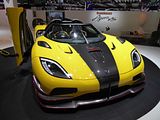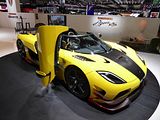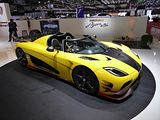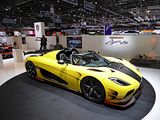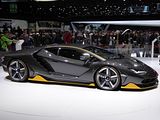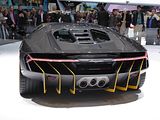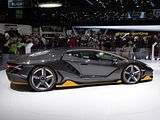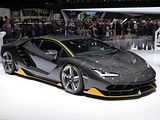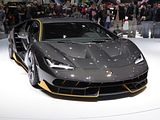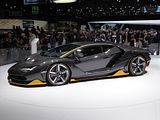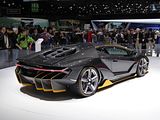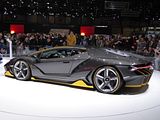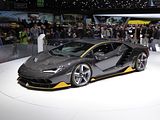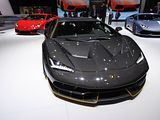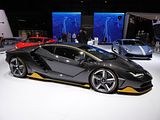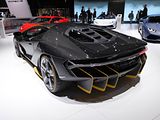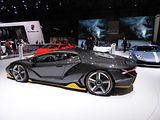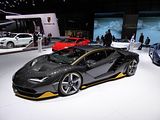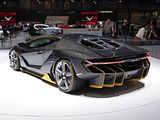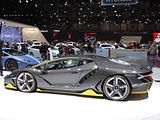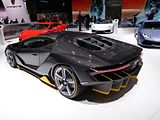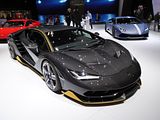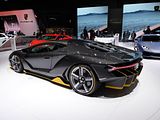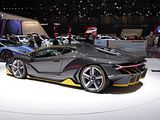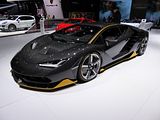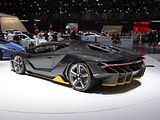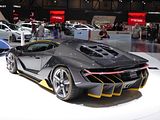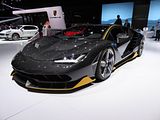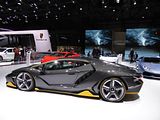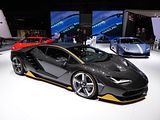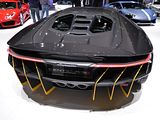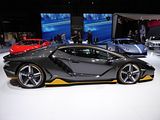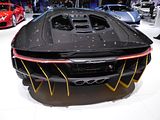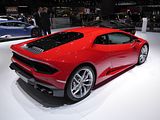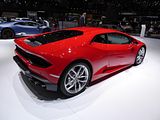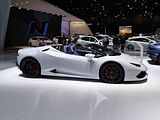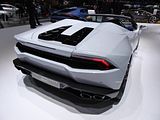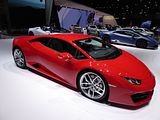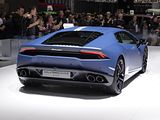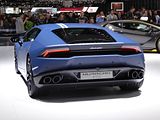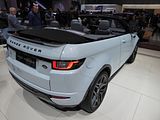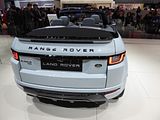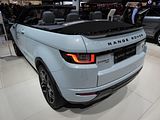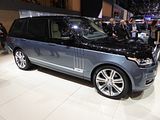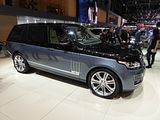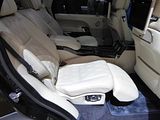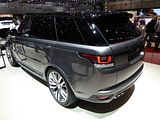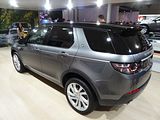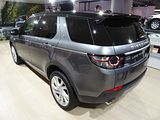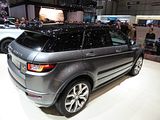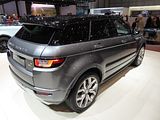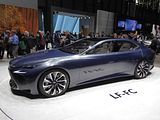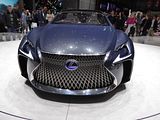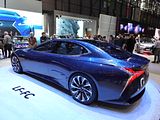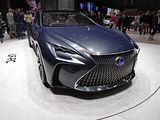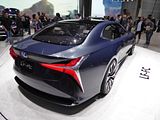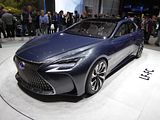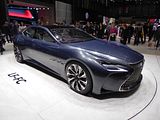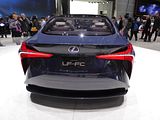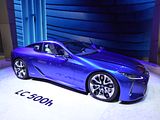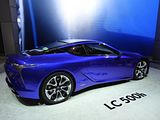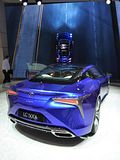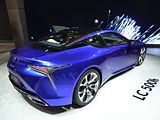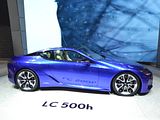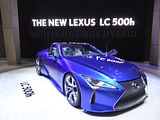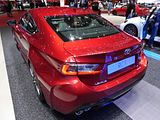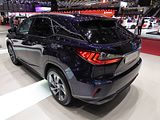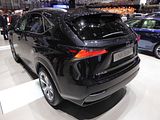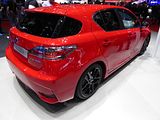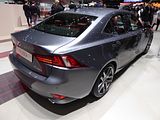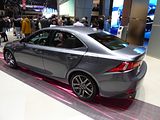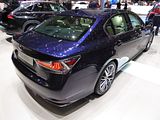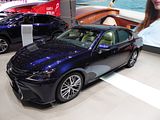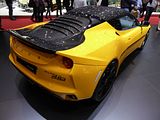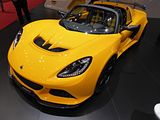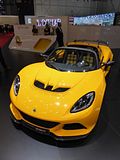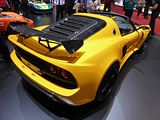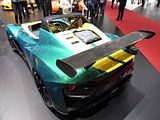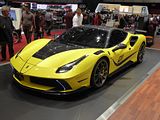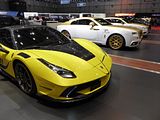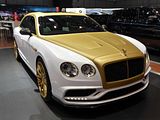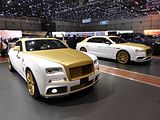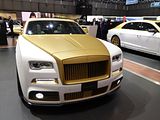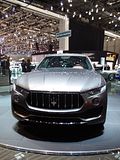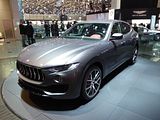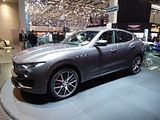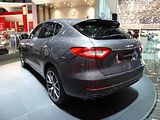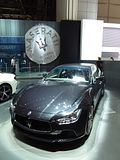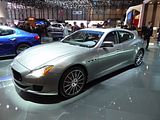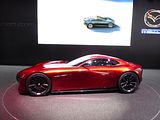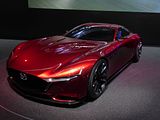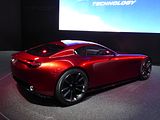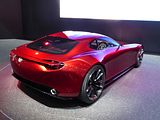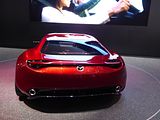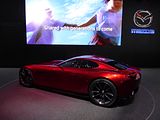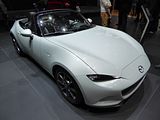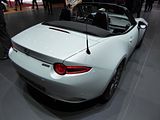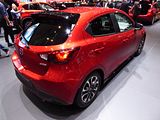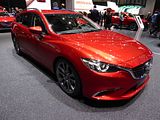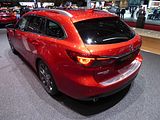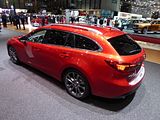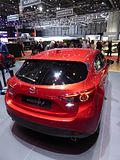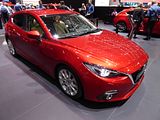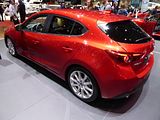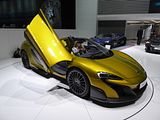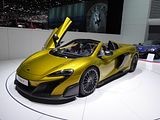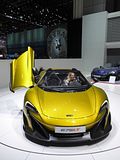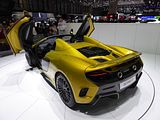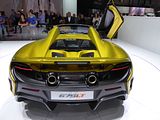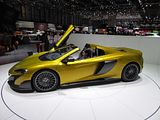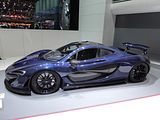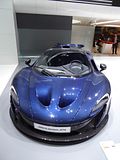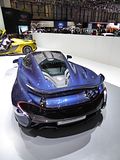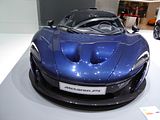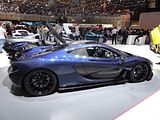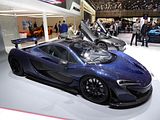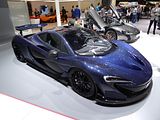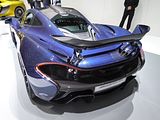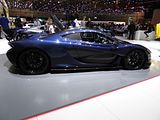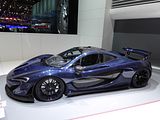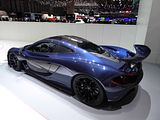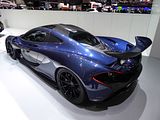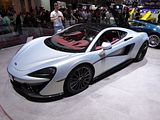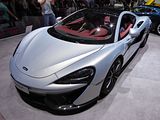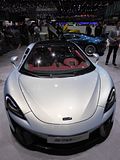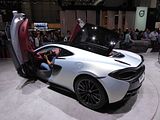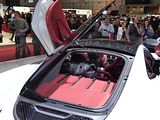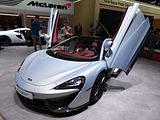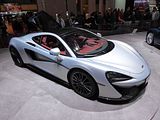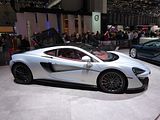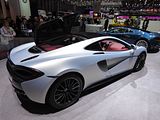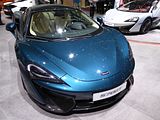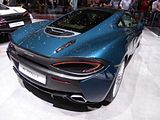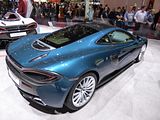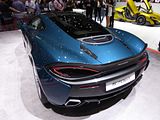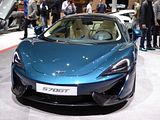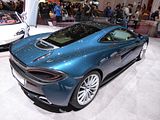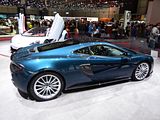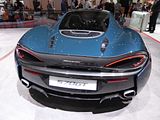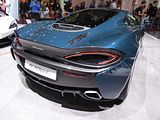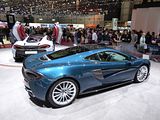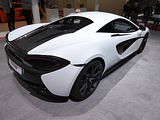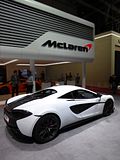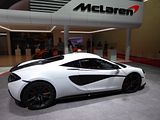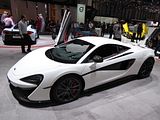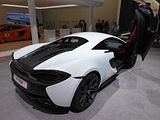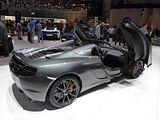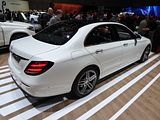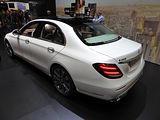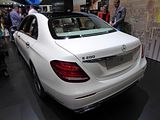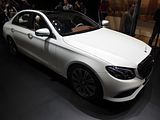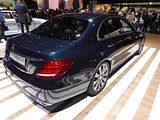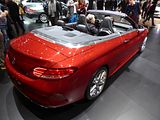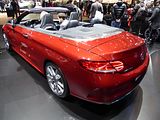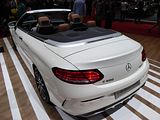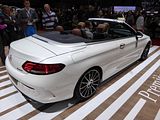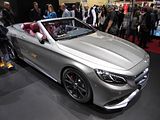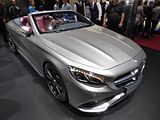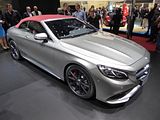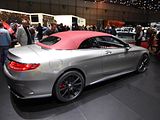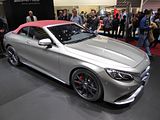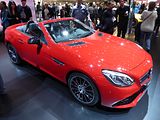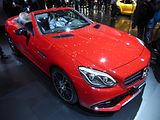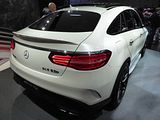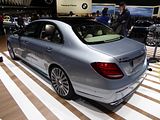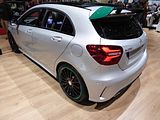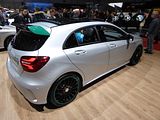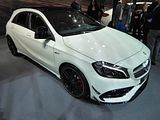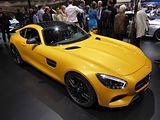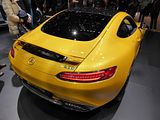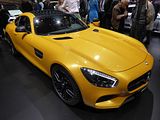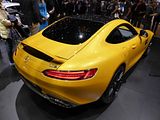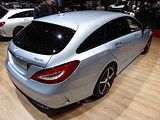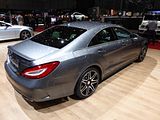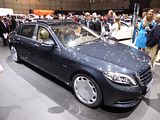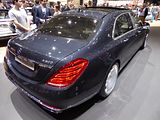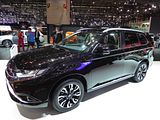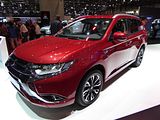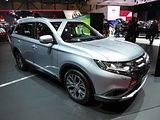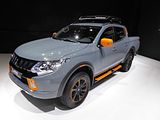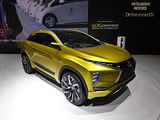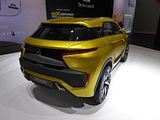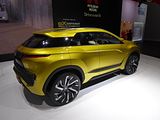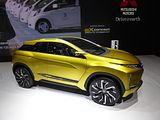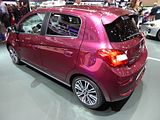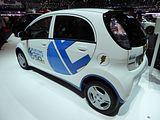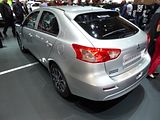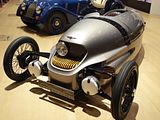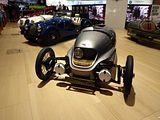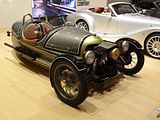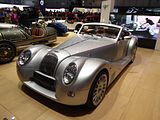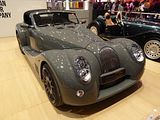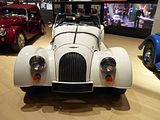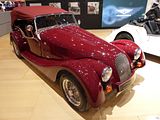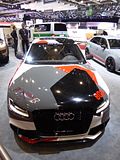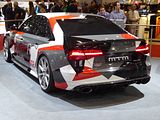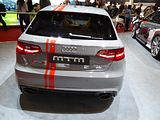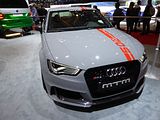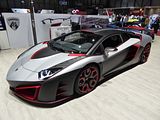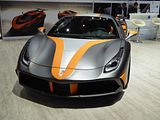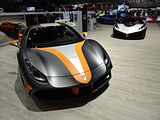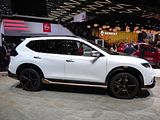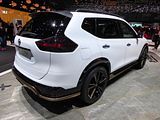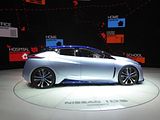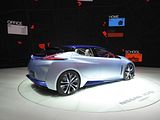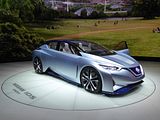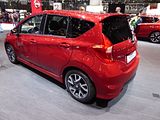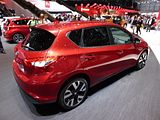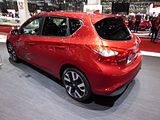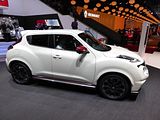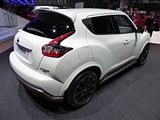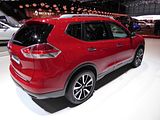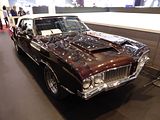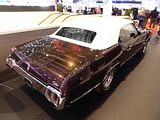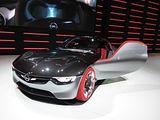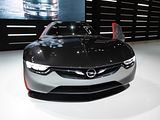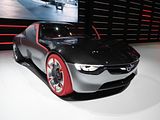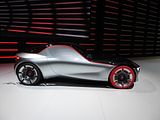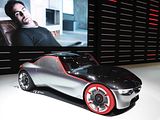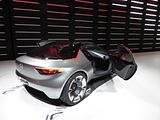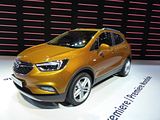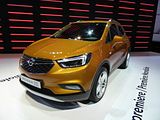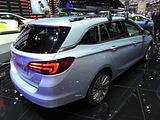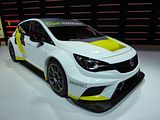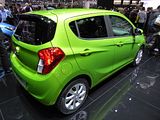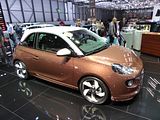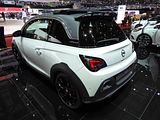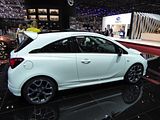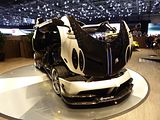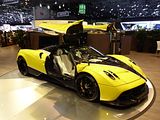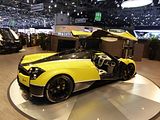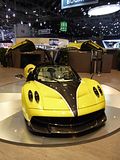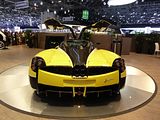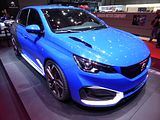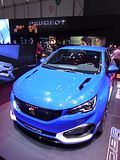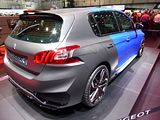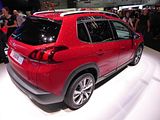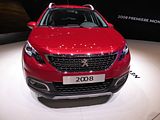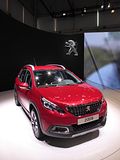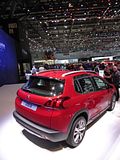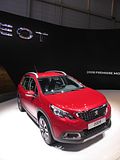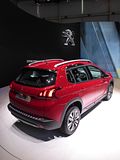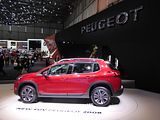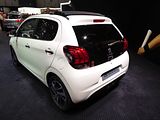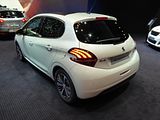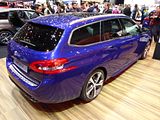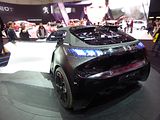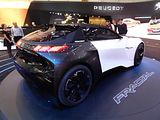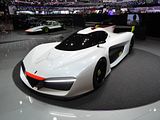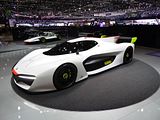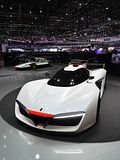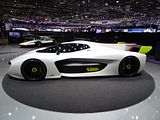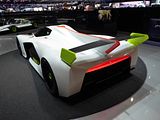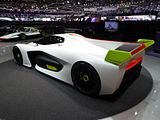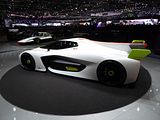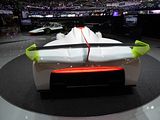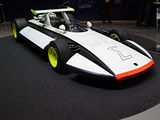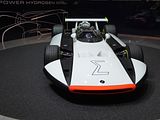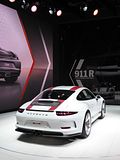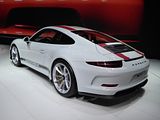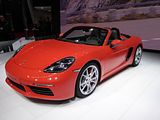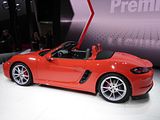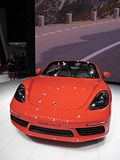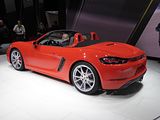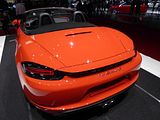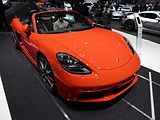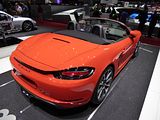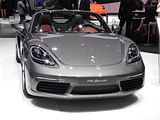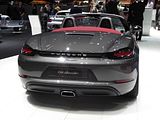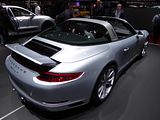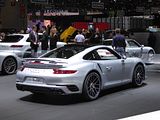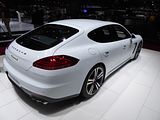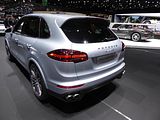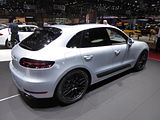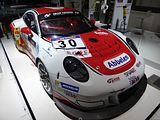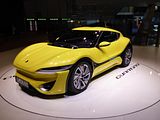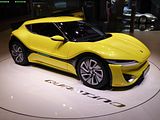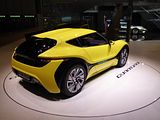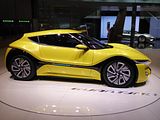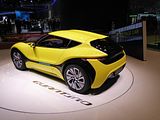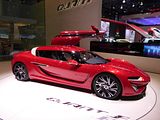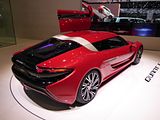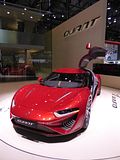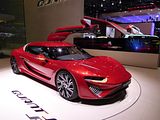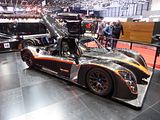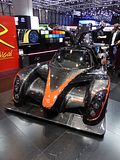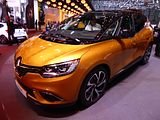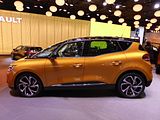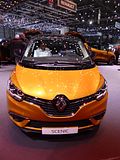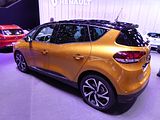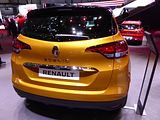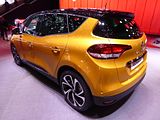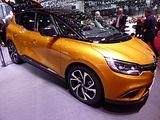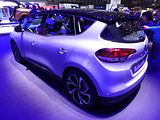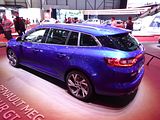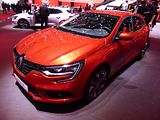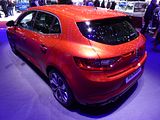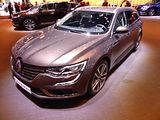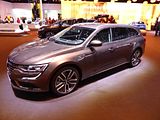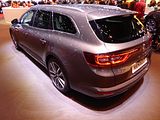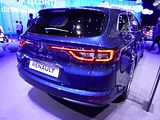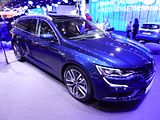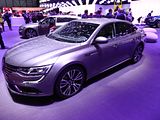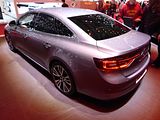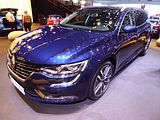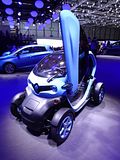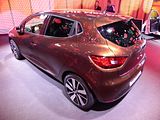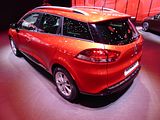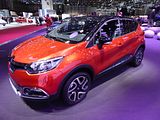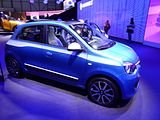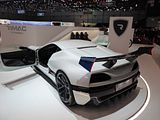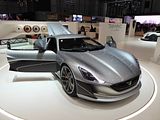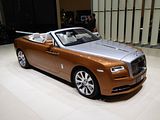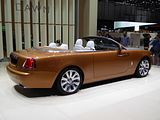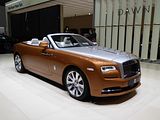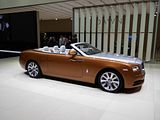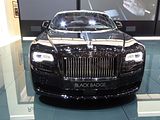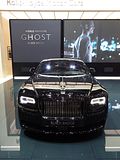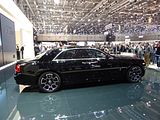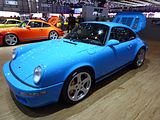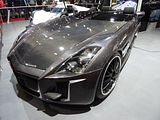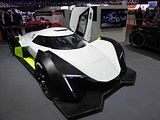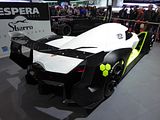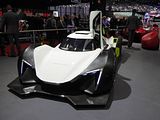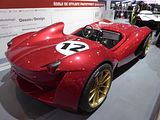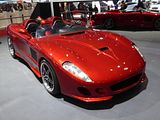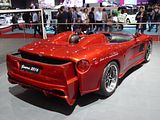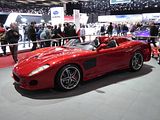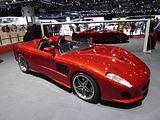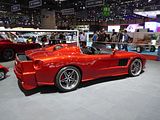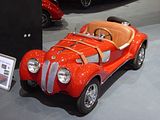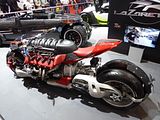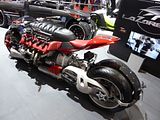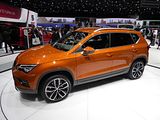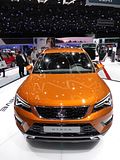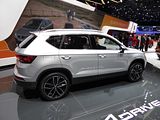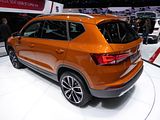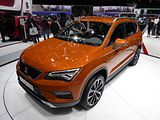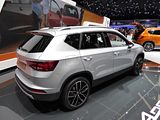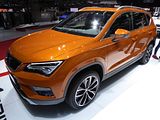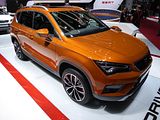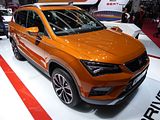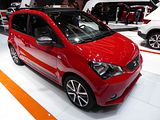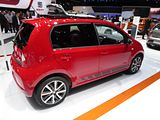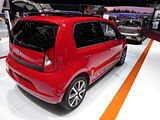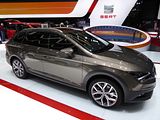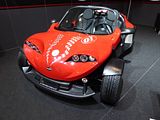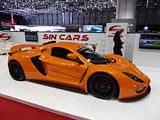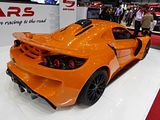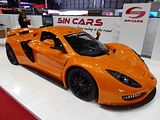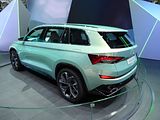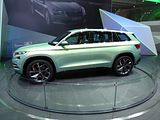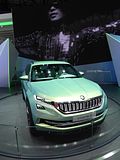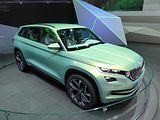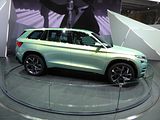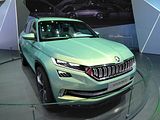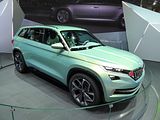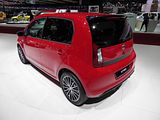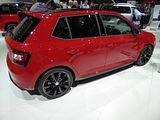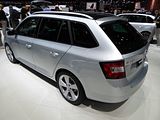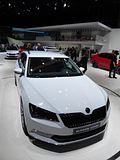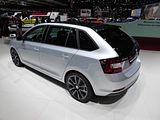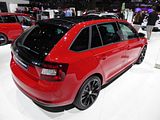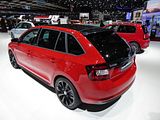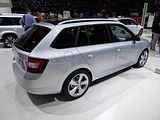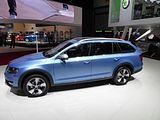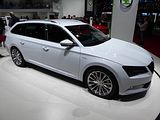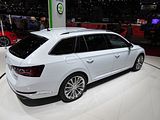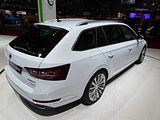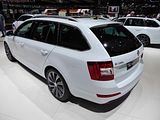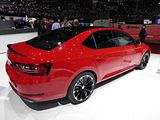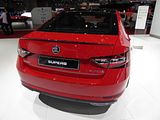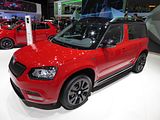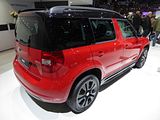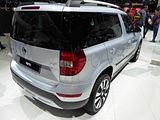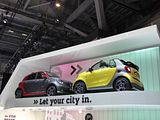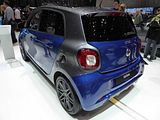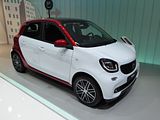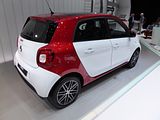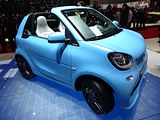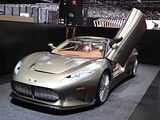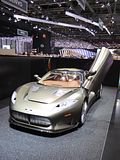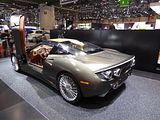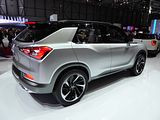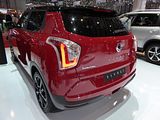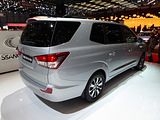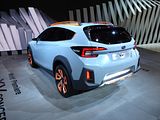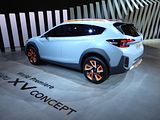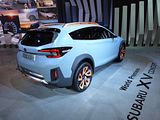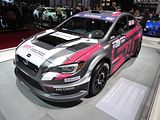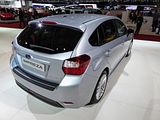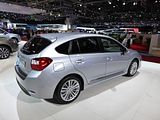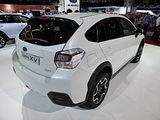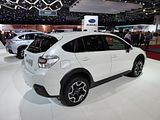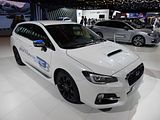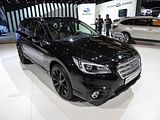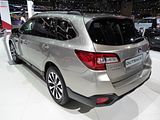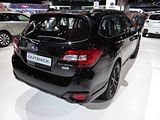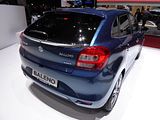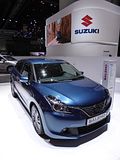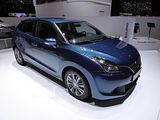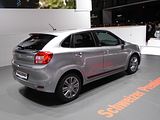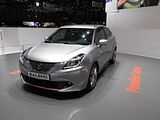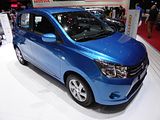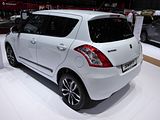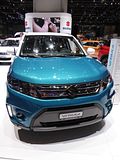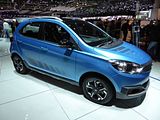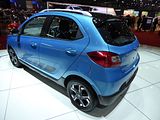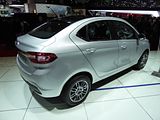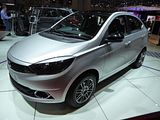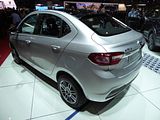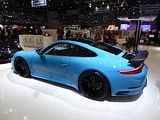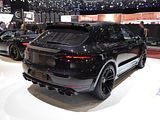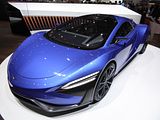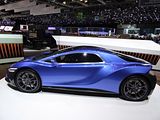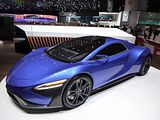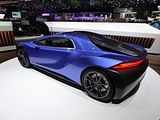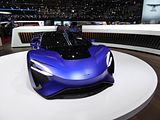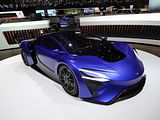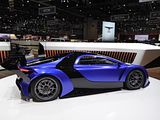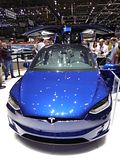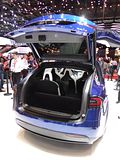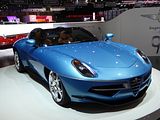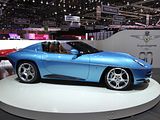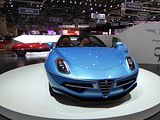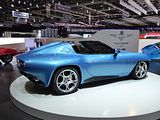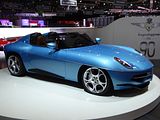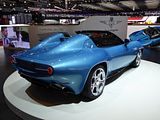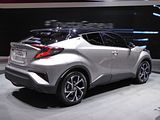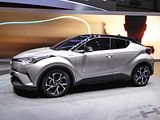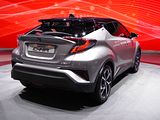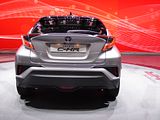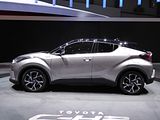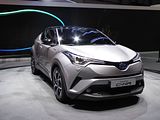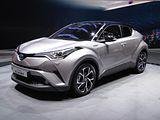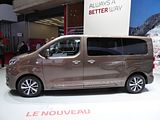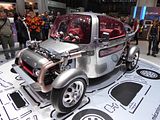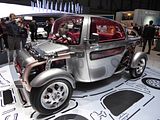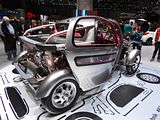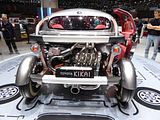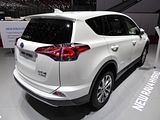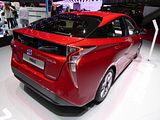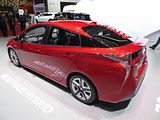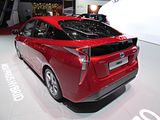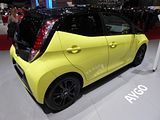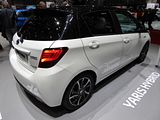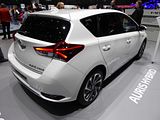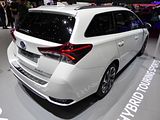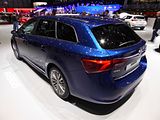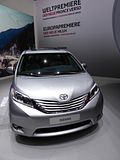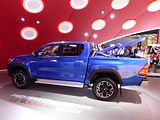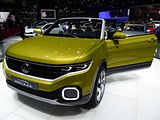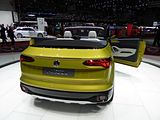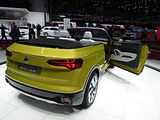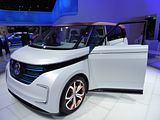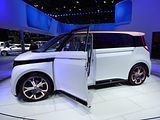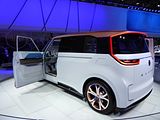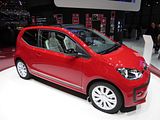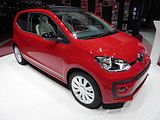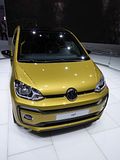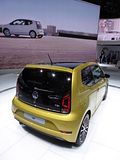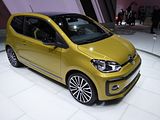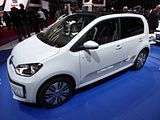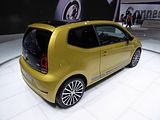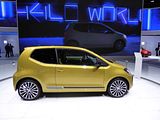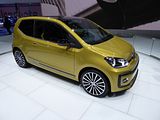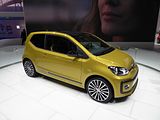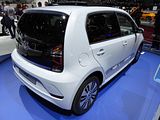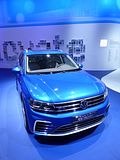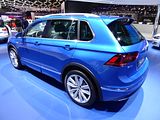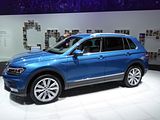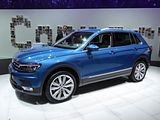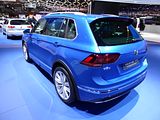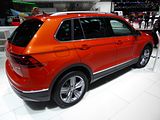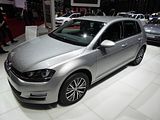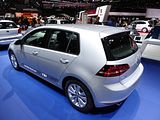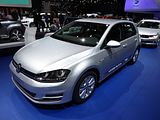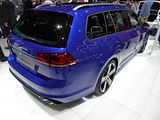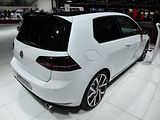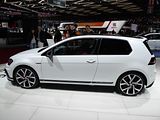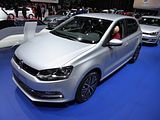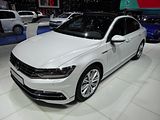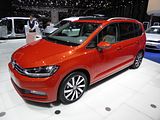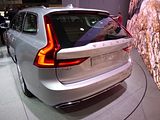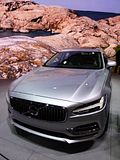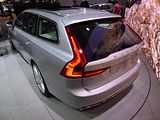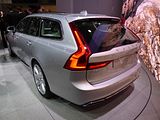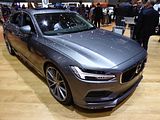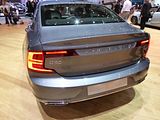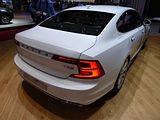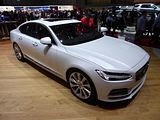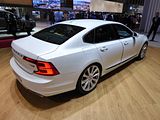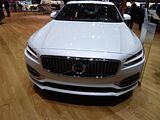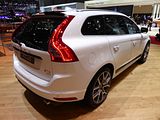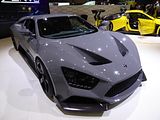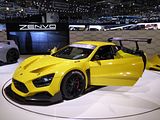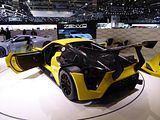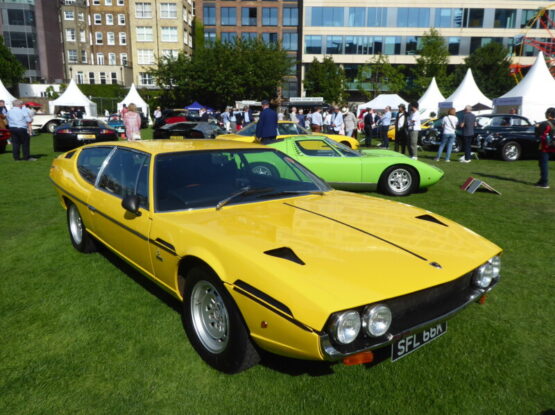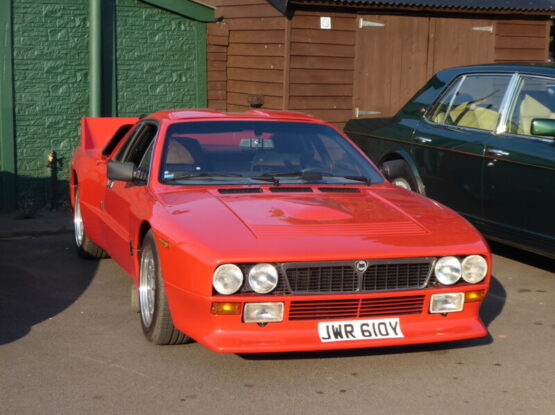There can be few car enthusiasts who fail to enjoy a good Car Show. And make no mistake, the one held in Geneva in early March, as it has been for 86 years now, is always a good Car Show. Indeed, many are the times when it has been better than that. In 2013, with the presentation of numerous concept cars, and the launch of several significant production cars, indicating that the industry was in rude health after the rather bleak post 2008 credit crunch years, the simultaneous premiers of what has become known as the Holy Trinity of hypercars, the LaFerrari, McLaren P1 and Porsche 918 Spyder made for a truly memorable show, which caused many to wonder how any show could ever again achieve hit quite such heights. And yet, the 2014 and 2015 shows proved at least as good, in their different ways. When I first attended this Show, back in 2000, by going on a weekday, there were few crowds, and I was in any case merely travelling across Switzerland from Zurich for a day trip, but such is the rise in the number of low cost flights that Geneva has become ever more popular – and you certainly do hear plenty of native English speakers at the event, among other languages – so planning early is important if you are to get a hotel nearby. Flights and hotels for the 2016 trip were booked in the previous July, as soon as EasyJet released their schedules and at the time, it was too far away to be very sure just what launches could be expected. Such are the levels of rumours and indeed carefully planted leaks by PR departments desperate for every extra milligram of publicity that they can muster, that from 9 months out, it looked as if 2016 would be in the category of Good rather than Great. But then, as so often happens, as the date drew ever closer, news of more and more launches in all sectors of the market came to light, and in the weeks building up to the Show, the announcements started to come at such a rate that keeping up with everything that was going to be displayed, and new, was more or less a full time job. All told, there were over 150 launches, a mix of world premieres, European ones and in a few cases, simply ones for the Swiss market, with over 200 exhibitors from 30 different countries. The stage was set, therefore, for the 86th Auto Salon de Geneve to prove thoroughly diverting for the couple of days that TheMotor.net team of attendees had allocated to it. Was it a Great Show? Well, read through this report, and form your own conclusions.
The Show is held at the PalExpo, an exhibition complex which adjoins Geneva airport. For those arriving by plane, as we all were, you simply walk out of the airport, turn left and keep going. Within 10 minutes, you are at the entrance gate to the show. The nearest entrance will take you in to Hall 7, the one reserved for accessories and components. Better to keep walking and head to the main entrance, which was no hardship as Geneva was bathed in spring weather, with blue skies and sunshine making me wonder if even needed a coat. You certainly do not, once inside, as it gets very warm indeed in the halls. Even before you get outdoors, though there are a few display cars in the airport concours, and we paused briefly, to see each of these. More detail will follow in the alphabetic report below.
This Chevrolet 3100 truck, which I recall seeing last year as well, was associated with a well known brand of Swiss chocolate.
There was not time to go into the city to see some of the more exotic cars that you often find on the streets of this affluent place, but when we emerged from our hotel on the second morning, there was a Mercedes-McLaren SLR convertible parked up outside. The U suffix on the plate means that it is currently a dealer car, and there was a Russian toll sticker on the windscreen, we noticed, so the car has clearly had a much travelled existence.
Nice taster though these were, it was the main displays that we had come to see. There are copious supplies of free Show Guides available, in at least 4 languages, but once you’ve been a couple of times, you realise that little changes in layout terms from year to year. About the only significant difference for 2016 was that McLaren had moved from a position in Hall 1, and almost the first stand we have typically come to, to one in Hall 5, adjoining Rolls-Royce. Notable absentees were MINI who announced that they are only going to attend a limited number of shows in 2016 (and this was not one of them) as well as Lancia and after-market specialist Carlsson. Otherwise, all was in place as we expected, ready for a detailed inspection.
ABARTH
No surprise that this was a stand that I particularly wanted to see, as the long awaited Abarth version of the joint venture with Mazda was finally unveiled just in time for the car to star on the stand. Reaction on the Abarth Owners Club forum and Facebook pages has been mixed, with some expressing surprise and disappointment at the choice of engine (a 1.4 litre Turbo Multi Air) and the pricing (on the steep side, I have to say!), whereas others are salivating at the prospect of an open topped product from the brand they love. Due to go on sale in Europe in September, priced from €40,000 (around £31,000), the performance-focused version of the Fiat 124 Spider has been developed with the Abarth Racing Team and gets more aggressive styling with a matte black bonnet, 170bhp and a limited-slip differential. It’s powered by a tweaked version of parent brand Fiat’s four-cylinder 1.4-litre MultiAir II engine, punching out 170bhp and 184b ft of torque, paired to a six-speed short-throw manual or six-speed automatic gearbox with paddle shifters, and includes a “Sport” driving mode. Abarth claims a 0-62mph time of 6.8sec and a top speed of 143mph, and the “Record Monza” exhaust system comes equipped as standard. The car will be a rival to the Mazda MX-5 which, with a list price of £24,295 for its top-spec 2.0-litre engine, undercuts the 124 Spider by some way. However, the quoted performance figures for the Abarth beat those of the 158bhp MX-5, which has a 0-62mph time of 7.3sec and a top speed of 133mph. The two-seat, rear-wheel-drive Abarth 124 Spider weighs 1060kg and has a 50/50 weight distribution, according to the manufacturer, which also says it has a class-leading power-to-weight ratio. Suspension and damping has been tweaked from the Fiat 124, with the Abarth version getting double-wishbone front suspension and five-link set up for the rear, which the Italian manufacturer says has been tuned to offer greater braking and cornering stability. It also gets front aluminium calipers. Inside, the interior is clad in Alcantara. Standard equipment includes climate control and cruise control, while a 7.0in infotainment system with DAB, sat-nav, Bluetooth and reversing camera can are counted among the optional extras. I grabbed the chance to sit in one, once the stand had recovered from the onslaught of others who wanted to do the same. The driving position felt spot on for me. Let’s hope that it is as good once underway as it felt sitting in it on the stand. Early indications are that it should do.
As well as the road-going car, Abarth confirmed its return to rallying with a motorsport-prepared version of the new 124 Spider, showing a prototype version of the hard-topped 124 Rally developed by the Abarth Racing Team. The manufacturer said this car, as well as the road car were developed in tandem. The rally car was given the internal project code SE139, with ‘SE’ standing for ‘Sports’ and ‘Experimental’. It has been unveiled some 40 years after the original Fiat 124 Abarth Rallye appeared on the special stages of the Monte Carlo Rally. Built to the FIA’s R-GT rulebook, the new rear-wheel-drive Abarth 124 Rally is powered by an 1800cc turbocharged engine which has been remapped to deliver 296bhp at 6500rpm. The torque output hasn’t been revealed, but Abarth said it is “optimum to allow the driver steering and acceleration balance while oversteering”. The engine is coupled to a six-speed sequential gearbox with shift paddles and the car is also equipped with a mechanical limited-slip differential. The Abarth Racing Team engineers focused on reducing the weight and enhancing the overall balance of the competition car, as well as installing the rollcage necessary for rallying. The engine is mounted behind the front axle; lightweight, resistant materials are used in the cockpit and engine compartment and the production car’s soft top has been replaced by a fixed composite hard top. Weight distribution leans slightly towards the rear axle, which Abarth said “ensures maximum traction even in low grip conditions”. The centre of gravity has been further lowered compared to the road car’s. The front-end double wishbone suspension and multi-link rear suspension have been uprated for competition, and four—way adjustable dampers from the Ext Shock company have been fitted. Assisting Abarth with the creation of the car were Petronas Selenia (lubricants and engine development), Adler Pelzer Group (composite components), Michelin (tyres), Sabelt (bucket-seats, seatbelts and other safety equipment), LM Gianetti (bodywork and suspension), BMC (air intake), OZ (wheels) and Alcantara (interior trim). Abarth will build examples of the 124 Rally for customer rally teams, and has opened the order books now. The Abarth 124 Rally will be eligible for the FIA R-GT Cup, a tarmac-based rally series which was dominated by Porsche 911 GT3s last year.
Until close to show opening time, it was widely expected that the facelifted 595 would also be making its debut here, but for whatever reason, it did not. That meant that Abarth showed two examples of the car in the form that you can buy right now. A Competizione in black looked good at one end of the stand and at the other was one of the 695 Record cars, a limited run of just 133 cars, all finished in a very appealing bright yellow.
ABT
First (alphabetically) of many tuners and customisers that you always come across at Geneva, ABT focus on Audi products. Their latest offering took a standard RS6 Avant and transformed it into an even more powerful machine. Named the ABT RS6, the model celebrates the company’s 120th anniversary with 175 PS more than the standard car, a total of 735 PS and 920 Nm (679lb-ft) of torque, achieved with a specially developed Engine Control unit and a special software. Zero to 100 km/h (62 mph) time has not been announced, but the tuner claims the upgraded RS6 can go up to a top speed of 320 km/h (199mph). Setting it apart from its regular siblings is a new aerodynamic package, which adds carbon fibre exposed air inlet panels, front flics, side mirror caps and rear skirt, on top of the rear spoiler, made from the same lightweight material. Since there will be just 12 examples of ABT’s special RS6 produced, a “1/12” logo will complement its design, along with the four tailpipes, painted in a matching colour, and the 10×22-inch ABT FR wheels, with a five-double spoke design, wrapped in 295/25 Dunlop performance tyres. Inside, the car benefits from sports seats in bi-colour leather, matching the exterior, and it has Alcantara-wrapped headliner, pillars and tailgate. A combination of leather and Alcantara was added on the dashboard, door panels and steering wheel.
ABT were debuting their version of the second generation Audi Q7. Their car can be built upon both petrol or diesel versions. The most dramatic part of the package is ABT’s bodykit which consists of a wide-body aero enhancements. It includes a front skirt, wing extensions, door strip attachments and a rear skirt set. ABT also fit a characteristic angular four-pipe exhaust system. If the wide body version is too much for you, the ABT QS7 is available as a narrow-body version, with no wing extensions, a special rear spoiler and bumper inserts. ABT have fettled the 3 litre TFSI, boosting power by 77 hp for a total of 410 hp. ABT also off tuning for diesel engines including the 3 litre turbocharged Q7 which gets 325 hp, up from 272 hp. Both power gains are realised through the use of ABT’s chip tuning technology. The ABT Audi QS7 gets lower suspension and a new set of ABT Sportsline wheels. Wheel options available to customers include CR, DR or FR in 20 or 22 inches. Tthe car pictured features FR design wheels measuring 10 x 22’’ with 305/30 R22 tyres. Plenty of interior upgrades are also available too including floor mats, boot mats and entrance lights.
Also making its first appearance was ABT’s conversion of the latest B9 generation of Audi A4. Badged the ‘ABT AS4′, power and torque of the 3.0-liter turbocharged diesel engine increase to 325 hp and 680 Nm from 272 hp and 600 Nm respectively To help the AS4 put its power perfectly on the black top, ABT has also equipped it with the unobtrusively racy Avant height adjustable suspension springs. Furthermore, there’s also a customised aerodynamics package, which includes a new front skirt, a front grille, fender inserts and a rear skirt set with the characteristic four-pipe exhaust pipes. Finally, customers will get options for 19- or 20-inch custom wheels, which can be bought in combination with high-performance tyres.
Also on show were ABT modifications to the latest VW Caravelle T6 and a Formula E racing car.
AC SCHNITZER
This firm takes regular BMW models and, erm, modifies them. The results are almost always eye catching, though not necessarily in a good way. This year there were two cars on the stand and the distinctive green paint meant you would be unlikely to miss at least one of them. It is the new ACL2, a concept which aims to outdo the BMW M2. To out-muscle the latest M car, the German tuner starts with an M235i and installs the M4’s 3.0-litre inline-six. The company also turns up the power to 570 horsepower – a healthy upgrade over 365 hp from the M2’s 3.0-litre. The power bump lets the ACL2 reach 62 miles per hour in 3.9 seconds and hit a top speed of 205 miles per hour, AC Schnitzer claims. Those figures make the coupe a few tenths quicker than the M2’s 4.2-second to 60 mph sprint, but BMW limits its creation to 155 mph. AC Schnitzer’s long list of upgrades makes the impressive performance possible. To get the most out of the engine, the company installs a carbon fibre intake. It also replaces most of the exhaust, including the downpipe, catalytic converter and tailpipes. Carbon-ceramic brake discs make sure a driver can control so much power, and the company fits a fully adjustable suspension to aid handling. The ACL2’s body is too loud for my tastes even through the subdued dark green paint, but the extensive use of carbon fibre parts should keep weight down. AC Schnitzer adds a road-scraping front splitter with canards at each corner. The rear has a similarly aggressive diffuser and huge wing. The wider fenders also add 5.5 inches to the coupe’s width, and 20-inch wheels sit underneath them. The ACL2 doesn’t get to challenge the M2 on the Autobahn yet because AC Schnitzer says it’s just a concept. The coupe exists simply for the company’s product development. However, if you want to put all of these bits together, the final cost would be €149,000 euros, so not exactly cheap. You could have a real M2 and plenty else besides for that money.
The second model on the stand was the X6-based AC Schnitzer Falcon which shocked the crowds when it was shown at Essen. The ostentatious Bavarian mid-size luxury crossover is a vulgar machine in its own right, and AC Schnitzer’s customisation program doesn’t make it appear less flashy. Offering various technical and visual upgrades for the SAC, the tuning company managed to transform it into an impressive, beefy sporty vehicle, with every engine option delivering well over its stock output. The 30d variant, for instance, remains the least powerful of the bunch, although it now produces 309 PS instead of 258, leaving the competition in the dust (at least according to AC Schnitzer). Moreover, the m50d variant received a 49 PS bump over the already hefty 381 PS output, while the M variant went from 575 PS to an eye-watering 650 PS. All this grunt is wrapped in an aggressive visual-package, composed of ten pieces, tailored to emphasise the vehicle’s potent mechanical characteristics, widened by 50 mm in the front and 90 mm widened in the rear. Lowered by a noticeable amount by the AC Schnitzer suspension spring set, the Falcon provides additional precision and control. Additional stability is offered by a selection of 20 and 22-inch weight-optimised alloy wheels.
ALFA ROMEO
Perhaps the most eagerly awaited car of the whole show was the unveiling of the rest of the Giulia range. Alfa Romeo tantalised us with the Ferrari-derived 3 litre V6 500 bhp Qv version last summer, but that model, an M3 competitor, is destined to be a costly and hence a rare sighting. It is the rest of the range which needs to deliver the sales that are so essential for ensuring that Alfa Romeo has a future, and they were finally making their debuts after months of waiting . There were three examples on display across the back of the stand, as well as a Qv at the front of the stand, and it is no exaggeration to say that they were being mobbed for most of the day. with lots of people eager to see just what this important rival to the Mercedes-Benz C-Class, BMW 3 Series, Audi A4 and Jaguar XE rival has to offer. Besides the Quadrifoglio model, three engines will be available in the Giulia. These are a 197bhp /243lb ft turbocharged 2.0-litre petrol, which is coupled to an eight-speed automatic transmission and a pair of 2.2-litre diesels, the most powerful of which produces 178bhp and 332lb ft of torque. It’s capable of emitting less than 100g/km of CO2 in ‘Eco’ specification. The other diesel comes with 148bhp and 280lb ft. Both engines can be had with either a six-speed manual transmission or the eight-speed auto ‘box. All models will be rear-wheel drive as standard, but all-wheel drive will be available on some models. Alfa Romeo says the car has a perfect 50/50 weight distribution, and features multi-link suspension at the rear and double wishbones at the front. The Giulia has an unladen weight of 1374kg in 178bhp 2.2-litre diesel form. Alfa Romeo says that electronic aids on the Giulia are used only to make the driving experience more exciting. For example, the new integrated braking system mixes the traditional stability control setup with a servo brake, reducing weight and vibrations through the pedal. Other safety and assistance systems include autonomous emergency braking, forward collision warning, optional adaptive cruise control and blind spot monitoring. Drivers can choose from three driving modes via Alfa’s DNA drive selector. In addition, range-topping Quadrifoglio models get a Race option. The five-seat cabin features an 8.8in infotainment system, controlled via a rotary pad on the centre console. The system features compatibility for Apple and Android devices, Bluetooth and satellite navigation. Depending on specification, the Giulia gets either a 3.5in or 7.0in colour display as part of the instrument cluster. Buyers can choose from three trim levels, dubbed Giulia, Super and Quadrifoglio, and two packs, dubbed Lusso and Sport – although final UK trim levels and specifications are still being decided. In entry-level Giulia form, the car sits on 16-inch alloy wheels, and receives LED rear lights, a fabric interior, 3.5in TFT driver’s information screen, 6.5in infotainment screen and a leather steering wheel. Super models add 17-inch alloys, twin exhaust pipes and part-leather seats. The Quadrifoglio range-topper gets a far more aggressive look and a large 8.8in infotainment screen. Personalisation packs bring features such as wheel-mounted paddle shifters, keyless entry, front and rear parking sensors and electric front seats. Alfa Romeo says the new Giulia “embodies the core elements which have made Alfa Romeo one of the world’s best-loved automotive brands; distinctive Italian design; innovative powertrains, perfect weight distribution, unique technical solutions and the best weight-to-power ratio”. Alfa has yet to release any pricing for the Giulia, only saying that it will be priced competitively against its rivals. Given that the BMW 3 Series starts at £25,160 and the Audi A4 and Mercedes-Benz C-Class are priced at £25,900 and £27,665 respectively, expect a starting price of around £26,000 for the Giulia. There have been a lot of stories claiming that there have been all sorts of further delays, which Alfa has refuted, merely noting that the car is absolutely new from the ground up and they are determined that it must be right before customers get their hands on it. Production starts on the 15th March, though it is going to be late 2016 before UK buyers can get behind the wheel. Sadly, that is too late for me, looking for a replacement for my Audi, the lease on which runs out in May. Let’s hope. for Alfa’s sake, that there is a waiting list the like of which the brand last saw when the 156 was released.
The Giulia was not the only new car on the stand, even if it was the one getting the lion’s share of the attention, as this was also the first time that the facelifted Giulietta had been seen in public. Headlines of the changes are a light facelift, new trim classifications and the addition of the TCT dual-clutch gearbox as an option for the fuel-sipping 1.6 JTDm engine. Cosmetic changes on the outside are focused on the nose, where there’s a new honeycomb grille, black bumper inserts and very subtle changes to the headlamp and fog light surrounds – all of which bring the Giulietta closer to the styling of the long-awaited Giulia saloon that’s expected towards the end of the year. Inside, updates include new seats and a matte black dash insert. There are seven trim levels available on the Giulietta at present: Progression, Distinctive, Exclusive, Sprint, Business, QV Line and Quadrifoglio Verde. All are replaced in the new range, which references Alfa nameplates of days gone by. The entry-level model is now simply called Giulietta, with Super, Tecnica, Speciale and Veloce above it. All benefit from the newly upgraded Uconnect infotainment system that now includes smartphone integration for online services such as music streaming, news, social media and traffic updates for cars equipped with sat-nav. A leather steering wheel becomes standard, while 16in alloys, Bluetooth, air-con and the Q2 brake-based front differential are carried over from the existing basic kit list. Super trim adds dual-zone climate control, cruise control, front fog lights and upgraded seats, and an optional Lusso pack adds leather upholstery, aluminium kick plates and a larger infotainment screen (up from 5.0in to 6.5in) with sat-nav. The old Business Edition trim is replaced by Tecnica to include practical touches such as sat-nav and front and rear parking sensors, while sporty Speciale brings stiffer suspension, Brembo brakes, aggressive exterior styling touches, 18in alloys, sat-nav and interior embellishments such as leather and Alcantara seats and a flat-bottomed steering wheel. The quickest model, powered by the 237bhp 1750 TB engine from the 4C coupé, becomes the Veloce (Italian for ‘fast’), shedding the Quadrifoglio Verde name that will be reserved for ultra-high-performance models in the Alfa Romeo line-up, such as the 503bhp Giulia super-saloon. The Giulietta Veloce’s kit list is similar to Speciale specification. While the TCT dual-clutch gearbox will become an option on the 118bhp 1.6 JTDm diesel (it’s already optional on the 168bhp 1.4 MultiAir and standard on the 173bhp 2.0 JTDm and 1750 TB), the drivetrain line-up otherwise remains unaltered. This means there are three diesel engines and four petrols in the range – the other units being the 148bhp 2.0 JTDm and 118bhp and 148bhp MultiAir versions of the 1.4. The 1.6 JTDm is the Giulietta’s most popular engine choice in the UK. Paired with the existing manual gearbox, it achieves 74.3mpg combined and emits just 99g/km of CO2. The new dual-clutch version matches these figures, but is 0.2sec slower to 62mph at 10.2sec. Steering wheel-mounted paddles are supplied as standard with the TCT gearbox. The facelifted Giulietta goes on sale on 1 April, with the entry price remaining unchanged at £18,450 for the 118bhp 1.4 petrol in basic Giulietta trim. Pricing for other models is yet to be confirmed, but indications are that adding the TCT gearbox to the 1.6 diesel will cost around £1500, reflecting the premium currently commanded by that transmission.
The MiTo continues for now, although all the reports suggest that it will not be replaced, so fans of this car (and there are more than you might think, judging by the strong presence of the MiTo Owners Club at various events last year) will have to hang onto their cars for a long time. The car on show came with a very mild update which was being premiered here. The changes are mostly cosmetic and include items such as a revised grille and front bumper, plus new badges that resemble the type used on the Giulia. There’s also some revised trim in the cabin, with the range-topping Veloce model getting new bucket seats from Sabelt trimmed in a mix of black fabric and Alcantara. No changes have been made to the powertrain lineup which consists of several 4-cylinder units. The most potent is the 167-horsepower turbocharged 1.4-litre unit fitted to the Mito Veloce.
Completing the Alfa stand were a couple of examples of the 4C. The Spider model that was launched at the show last year is now in production and the first handful of these cars have reached their owners in the UK.
ALPINA
Alpina always a separate stand a couple of corridors away from BMW and this year was no exception. Making its debut was the new B7, based on the latest G10 BMW 7 Series. Under the bonnet of the new supersaloon is Alpina’s 4.4-litre twin-turbocharged V8 petrol engine. It’s a unit that’s shared with the B5, but it produces 9bhp more in the B7, with 600bhp available between 5750-6250rpm. 590lb ft of torque is available from 3000rpm. UK cars are rear-wheel drive, and get to 62mph in around 4.0sec, while the top speed is close to 200mph. There’s an eight-speed automatic transmission with Alpina’s familiar Switch-Tronic shift buttons, which are located on the back of the steering wheel. The car maker claims that the gearbox’s close ratios – with a spread of 7.81:1 – ensure maximum power is more readily accessible. Alpina says that the car’s twin-scroll turbocharger engine has also been tuned to offer strong performance at low revs. It backs this up with an impressive claim that 494lb ft of torque is available at just 2000rpm. The car maker attributes the engine’s strong performance to effective cooling systems – which include large volume intercoolers – and its use of high-performance Mahle pistons and NGK spark plugs. Along with other high-performance parts, these enable the engine to run with 20psi of boost pressure and a compression ratio of 10.0:01. Back pressure is reduced with the fitment of a model-specific stainless steel exhaust system, which features active valves to allow drivers to adjust the sound by switching the Driving Dynamic Control (DDC) switch between Comfort and Sport modes. The car’s chassis settings can also be controlled through DDC, with an adjustable air suspension system that in conjunction with adjustable dampers and Road Preview, which uses GPS to adjust the car’s suspension for upcoming corners. The car’s ride height can be manually adjusted, and it can also automatically adjust according to driving scenarios. Above 140mph, for example, the car lowers itself by 2cm, helping to lower centre of gravity and therefore improve high-speed stability. This squat position also increases front wheel camber, which makes for more direct steering responses. Conversely, drivers can raise the ride height by 2cm when driving at speeds of 20mph and under, to help clear obstacles such as speed bumps and kerbs. The car sits on 20in Alpina classic wheels as standard, while 21in items are available as an option. The car is stopped by 394mm front and 368mm rear discs and four-piston calipers all round.
Other Alpina models on show included a B6 Gran Coupe, a B4 BiTurbo Coupe, a B3 BiTurbo Touring and an XD3.
APOLLO
Apollo, the new company founded on the remnants of Gumpert, followed up the launch of the familiar ApolloN with the international debut of an all-new mid-engined supercar: the 986bhp (1000hp) Arrow. Still at the prototype stage, the new car reuses the tubular chromoly spaceframe and carbon tub, twins it with a new 4.0-litre bi-turbo V8 and a dramatically redesigned body. The work of a British-led team, it is intended to broaden the customer base from the niche audience which found the ultra-hardcore Gumpert such a compelling prospect. Its engine is again supplied by Audi, and, as before, is likely to be tuned to offer buyers different power options; the most extreme of which will be the 986bhp variant also producing 737lb ft of torque. Combined with the firm’s continuing obsession for low mass – the Arrow is currently said to be sub 1300kg – it confidently predicts 0-62mph in 2.9 seconds and a top speed of 224mph. Of equal importance though are the engineering alterations intended to make the Arrow much more usable than its predecessor. By shrinking the 120-litre fuel tank and revising the front section of the chassis, Apollo has significantly enlarged the cabin, allowing it to accommodate drivers up to 6ft 5in. Along with a 100mm dropping of the sill, the car is said to be far easier than the Gumpert to get in and out of, and will eventually be offered with the convenience of sat nav and air conditioning, confirming its entry to the road-going hypercar market. Prices, volume and launch dates all remain, for now, distant targets. But the car is real, still engineered in Germany and, as revealed at the Geneva motor show, still benefitting from the involvement of former company boss Roland Gumpert, who appeared in support of the firm’s new Chinese owners.
ARASH
There were two cars on the Arash Motor Company’s stand. One was the AFf8 which has been seen before and it was joined by a new version of its AF10 model. The British supercar maker originally launched the model back in 2008, but this 2016 car is essentially an all-new model. The 12-part carbonfibre chassis has been replaced with a 13-part carbonfibre construction, and the old car’s 7.0-litre pushrod V8 engine (sourced from the Corvette Z06) has been replaced by a five-part hybrid drivetrain. The system consists of four electric motors (manufactured for Arash by Compact Dynamics Germany) and a petrol engine. Each of the electric motors has an individual output of 295bhp and 200lb ft of torque. The petrol engine is a V8 Cruciform crankshaft unit with a compact supercharger mounted inside its V-cavity. It produces as much as 900bhp. This gives the AF10 a huge total output of 2080bhp, which powers the four-wheel-drive model to 60mph in a claimed 2.8 seconds, with a quoted top speed of 200mph. Each drive unit has its own gearbox; there are four two-speed units for the electric drives and a six-speeder for the petrol engine; the AF10 can be specified with either a manual or automatic transmission with paddleshift functionality. A naturally aspirated AF10 is also set to be made available for those who don’t want hybrid power, but specifications for this model are yet to be confirmed. Exterior features include carbon-reinforced plastic with aluminium honeycomb sandwich construction, two dihedral hydro-electrically lifting doors, a fixed rear wing, an adjustable front wing and new lightweight magnesium centre-lock race wheels (20x12in rear and 19x9in front). There’s also a new front and rear axle double wishbone suspension set-up with a hydraulic lift system, which can raise the car by 15cm for easier clearance of speed bumps.No other technical details have been revealed, but the new AF10 is expected to cost around £1 million.
Joining the AF10 was the AF8 Cassini, which is a slightly updated version of the AF8 first seen back in 2014. The rear-wheel-drive AF8 has a tubular steel chassis with carbonfibre reinforcements and is powered by a General Motors 7.0-litre LS7 V8 engine, with a power output of 550hp. Mated to a six-speed manual transmission, it puts out 476lb ft of torque, while its 0-60mph time is a claimed 3.5 seconds. Top speed is listed as 200mph. The interior gets some new carbonfibre touches and leather trim, with a touchscreen infotainment in the centre console. Customers can also opt for a stripped out version, which is designed specifically for track use.
ASTON MARTIN
There were just three complete cars on the Aston Martin stand this year. Two of them were the new DB11, which was making its world debut here. Hailed by its maker as “the most powerful, efficient and dynamically gifted DB model” in the firm’s 103-year history, and the first product from Aston’s ‘second century’ expansion plan, the DB11 features a new engine and body structure, fresh styling, improved packaging and motorsport-derived aerodynamic features. After a series of Aston models which were so visually connected that identifying the model has been getting increasingly difficult for all but the true afficianado, the DB11 does look distinctively different, even it it is still recognisable an Aston. It is an all new car, based on a new platform. Perhaps the stand-out feature in this most significant of new Astons is located under the one-piece clamshell bonnet. Designed and built in-house by a team led by chief powertrain engineer Brian Fitzsimons, the new twin-turbocharged 5204cc V12 is the most powerful unit yet fitted to a DB road car. Its 600bhp and 516lb ft outputs are sufficient to accelerate the DB11 from zero to 62mph in 3.9sec and on to a top speed of 200mph. It’s also the first series-production Aston Martin to use a twin-turbo unit. The DB11 doesn’t have a synthesised system to augment the engine noise. The new engine sends its power to the DB11’s rear axle via a ZF eight-speed paddle-shift torque-converter automatic gearbox. The car features a mechanical limited-slip differential with active torque vectoring, the latter a being first for Aston Martin. Aston hasn’t revealed official figures, but it is targeting a 20% improvement in fuel efficiency and CO2 emissions over the Aston Martin DB9. That should equate to combined economy of about 24mpg and CO2 emissions of roughly 270g/km. Key to that dramatic improvement is a host of technology including variable valve timing, stop-start and intelligent bank activation, which shuts down six cylinders during periods of light throttle usage. The new car’s chassis, suspension, steering and electronics have been completely reworked under the watch of ex-Lotus handling guru Matt Becker, now Aston’s chief of vehicle attribute engineering. Aston’s target was to give the DB11 a broad range of capabilities. Using a steering wheel-mounted button, the driver can select from three dynamic modes — GT, Sport and Sport Plus — which progressively intensify the responses of the engine, transmission, electric power steering and torque vectoring by braking system. A separate button also increases the firmness of the Bilstein adaptive dampers. The DB11 rides on 20in tyres and wheels as standard. Its Bridgestone tyres have a bespoke tread pattern, construction and compound. Electric power-assisted steering has been incorporated to offer greater scope for tuning and improvements in fuel efficiency. Aston set its engineering team the target of creating a body structure that is lighter, stronger and more space-efficient than the one that underpins the DB11’s predecessor, the DB9. Using a mix of new bonded aluminium pressings, extrusions and castings, the structure “sets new standards for mass versus stiffness”. The new DB11 is longer, wider and lower than the DB9, at 4739mm long, 2060mm wide and 1279mm tall. Additionally, the wheelbase is 65mm longer, with Aston emphasising the car’s capabilities as a true 2+2 grand tourer. Compared with the DB9, the front and rear track widths have increased by 75mm and 43mm respectively, and overall width has been extended by 28mm. The front overhang has been reduced by 16mm and the rear overhang increased by 11mm, with an overall gain in length of 50mm. By making the wheelbase 65mm longer than that of the DB9, Aston has been able to mount the V12 further back in the chassis to improve weight distribution to 51% front and 49% rear. The body panels are made from a mix of pressed aluminium (for the clamshell bonnet, roof and doors), composite material (the rear haunches, front wings and rear decklid assembly) and injection-moulded plastic (the front and rear bumpers, sills, front splitter and rear diffuser). The DB11 features two aerodynamic devices inspired by Aston’s racing cars and also integrated onto the track-only Aston Martin Vulcan supercar. The first of these, named ‘Curlicue’, is a gill-like vent incorporated into each front wheel arch lining to reduce front-end aerodynamic lift. It vents high-pressure air from the top of each front wheel arch through recessed apertures behind the side strakes. Additional high-pressure air is extracted from the back of each wheel arch through stirrup vents positioned aft of the front wheels. The second feature, which Aston calls ‘AeroBlade’, uses ducted high-speed airflow to act as a virtual spoiler and enhance rear stability. Intake slots incorporated in the base of the car’s C-pillars are fed with high-speed air, which then passes within the bodywork through specially contoured ducting before venting via slots in the rear deck. This high-pressure jet of disrupted air reduces aerodynamic lift, obviating the need for an upswept ‘flip’ in the tail to be designed into the car’s rear. At higher speeds, a small active spoiler automatically deploys from the rear deck, increasing the effectiveness of the AeroBlade with a negligible increase in drag. Although Aston Martin’s new design language was previewed on the DB10, which was created for the Bond film Spectre last year, the DB11 marks the first time that it has appeared on a full production model. The new look was created by Aston Martin’s design team led by chief creative officer Marek Reichman. Highlights include a bigger, bolder interpretation of Aston’s iconic grille and the pressed aluminium, forward-hinging clamshell bonnet, shrink-wrapped to the engine bay. The all-LED headlights and tail-lights are another defining element of the DB11’s design. They incorporate daytime running lights and low-speed cornering lights for the first time on an Aston Martin. A roof strake that flows in an unbroken arc from the A-pillar to the C-pillar is another design signature, and the side strake on the car’s flanks, while harking back to past Aston Martins, has been re-imagined and now forms part of the Curlicue air vent. The cabin is a blend of recognisable Aston Martin design, such as the centre console that flows from the dashboard to the transmission tunnel and the familiar gearchange buttons, and new technology, including some sourced from Daimler. A new instrument cluster features a full-colour 12.0in TFT LCD screen, and a second, centrally mounted 8.0in TFT screen is dedicated to infotainment. Operation is via a rotary control, and an optional touchpad offers character recognition, multi-touch and gesture support. The DB11 offers more occupant space and comfort than the outgoing DB9. Redesigned A-pillar structures and a reduction in the height and width of the sill sections mean the door apertures are larger, making it easier to get into and out of the car. Front seat occupants benefit from a 10mm increase in head room and a greater range of seat movement. Meanwhile in the rear, there’s a 54mm increase head room and an 87mm gain in leg room, with the aim of making the DB11’s rear cabin more usable than that of the DB9. There’s also more luggage space, with the DB11’s 270-litre boot offering a 20% increase in capacity over that of the DB9. Other features new to the DB11 include keyless entry/ keyless start, parking control including parallel and bay park assistance, a 360deg bird’s-eye camera and an electrically powered steering column with an ‘up and away’ function for easier ingress and egress. Priced in the UK at £154,900, Aston Martin already have more than 1000 orders for the new car, over half of which have come from people who have only seen leaked images of the car online. First deliveries are expected to be in late 2016.
Joining the DB11 was a lovely example of the DB5.
AUDI
Audi have one of the largest stands of the show, and it is always one of the busiest. We paid our first visit, as we were trying to work our way logically around Hall 1, around 11am on the Monday morning and it was already pretty hard to get close to any of the cars which were not on special display plinths. Accordingly, we returned again late in the day, in the final hour, when things were much quieter and it was far easier to get a good look at the extensive array of cars which were displayed, and to sit in almost all of them, as well as to take the photos in this section of the report. We did return on Tuesday, as I wanted to look at some of the cars again, Audi being one of my favourite marques.
There are not many cars launched these days whose existence is not widely leaked, with plenty of scoop drawings and photos shown well before the official unveiling, but the Audi Q2 more or less managed this feat. Although it was reported that the Ingolstadt brand was looking to fill in the gaps in their range of Q models, it was only when a story broke that Audi had come to an agreement with Alfa Romeo over the trademarked use of the badges Q2 and Q4 that it became apparent that there was going to be a smaller model than the A3-based Q3, and sure enough, the new car was presented to the world a matter of days before the doors opened at Geneva. This rugged looking crossover is smaller than an A3 Sportback and weighs just 1205kg. It comes with a choice of six drivetrains and optional quattro four-wheel drive. Audi says the new model has been built to cater for the demands of young, urban drivers, and hopes it will draw new buyers to the brand. As such, it gets a distinctive exterior that introduces several new design traits. At the front there’s a new single-frame grille with polygon details, and the headlights are slightly more squared off than those of recent Audi models. Further back there’s an R8-style blade on the C-pillar, and the taillights premiere a new design with Audi’s latest swooping indicators. The car’s overall shape is distinctive in Audi’s line-up, largely due to its taut proportions, but also thanks to a hunched shoulder-line that features a unique sliced section. Designers say this polygon slice helps to give the jacked-up model a squatter stance, aided by a slim glasshouse that mimics the silhouette of a lower car. Function follows form because the new Q2 benefits from a raft of practicality-boosting features. Audi claims that the car’s crossover roofline means interior headroom is more generous than an A3’s, and clever packaging enables the boot to swallow 405 litres of luggage. Optional 40:20:40 folding rear seats increase flexibility for storage, while also enabling that maximum volume to grow to 1050 litres. Designers have deliberately given the bootlid a wide opening for easy access, and the tailgate can be powered. The car comes as a five-door, five-seater only, with front-wheel-drive the default set-up. At launch, three TFSI and three TDI engines are offered, ranging from 1.0 to 2.0-litre capacities. The entry 1.0-litre three-cylinder TFSI is borrowed from the A1 and produces a peak output of 114bhp in the Q2. Economy figures are yet to be revealed, but we expect it to offer close to 50mpg combined. Above this, Audi’s 1.4-litre TFSI comes with cylinder-on-demand technology, while the most potent petrol is a 2.0-litre TFSI that produces 187bhp.The diesel range starts with a 114bhp 1.6-litre TDI, that’s joined by a 2.0-litre TDI in two states of tune – 148bhp and 187bhp. Again, economy figures are yet to be revealed, but expect an average of 70mpg to be possible from the most efficient diesel unit. As standard, the new car comes with a six-speed manual gearbox, but an S tronic dual-clutch ’box is offered as an option. 2.0-litre petrol and diesel models come exclusively with this transmission, which Audi says uses a new type of low-friction oil supply. Drive is sent to the front wheels but buyers can opt for quattro four-wheel-drive, which comes as standard with the range-topping 2.0-litre engines. The system uses Haldex-clutch technology to enable torque vectoring and decoupling. Audi is offering the Q2 with its variable damper technology, helping to broaden the car’s breadth of on-road abilities. Sports suspension that lowers ride height by 10mm is available, while variable-ratio steering comes as standard. The Q2 can be cycled through four drive modes: Auto, Comfort, Dynamic and Efficiency. Cars equipped with Audi’s latest MMI infotainment system have an additional Individual mode that allows drivers to customise settings to their preferences. Audi says the Q2 can venture off road. When the ESC is set to off-road mode, the car’s drivetrain adjusts to work in slippery conditions and ground clearance is increased to 200mm. Nevertheless, the fitment of Pirelli P Zero road tyres confirms the car’s true purpose. A long list of safety and driver-assistance features are fitted to the Q2, many of which are previously unseen in this compact class. Heading the list is a pedestrian and collision-prevention automatic-braking function, with traffic jam assist and adaptive cruise control making use of the same hardware. Additionally, the Q2 gets camera-based active lane assist and traffic sign-recognition technology, with park assist systems also available. Inside, Audi’s optional virtual cockpit and head-up display will allow drivers to customise displays to show things such as satellite-navigation and media information. Additionally, cars equipped with MMI infotainment will be able to stream online media and connect with smartphones via Apple CarPlay and Android Auto. The overall fit and finish of the cabin is more comparable with models in higher classes. Audi says it is marketing the Q2 as a compact premium car, much like the A1, with soft-touch plastics, leather trim and contrasting stitching all included. This means starting prices will comfortably exceed the norm for the compact crossover class, with entry-level Q2s expected to start at about £21,000. Not only is this a significant £4000 more than the similarly sized Skoda Yeti, it also places the Q2 into the firing line of larger models such as the Mercedes B-Class. Sales for Audi’s new model kick off in the middle of 2016, with first deliveries expected in autumn.
The Q2 was not the only Audi model making its debut here, as there was also a new S4 Avant to join the saloon version that was first shown at the 2015 Frankfurt Show. Both Avant and Saloon models were on show, and I have to say (not that I am at all biased, of course!) that these cars looked very impressive indeed. Key to the new S4 is a new turbocharged 3.0-litre V6 engine that promises improvements in performance and fuel economy over the outgoing model. The new engine produces 349bhp and 369lb ft of torque, delivered to all four wheels through Audi’s quattro all-wheel drive system, giving a 0-62 time of 4.9sec and a top speed limited to 155mph. Fuel economy has improved with the new engine, too, with the new model achieving a claimed consumption of 37.6mpg and 175g/km CO2 emissions, compared with the 38.1mpg for the older supercharged car. The saloon ducks under 170g/km CO2, though Audi has stated that these figures are not yet officially confirmed. The new engine is considerably lighter than that of the previous S4, which helps to improve fuel economy. It is coupled to an eight-speed tiptronic gearbox, while a self-locking differential manages the power distribution; 85% of the power can be sent to the rear axle, and 70% to the front, while the standard set-up sends 60% rearward. An upgraded diff is available as an option. The S4 Avant, like the S4 saloon, has a new five-link suspension designed to improve stability at high speeds, as well as sharpen up the car’s handling. As is the tradition with Audi’s S-badged performance variants, styling is only mildly tweaked from that of the A4. Subtle front air intake revisions and S4 badging at the front, quad-exhausts emerging from a metal-tone lower bumper at the rear, and upgraded alloys are the main features marking out the S4. Boot space in the S4 Avant matches that of the A4 Avant, at 505 litres, or 1510 with the rear seats folded. This is an increase over the 480-litre capacity of the previous S4 and A4 saloon. The S4 and S4 Avant feature S-badged, diamond-stitched Nappa leather upholstery as standard, in black, grey or red. Upgrading to S sport seats adds integrated headrests, bolstering adjustment and a massage function. The dashboard is finished with aluminium trim, with the option of Audi’s virtual cockpit on a 12.3in screen in the place of traditional dials. UK pricing has not yet been confirmed by Audi, but in Europe, the saloon starts at 59,300 euros (around £46,782) and Avant starts at 61,150 euros (around £48,241) – those would represent a huge increase over the current car, so when it goes on sale in the summer, let’s hope it is rather cheaper than that.
The new Audi SQ7 SUV almost sneaked into the Show, being presented online the day after the show opened. This latest addition to the Q7 line-up, and the first Q7 model to receive the “S” treatment, following on from the SQ5, which has been on sale in the UK since 2013, this is the first series production car to receive an electric powered compressor to boost the performance of its engine. That engine is an all-new 429 bhp 4 litre V8 diesel unit destined also to be seen in the fourth-generation A8 and a new Q8-badged range topping SUV, both already under intensive development. With a swept volume of 3956cc, its overall displacement is 207cc smaller than that of the one it replaces, in keeping with current downsizing trends. It also adopts a new common rail injection system that generates up to 2500bar of injection pressure as well as Audi’s patented valve lift system – the latter marking the first time it has been applied to one of the German car maker’s diesel engines. There is a new 48-volt electric sub system in combination with the existing 12-volt electric system used on other new second-generation Q7 models, and this has two purposes. One is to augment the power of the SQ7 TDI’s engine and it is also used for an electro-mechanical active roll stabilisation system. The system uses a 48-volt lithium ion battery mounted beneath the luggage compartment boasting an energy content of 0.47 kWh and output of up to 13 kW. A DC/DC converter connects the new 48-volt and existing 12-volt systems – the latter of which is brought over from other second-generation Q7 models with little change. Originally showcased in Audi’s RS5 TDI road going concept car, the 48-volt electrical sub-system has necessitated the adoption of a new generator, which Audi says operates with an efficiency level of over 80 per cent at an output of up to 3kW. In a move similar to that of rival BMW and the most powerful version of their 3.0-litre in-line six-cylinder diesel, the new Audi unit uses three chargers to boost induction. But whereas the BMW powerplant relies on three conventional exhaust gas driven turbochargers, the new Audi engine receives two exhaust gas driven turbochargers and a separate electrically driven compressor in what the German car maker is billing as a world first for a series production car. The two exhaust gas driven turbochargers, mounted within the 90-degree angle of each cylinder bank to provide them with short flow paths, run in a sequential process, with the smaller turbocharger engaged at low and intermediate throttle loads and the second larger turbocharger activated at higher loadings. The electrically powered compressor, or EPC has commonly referred to, augments the efforts of the turbochargers by increasing the throughput of air within the induction system at lower low throttle loads in a bid to improve overall response. Modern day diesel engines tend to drop their revs quite markedly when you back away from the throttle as result of the induction pressure being dramatically reduced as the boosting effect of the turbochargers is halted. The idea behind the new induction process applied by Audi to its new V8 is to use the additional air forced into the induction system by the EPC, whose compressor wheel spins at up to 70,000 rpm, to keep the smaller turbocharger primed and ready to spin back up to its maximum boost pressure as fast as possible so that full torque is available virtually the moment you get back on the throttle. In the SQ7 TDI the new engine produces 429bhp and 663lb ft of torque on a band of revs between 1000 and 3250rpm. This is 94bhp and 74lb ft more than Audi’s old twin-turbocharged 4.2-litre V8 diesel used in the superseded first-generation Q7 4.2 TDI. However, it is not the most powerful diesel to feature in the top-of-the-line Audi SUV. That honour rests with the discontinued twin-turbocharged 6.0-litre V12 diesel engine, which produced 493bhp and 737lb ft in the memorable Q7 6.0 TDI. Predictably, the new V8 receives a selective catalytic converter, which is integrated into a particulate filter and uses urea injection to reduce NOx levels. In keeping with the sporting pretensions behind the latest Q7 model, it also uses a sound actuator that allows the driver to vary the acoustic qualities, with the synthetic exhaust note played back through the speakers. The stout reserves of the SQ7 TDI are fed through an eight-speed automatic gearbox and Audi’s Torsen torque sensing four-wheel drive system with a self locking centre differential to all four wheels. Buyers can also specify an optional sport differential, which provides a torque vectoring effect with a variable amount of drive between each of the individual rear wheels dependant on traction levels and wheel speed, making it the only Q7 model to offer it. Audi quotes an official 0-62mph time of 4.8sec – some 1.3sec faster than the most powerful of existing Q7 models, the 328bhp supercharged 3.0-litre V6 petrol engine powered 3.0 TFSI. Top speed is limited to 155mph. Combined cycle consumption on the European test cycle is put at 38.2mpg, endowing the SQ7 TDI with an average CO2 emission figure of 194g/km. The chassis of the SQ7 TDI is described as the most advanced applied to a road going Audi model yet. Together with the electro-mechanical four wheel steering, air suspension and adaptive damping functions brought over from standard second-generation Q7 models, it also uses a new electro-mechanical roll stabilisation system similar to that available on the latest BMW 7-series. Fitted with an electric motor boasting a three-stage planetary gearbox that separate the two halves of the stabiliser bar, it is claimed to significantly reduce lean. In off-road driving, the stabilisers are decoupled. The new Audi comes with standard 20-inch wheels fitted with 285/45 profile tyres, though it can be fitted with wheels up to 22-inch in diameter. An optional brake package using the same ceramic-carbon brake discs offered on the second-generation R8 are also among a long list of options. The SQ7 TDI is differentiated from other second-generation Q7 models by a series of subtle exterior design revisions, including a new grille insert, uniquely styled bumpers, aluminium housings for the door mirrors and four rectangular tailpipes. As with is standard sibling, buyers can choose between a five or seven seat interior layout. Pricing will start from around £70,000, and officials confirm it is planned to head into UK showrooms at the end of 2016. Joining it was an e-tron version of the Q7.
Last year it was the second generation R8 which was making its debut here. It took most of the rest of 2015 before the car went on sale, and for now it is only available in Coupe version, with a Spider model promised for later this year, and solely with the V10 engine, in two states of tune. Replacing a legend, which is what the first R8 certainly was, was never going to be easy, and there are those who will say that Audi have not pulled off quite the same magic with the new car as they did with the first one. Whilst that may be so, if you can really push things to the limit, in my mind, this is still a hugely desirable supercar which whilst you could definitely use it every day, will still turn heads wherever it goes. One car, a V10 model was on a display plinth, off limits to the crowds, but there was another one, a V10 Plus, and the LMS racing version which won the 24 hours of Nurburgring in 2015 open to all on the main stand.
Selected examples of each of the other model in the range were also displayed, starting with the diminutive A1, seen here in regular and explosive (though you would never guess by looking at it) S1 formats.
Next up are the A3 cars and the range of this big-selling Audi has filled out with 3 and 5 door hatches joined by the 4 door saloon which seems to have become more popular than you might have expected in hatch loving Europe, and a practical Cabrio, seen here in S3 guise. There is a hybrid e-Tron model in the range and that was also on show.
Many of the sporting RS cars were shown in a particularly appealing new shade of blue, called Ascari Blue, with Performance versions of the RS6 Avant and RS7 appealing massively to me.
These were joined by the smaller RS3 and RS Q3. The RS Q3 was making its debut in Performance guise. A new top of the Q3 range, this versions has 367 PS, an improvement of 27 PS over the non-Performance model, and 465 Nm of torque. It is enough for a 0 to 100 km/h time of 4.4 seconds with a 269 km/h top speed. To achieve the power increase, Audi engineers have increased cooling in the main radiator and modified the fuel pump. Economy is 32.8mpg, which corresponds to 203 grams CO2 per km. The engine is coupled to a revised seven-speed S-tronic transmission with shift paddles mounted to an RS multifunction steering wheel. The RS Q3 Performance also gets Audi drive select dynamic handling system as standard which, in dynamic mode, features double-declutching. The new quattro permanent all wheel drive system also makes its debut. There are some visual changes, too, with a new front bumper with large air inlets, a rear diffuser insert and a gloss black honeycomb grille. The RS Q3 Performance also gets matt titanium-look detailing for the frame of the air inlet duct, the grille, the lateral flaps in the air inlets, the trim strips at the side windows, the exterior mirror housings, the roof rails, the upper edge of the diffuser and the fins of the roof edge spoiler. A new paint finish, Ascari blue metallic, is also exclusively to the RS Q3 Performance version.
The S8 Plus model was painted silver, which helps with the Q car image of this massively powerful but quite subtle looking executive car.
The TT range comprises Coupe and Roadster models, and both are selling well, They were on show and generating lots of interest, proving that the subtle evolution of the styling approach which Audi took with these third generation models was not a bad strategy.
Other cars shown included the A5 Sportback, still a good looking car even though it is now in the autumn of its life, a new version expected later this year, along with the regular A6 and A7 models and an SQ5 TDi.
BEE BEE
No, I’d not heard of Bee-Bee Automotive before this show, either. This small French car manufacturer started business back in 2013 as a start-up project looking for investors, the result of a joint venture between the automotive supplier VT2I and the niche vehicle manufacturer Beta Epsilon. Now, it appears that the company managed to be present at one of the most important Motor Shows of the year with its first product: the XS. According to its creators, the XS it’s a leisure-oriented simple little, lightweight cabriolet. It weighs only 660 kilograms (1,455 lbs), has four doors, four seats, a completely washable interior and it features a simple digital display. In other words, the XS is a modern, electric Citroen Mehari. It comes with a mid-mounted 10 kW electric motor (20 kW during acceleration peaks), while the lithium-ion batteries that power it can be commissioned in two power levels, 7.2 kWh and 9.6 kWh. Based on these powertrains, the car can achieve a maximum top speed of 50 km/h and 90 km/h, respectively, while getting up to 100 km (62 miles) of range. You can order one for $30,000.
BENTLEY
Deliveries of the Bentayga SUV are due to start imminently, and this is predicted to become a very popular addition to Bentley’s range. There was one on the stand, and for many this would be the first chance that they would have had to see one, even though it was seen at various shows around the world in the second half of 2015.
What no-one had seen before this event was the facelifted Mulsanne range. This model has received quite an extensive revamp and there are now four models available. These comprise updated versions of the standard Mulsanne and Mulsanne Speed, plus two new Mulsanne Extended Wheelbase models, one with increased rear leg room and the other offering six seats in a four-up, face-to-face rear-seat configuration. You cannot mistake the new model from the front, as there is a new and rather more prominent grille which its makers describe as giving the car a “fresh and modern” look and there is new chassis tech to deliver what is claimed to be “the world’s most refined ride”, as Bentley bids to assert itself against newer flagship rivals ranging from the Rolls-Royce Phantom through to the Mercedes-Maybach S-Class. Power for the standard car comes from the familiar 6.75-litre V8, which is linked to an eight-speed automatic ZF transmission, delivering an unchanged 505bhp and 752lb ft of torque. The 0-60mph time remains 5.1sec, with a top speed of 184mph. Official fuel economy is 19.3mpg, up from 16.8mpg, with CO2 emissions of 342g/km, down from 393g/km. New chassis hardware includes active engine mounts and revised suspension bushes, which deliver a more controlled ride that drivers can adapt between Bentley, Sport, Comfort and custom modes. Meanwhile a new tyre construction created in partnership with Dunlop reduces cabin noise by up to 4dBA – which is more than half of the noise level generated in the cabin in the current car. The Mulsanne Speed is powered by the same 6.75-litre V8, but with 530bhp, 811lb ft of torque and a recalibrated eight-speed gearbox, resulting in a 0-60mph time of 4.8sec and a top speed of 190mph. It also has a sports suspension mode for a more dynamic driving experience. Visual differentiators from standard models include a dark tint finish on exterior chrome details, unique 21-inch alloys, a different bumper design and sports exhausts; Bentley summarises these changes as “menacing”. Inside, quilted sports seats come as standard, as do alloy pedals and a sportier gearlever design. Although the new-look Mulsanne stays true to its predecessor, the redesign is extensive; the entire front-end forward of the A-pillar is new, including the bumper, bonnet, radiator, shell, grilles and lights. Key to these changes has been a philosophy of integrating all the design elements so that they flow and work together more neatly, as well as giving the car more visual width and therefore presence. The new stainless steel grille with vertical slats – 80mm wider than before – is the stand-out change on the front. Aping the design of historic Bentleys, including the 1930 8 Litre, Embiricos and R-Type Continental, it has the more recently used mesh detailing of modern Bentleys cited behind it. “The vertical slats give the car a strong presence and imply luxury, while the matrix mesh implies a sportiness,” said Bentley’s Sang Yup Lee, head of exterior design. It is framed by a pair of floating all-LED headlights, which offer adaptive technology for better night vision, and which adjust their lighting pattern according to the prevailing conditions. By pushing some design elements farther to the corners of the car, Bentley’s designers have again worked to give the car more visual width and presence. That theme continues at the rear, where the changes are more focused on the bumper and light treatments. The bumper, for instance, is 26mm wider at its lower edge, and includes a feature line designed to catch the light and give the car a more purposeful look. The rear lights are also more stylised in a ‘B’ shape, to give the car a more instantly recognisable look at night. Inside, the most significant update is a new 8.0in touchscreen infotainment system, modernising the cabin ambience and updating the sat-nav to the latest standards. The system is compatible with Apple Carplay, Android Auto and MirrorLink. The audio and visual capabilities are underpinned by a 60GB hard drive. Buyers can also spec an 18-speaker, 19-channel Naim audio system with a 2200 watt amplifier and super tweeters. In the rear, two 10.2-inch Android tablets sit in the backs of the front seats, and are 4G, wifi and Bluetooth enabled. The tablets are detachable and link to the infotainment system so passengers can stream music or video or control the sat-nav. Other new tech includes headlights that automatically adjust according to town, country and motorway conditions, a blind-spot monitoring system and a new stability control system that can intervene if it detects a potential accident. Interior changes are focused on a new style of seat, new door trims and armrests, glass switchgear and what Bentley claims is an industry-leading choice of 24 different colours of leather finish, available in a single or twin colour arrangement. Emphasising the quality claims, the leather interior is said to take 150 hours to trim – out of 400 hours to build the whole car – while 40 interior parts are said to be handmade.
Bentley is targeting growing sales for the extended wheelbase model, especially in China and the Middle East, the second and third biggest Mulsanne markets behind the US. The standard model boasts a new style of reclining seat that the firm describes as providing “first-class air-travel experience for the road”. That car has an extra 250mm of rear leg room, and the pair of seats – separated by a console – have leg rests that can be extended for bed-like comfort. Buyers can also specify retractable tables, so they can work on the move. In addition, the rear passenger compartment has its own sunroof to add natural light to the cabin. Durheimer describes the rear seats as setting the “benchmark in automotive comfort”.
Bentley also unveiled the six-seat Mulsanne Grand Limousine, which it describes as a “low volume car”, and the first sign of its broader remit. The car is 1 metre longer and taller than the new Mulsanne, to accommodate the four rear seats, two of which face the other pair and it gets a unique interior, which features ‘smart glass’ that allows passengers to switch the interior division and rear-cabin window glass between clear and opaque. The opulent interior has four seats in the rear, and features veneered fold-out tables, a bottle cooler with frosted glass and crystal flutes, as well as a soft drink cabinet with bespoke tumblers. Asked if the highly re-engineered car signalled a new direction for Mulliner, which has long customised car colours and specs to customer requirements, Bentley boss Wolfgang Dürheimer said: “Yes, I think we can do more. “Mulliner is an asset with a history nearly 500 years old, but it is not a well-known name and we must change that. It’s an asset, both for customers and for us to develop one-off ideas and see where they lead. It is somewhere exceptional ideas can take shape, and small scale ideas can be developed to larger scale ones.” Asked how far Mulliner could go, and if it could revive the art of coachbuilt one-offs, Dürheimer added: “It’s possible, yes. The only thing to say is that Stefan Sielaff is the design director, and what he says is the rule. If someone wants a Bentley that looks like a tank, then he will say no. “But if a customer demands something unusual but tasteful, then why not? We’ll explore all ideas – our capabilities do not end with the standard option list, but extend to Mulliner. “All I add is that our customers’ safety must come first. Anything that alters the aero, suspension or weight balance needs careful consideration – you can’t just play with these things in cars capable of 190mph.”
BMW
The BMW stand was, predictably, one of the busiest. It was vast and as well as the cars, had the added attraction that free glasses of water were being handed out. Even going back several times, I failed to get photos of a couple of the cars on show, sadly. Our visit coincided with the “next 100 years” announcement that BMW made, as they celebrated 100 years of the founding of the company, and we rather expected that the car that was promised in teaser emails a few days before this would be present in some way on the stand. It was not. But there was plenty that was worth seeing. The only show debutant was the top model in the recently launched G10 range of 7 Series cars, the M760Li xDrive V12. It will go on sale towards the end of this year. Power for the new range-topper comes from a twin-turbocharged 6.6-litre V12 engine developing 592bhp at 5500rpm and 590lb ft from 1500rpm. It is connected to BMW’s xDrive all-wheel-drive system, which has been modified to come with a rear bias. Thanks to its extra power, the M760Li xDrive V12 is capable of reaching 62mph in 3.9sec – 0.8sec faster than the current range-topping 750i M Sport – before reaching a limited top speed of 155mph. Official fuel consumption is rated at 22.4mpg combined, with CO2 emissions of 294g/km. The engine is connected to an eight-speed automatic transmission, which features M Performance-tuned software to provide “sportier” changes. Drivers can change gear manually using the wheel-mounted paddles. Visual changes over the standard 7 Series include bespoke 20-inch alloy wheels, a quad exhaust system and an M Performance body kit which includes subtly reprofiled bumpers front and rear. An optional rear spoiler is also available. The car’s exhausts feature valves which can open to enhance the sound of the M760Li xDrive’s V12 engine. Upgrades to the already luxurious cabin include a new M Performance steering wheel, an illuminated V12 logo and M pedals. The M760Li xDrive V12 comes with BMW’s Executive Drive Pro adaptive suspension set-up and gets an extensive list of standard equipment, including adaptive LED headlights, keyless entry and start, electrically adjustable seats front and rear and wood trim and metallic highlights.
Star attraction here was the new M2. With slight disappointment over the M3 and M4, which have also continued to grow in size with every generation, many have been hoping that the new M2 will rediscover all the magic that used to be noted by the combination of M and 3. And the press first drives, published a few weeks ago, suggest that BMW could just have pulled this trick off. It’s not going to be cheap, with a starting price of £44k, and supplies are likely to be limited, with one of our group having put down a deposit some while ago and finding that BMW are completely unable to say when he will get the car, whether it will even be this year or not. It’s not going to win many prizes in the beauty contest, but we are told that all those grilles and vents are there for a purpose, and at least BMW have not gone down the Mercedes route of almost chav/ricer like additions to their performance car. Inside, apart from a small M logo at the base of the instrument cluster, there is very little to tell you just how special this car is, and that’s maybe as it should be. If you can live with the limited rear seat access and a not particularly large boot, though, I have little doubt that anyone who does manage to get their hands on one is not going to be disappointed.
As well as the standard M2, BMW were showing a car laden with BMW M Performance Parts, which they say add some extra dynamic flair to the package. All parts are available as optional extras. The parts are constructed from carbon-fibre reinforced plastic with front, side and rear enhancements. The kit also includes carbon fibre exterior mirror cars, an M-Performance grille for the front and flanks and plenty of BMW M logos in red, blue and light blue. Options are also available for the BMW M2 powertrain, suspension and brakes. BMW offer an M-Performance flap-controlled silencer system for the exhaust with Sport and Track modes. The bluetooth controlled system features a 80 millimetre tailpipes or optional 93 millimetre carbon fibre pipes with BMW logo. BMW also offer an M-Performance coiler suspension system reducing the ride height of the car by up to 20 millimetres. The system also features shock absorbers adjustable through 16 rebound and 12 compression settings. Braking is enhanced in the BMW M2 by a new system. Inside, BMW offer a range of optional extras including M-Performance LED door sill strops, M-Performance floor mats, Stainless Steel pedal covers, Alcantara steering wheels and a carbon fibre interior kit. The later includes trim parts of the gear selector, centre console and handbrake lever. I think I prefer the standard look!
The rest of the 1 and 2 series were represented by a selection of models from the extensive range including a 1 Series Hatch, the front wheel drive 7 seater 220d Grand Tourer and a 228i Convertible
Representing the 3 and 4 series models were a 330d xDrive Touring, a 440i xDrive Gran Coupe and an M4.
An all new 5 series model is expected later in the year (probably for the Paris Show), so this will be one of the last times that the current F10 model appears at a major European show, and the model BMW chose to put on the stand was from near the top of the range, a M550d xDrive
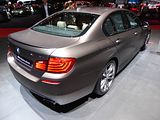
There were several 6 series models on show, As well as a 640d xDrive Coupe, there were 650i xDrive Cabrio and an M6 Gran Coupe
There were several of the X models as well. The new X4 M40i model completely eluded any attempt to get a photo, with so many people unable to contain their desperation to barge in front and mindlessly open the boot or a door, for even a second whilst I took a photo., After countless attempts on every visit to the stand. The crass, but popular, X6 also does not feature in my photos, but I did at least record this X5 M50d. There were X3 and X1 models on display as well.
After showing a number of plug in hybrid concept vehicles in the last couple of years, BMW have now put a series of models into production in yet another sub-brand. which they are calling iPerformance. This will be applied to all BMW plug-in hybrid vehicles from July 2016, and according to BMW provides a visible indicator of the transfer of technology from BMW i to the BMW core brand. It is being seeing first on the plug-in hybrid variants of the new BMW 7 Series, which will adopt the not short name of BMW 740e iPerformance. The iPerformance models will benefit from the transfer of technical expertise regarding electric motors, battery cells and electronic control systems. Visible indicators, meanwhile, are a BMW i logo on the front side panel, BMW i-style blue elements in the kidney grille and wheel hubs, and an eDrive logo on the C-pillar. Customers will make use of the BMW i 360° ELECTRIC range of products and services, including the BMW i Wallbox. For now, the plug-in hybrid cars are all identified by the “e” in their badging, just as is the case with the equivalents from arch rival Mercedes, and three of them were displayed here: a 330e, a 225e Active Tourer and the X5 xDrive 40e. With very low CO2 figures, a reasonable purchase price premium and all the standard BMW attributes still firmly intact, these are likely to prove to be popular additions to the range. The cars are also identifiable by special badging on their C pillars.
The all electric models were also on show, of course, with the two very different cars in the range at either side of the large stand. There were a couple of the i3 models which are starting to become quite a common sight in the more affluent cities of Europe, and at the other side of the stand was an i8 in a new limited edition Protonic Red colour. The i3s were generating plenty of interest, and the i8 was practically mobbed all day long. This futuristic supercar really has continued to grab people’s interest to a far greater extent than the sceptics would have predicted a couple of years ago.
BRABUS
Brabus had a vast stand, as is usually the case at this show. Unlike the other aftermarket companies, they focus most of their efforts on mechanical upgrades, leaving the Mercedes cars that they generally start with looking only subtly different from the standard cars. That appeals to me far more than the garish customisations that will feature elsewhere in this report. There were plenty of examples of their endeavours on show, Although the majority of their business concerns brand new cars, they do also turn their attention to classic Mercedes models as well, and there were examples of the legendary 300SL, the “Pagoda” W113 and the very elegant W111 Convertible on show here.
The new Mercedes-AMG S65 Coupe has joined Brabus’ family of insanely powerful Rocket models boasting 900PS (887hp) and 1,500Nm (1,106 lb-ft) of torque, though the latter is electronically limited to 1,200 Nm (884 lb-ft). To extract those kind of figures from the stock 630PS (621hp) and 1,000Nm (738lb-ft) 6.0-liter twin-turbo V12, Brabus increased its displacement to 6.3-liters and made all sorts of upgrades, ranging from a special billet crankshaft with longer stroke and new turbochargers to a reprogrammed ECU and a high performance exhaust. All that power is channelled to the rear wheels via a reinforced a seven-speed automatic transmission with steering wheel paddle shifters along with a BRABUS high-performance limited-slip differential with a locking rate of 40 percent. The new Brabus 900 Rocket Coupe promises to blast to 100km/h (62mph) in 3.7 seconds, beating the standard car by 0.4 seconds, while reaching 200km/h (124mph) in 9.1 seconds and achieving a de-restricted top speed of 350km/h (217mph). A new suspension module that can lower the ride-height by around 15 millimetres (0.6 in) and a choice of 21-inch wheels in 255/35 ZR 21 tires front and 295/30 ZR 21 rear, or 22-inch rims in 255/30 ZR 22 tires front and 295/25 ZR 22 rear, complete the performance upgrades. Brabus’ transformation of the Mercedes-AMG S65 Coupe concludes with a carbon fiber aerodynamic kit that includes front apron, boot lid spoiler, rear diffuser and side skirts, along with carbon fibre mirror caps and trims, and a makeover of the cabin with exclusive light brown and magnolia leather, umbra-coloured wood trims, aluminium components and backlit scuff plates. The German tuner offers the BRABUS 900 ROCKET Coupe as a complete car or as an aftermarket package for any current Mercedes-AMG S65 Coupe.
Shown alongside the Coupe was their new 641hp Mercedes-AMG C63S sedan. If there’s something that Mercedes-AMG’s new 503hp C63 S sports sedan and Wagon don’t seem to lack, it’s power, but the tuning minds at Brabus beg to differ. The Germans have worked their magic on the range-topper C63 S’s 4.0-litre bi-turbo V8 updating it with newly developed turbochargers featuring a larger compressor unit, a special core assembly with reinforced axial bearings, a reprogrammed ECU and a sports stainless-steel exhaust with actively controlled butterfly valves. That’s enough for the Brabus C63 S to offer 650PS (641hp) and 820Nm (604 lb-ft) of peak torque, up by 140PS (138hp) and 120Nm (88 lb-ft) over the stock model, allowing the sedan to hit 100km/h (62mph) in 3.7 sec (Estate: 3.8 sec)and top out at 320km/h (200mph), an improvement of 0.3 sec and 70km/h (43mph – mainly thanks to the removal of the speed limiter) respectively. Brabus worked with technology partner Bilstein to develop a specially tuned height-adjustable coilover suspension that allows the rebound and compression rates of the gas-pressure shocks at the front and rear axle to dialled to one of ten settings. Customers can choose from two different 20-inch wheel designs shod in Continental, Pirelli or YOKOHAMA tyres of sizes 255/30 ZR 20 at the front and up to 275/30 ZR 20 on the rear axle. There’s a carbon fibre aerodynamic and styling kit available in both matte and mirror-polished sealed surfaces that include a front apron, rear spoiler, rear diffuser and mirror caps, with Brabus also offering plenty of interior customisation options such as unique upholstery and aluminium trims and accents.
It’s been a while since we last saw a G-Wagen modified by the high-performance aftermarket tuning firm, but there were a couple of different Brabus conversions on show here, an 840 and a 500. Mercedes replaced the old 5.5-litre dinosaur from the G500 with a smaller, but more powerful 422 HP, 4.0-litre turbocharged V8 – an adequate power figure four-wheel-drive luxury SUV; but, of course, if you want to rise up to Brabus’ standards, then a stock power figure suddenly doesn’t cut the mustard anymore. So, to keep it in-tune with the extensive modification programs carried by the prestigious tuning company, the G500 received a hype in power and in style, boasting 493 HP thanks to a plug-and-play performance module integrated into the electronic management system of the V8, called the BRABUS B40 – 500 PowerXtra performance upgrade, and an exterior overhaul. Maybe the 78 HP climb in power isn’t the kind of force we expected from Brabus, but the peak torque has also increased by 100 Nm (74-lb-ft), resulting in a monumental 710 Nm (523 lb-ft) of torque. Consequently, the 0 to 100 km/h (62 mph) time shortened to just 5.7 seconds – remember, we’re talking about a 2,5-ton car. For safety reasons, top speed was limited at 220 km/h (137 mph). In addition to the modified V8, Brabus added a stainless-steel sport exhaust system with controlled butterfly valves, offering an active sound management. To make the package even more appealing, the exhausts were moved to both sides of the vehicle. The exterior styling is completed by the well-known Widestar widebody variant – now a classic in Brabus’ curriculum – which includes revised accessories. As you’d expect, the interior underwent a “slight” upgrade, now featuring “soft and breathable” Mastik leather and Alcantara in this particular variant. But Brabus will comply to customer demand, modifying the interior in accordance; using aluminium, carbon fibre and wood.
Even the V Class can undergo the Brabus conversions, as this model exemplifies.
BUGATTI
For many people, this would be the one stand above all others that they wanted to see, as the long awaited successor to the Veyron was making its world debut here. Taking its name from the 1920s and 1930s Grand Prix racer Louis Chiron, whose notable results included victory in the 1931 French Grand Prix at the wheel of a Bugatti Type 51, the new car was previewed by the Vision Gran Turismo concept car at last year’s Frankfurt Show, and seen in public a few times after that, such as at the recent Retromobile, the immensely powerful Chiron aims to occupy the position its highly celebrated predecessor held at the very top of the supercar ladder, one rung above the McLaren P1, Ferrari LaFerrari and Porsche 918 Spyder – all of which have now ceased production. Bugatti describes the second of its modern day models as the most powerful road car to ever reach series production, and it does indeed produce a colossal 1479bhp which means it can reach 62mph in less than 2.5sec – despite weighing 1995kg – and has a maximum top speed of 261mph.. The phrase “series production” is all relative, though, with volumes set to be limited to 500 and a price to match its extreme performance at an eye watering €2.4 million (about £1.9 million) it will remain out of reach for all but the seriously rich. Bugatti boss Wolfgang Dürheimer portrays the quad-turbocharged 8.0-litre W16 powered Chiron as an all-new car that uses little from the Veyron. But while the new Bugatti has been comprehensively re-engineered and now features a full carbonfibre construction, it adopts a similar mechanical package to its record-breaking predecessor. At its heart is a heavily revised version of the quad-turbocharged 8.0-litre W16 configured petrol engine used by the Veyron. With a faintly absurd 1479bhp developed at 6750rpm, the mid-mounted unit delivers 492bhp more than the engine used by the Veyron – in the process providing the Chiron with a power-to-weight ratio of 741bhp per tonne. Torque has also risen by a substantial 257lb ft, peaking at 1179lb ft on a band of revs between 2000 and 6000rpm. Among the more significant developments brought to the Bugatti powerplant is a redesigned carbonfibre inlet manifold, heavily reworked injection system featuring 32 individual injectors, larger and more powerful turbochargers, a revised intercooler system and new titanium exhaust system with a total of six catalysers that is claimed to provide a substantial reduction in back pressure over the old system. In a bid to provide the new Chiron with what Bugatti describes as a more linear delivery of power than the Veyron, the new turbochargers are operated in a two-stage process; during step off just two turbochargers function initially, with the remaining two joining in to boost performance when the engine speed rises above 3800rpm. The colossal reserves are channelled through a reworked version of the Veyron’s seven-speed dual clutch gearbox and multi-plate clutch four-wheel-drive system; the latter has an electronically controlled differential that provides a torque-vectoring function to vary the amount of drive apportioned to each of the rear wheels and the basis for what Bugatti dubs an “easy to drift” function. While it is yet to undergo final certification testing, Bugatti has released preliminary performance figures suggesting it has achieved its stated aim of making the Chiron faster than the Veyron with claims of 0-to-62mph in under 2.5sec, 0 to 124mph in less than 6.5sec and 0 to 186mph below 13.6sec. By comparison, the Veyron posted official times of 2.5sec, 7.3sec and 16.7sec respectively. As before, top speed is limited in two stages; the so-called handling mode allows 236mph before the electrics step in, and the top-speed mode provides a maximum of 261mph, eclipsing the Veyron by 7mph. The chassis of the Chiron is a clear development of the Veyron’s. In a bid to improve ride quality without compromising body control, it adopts an adaptive suspension system, providing variable ride height and damping control. In combination with variable characteristics for a new electro-mechanical steering system and the four-wheel-drive system, the driver can choose between five driving modes: Lift, Auto, Autobahn, Handling and Top Speed. The Lift mode increases the ride height for speed bumps, while in Auto, Autobahn and Handling modes the top speed is limited to 236mph. To engage Top Speed mode, the Chiron requires a ‘Speed Key’, which alters the engine management system to provide the claimed 261mph maximum. Reining in the vast performance are 420mm front and 400mm rear carbon-ceramic discs grabbed by eight-pot and six-pot calipers respectively. They provide the Chiron with a claimed 62 to 0mph in 31.3m, 124 to 0mph in 125m and 186 to 0mph in 275m – in each case eclipsing the various claimed braking distances of its predecessor. Borrowing strong visual cues from the earlier Veyron, the new Chiron features an even more dramatic design with tauter surfacing, bolder details and added aerodynamic efficiency than that of the car it replaces. The man credited with the new appearance, Bugatti design boss Achim Anscheidt, says it was developed in close collaboration with Bugatti’s engineering team to ensure greater functionality without any loss in overall impact. Key design elements include a race-grade front splitter, large horizontal air ducts, a traditional horseshoe-shaped grille sporting a Bugatti badge fashioned from silver and enamel, distinctive LED headlamps – each with four individual lenses and integrated air ducts that feed cooling air to the front brakes, shapely front wings and a flamboyant semicircular sweep of bodywork extending from the trailing edge of its front wheelarches back towards the rear and into the A-pillars – the latter flourish clearly inspired by the look originally established by Jean Bugatti on the iconic Type 57. As on the Type 57, there is also a prominent centre fin running from the top of the grille across the bonnet and into the heavily rounded roof, providing an important contribution to the Chiron’s longitudinal stability, according to Bugatti. A NACA duct formed by shapely rear pillars replaces the individual air scoops used by the Veyron, channelling air into the engine bay more efficiently and with less turbulence than on its predecessor. It is at the rear where the more significant differences in appearance between the Veyron and Chiron are apparent, with a strong trailing edge, fully integrated rear spoiler, full width LED light band housing the tail lamps, indicators and reserving lamp, sizeable air ducts, large central mounted exhaust and race grade diffuser providing the new Bugatti with a particularly purposeful appearance from behind. Dimensionally, the Chiron remains close to its predecessor. At 4544mm long, 2038mm wide and 1212mm tall, it is 82mm longer, 40mm wider and 53mm higher than the Veyron. The similarities also extend to the wheelbase, which is just 1mm longer, at 2711mm. The Chiron sits on 285/30 R20 ZR tyres at the front, with 355/25 R21 ZR rubber at the rear. The basis for the new Bugatti is provided by a newly developed carbonfibre monocoque structure of the same standard as that used in Audi and Porsche’s LMP1 cars. In a departure from that used by the Veyron, it adopts a sandwich construction for the floor and a carbonfibre-reinforced plastic engine cradle at the rear for added stiffness and lower structure weight. Yet achieving the sort of stiffness achieved by the latest LMP1 race cars, the Chiron is155kg heavier than its predecessor at 1995kg. The increase in width has brought greater space to the two-seat interior and in particular the front wheel wells of the Chiron, according to Bugatti. Greater height has also liberated 12mm extra headroom compared with the Veyron. The cabin is trimmed in a combination of leather, carbonfibre and brushed aluminium. Among the new developments is a passenger airbag that deploys through carbonfibre – a first for a production vehicle. The Chiron will be assembled at Bugatti’s headquarters in Mosheim, France. So far, Bugatti has received more than 150 orders for the new car, and deliveries will begin in October, with existing Veyron owners being given priority in the queue. Further variants of the Chiron are planned to be launched, including successor models to the Veyron Grand Sport, Veyron SuperSport and Veyron Grand Vitesse. It is likely that the car will be in “production” until about 2024.
There were crowds surrounding the stand more or less all day long, but with very few people actually granted access for a truly close up, it was actually not hard to get plenty of pictures of this incredible car.
CARACTERE
A new name for me, this after-market tuner had a series of customised Range Rover products on show. Not to my taste at all, but compared to some of what was to come, these were less extreme than a lot! First up was the Range Rover Sport which had received a number of styling changes including a new front bumper and a rear spoiler with integrated dual exhaust tips. A sports roof spoiler has been added at the rear while wing flares are fitted on both axles giving the car much broader swollen shoulders. All these parts are made of PU-RIM. In addition to the bodykit, there are sets of wheels to choose from – CW1 and CW2 forged alloy wheels.
As with the Sport, Caractere Exclusive have given the Range Rover Vogue a new front and rear bumper, a rear spoiler with integrated exhaust tips as well as flared front and rear wings. This model is also available with the Caractere Exclusive CW1 and CW2 light alloy wheels.
Being the ‘baby’ of the Range Rover family, the changes applied to the Range Rover Evoque are much more understated with a set of front and rear bumper and the CW1 forged alloy wheels in 22 inches.
Caractere also had a version of the new Audi A4 Avant on show. The changes here were solely cosmetic, with a new bodykit being applied to what remains as a standard 2.0 ltire TDI version of the new car. The package on offer includes a new front bumper accompanied by a rear spoiler and with integrated exhaust tips as well as more aggressive side skirts. As with their other projects, Caractere Exclusive have fitted the car with their 20-inch CW1 wheels which are available in a gloss black on graphite finish.
CHEVROLET
With no sign of Cadillac at the show, the corner of Hall 1 was occupied by GM’s Chevrolet who had an array of exciting sports cars on show. Reflecting “the American way”, they had a very nasal sounding show girl from Michigan who at frequent intervals was delivering the sort of PR guff nonsense that invades the airwaves of every American show, but which just is not done in Europe. She clearly made no concessions to the fact that she was in Europe. Her spiel was delivered in US English, at speed, as among other things, she told us that the “Coop” would be available “from the Fall”. The car she was talking about was the new track-focused Chevrolet Corvette Grand Sport, which will sit between the standard Corvette Stingray and the super-fast Corvette Z06 in the range. It benefits from bespoke chassis retuning, cooling systems, and new performance technologies. The naturally aspirated LT1 V8 engine under the bonnet produces 460bhp and sends power to the rear wheels via a seven-speed manual transmission. An eight-speed paddle-shift automatic is available as an option. It runs the Corvette’s magnetic ride control system, albeit with tweaked roll bars and springs. The standard electronic limited-slip differential is also derived from the standard car’s. The Corvette Grand Sport rides on 285/30 ZR19 (front) and 335/25 ZR20 (rear) tyres fitted to a bespoke Grand Sport wheel design. The Brembo brake system with 355 mm rotors and six-piston calipers at the front and 340 mm rotors and four-piston calipers at the rear. Available as a coupé or a convertible, the Corvette Grand Sport, “combines a lightweight architecture, a track-honed aerodynamics package, Michelin tyres and a naturally aspirated engine to offer an estimated 1.05g in cornering capability”, according to Chevrolet. That cornering capability can be increased to 1.2g when the Z07 package, which offers even more performance, is added. It adds carbon-ceramic brakes, Michelin Sport Cup 2 summer tyres, and a carbonfibre aero package that delivers downforce.
Chevrolet also showed off a number of examples of the latest Camaro, which is lighter, more powerful and more efficient than its predecessor as well as the 2016 Corvette Stingray and the latest model year Corvette Z06.
CITROEN
I’ve still not managed to get behind the wheel of a C4 Cactus, and from what I’ve heard, that might be just as well. It would seem that this car, which looks so like a return to the quirky Citroens of yore which dare to be different rather let the side down when it comes to the driving experience. And that’s a shame, as when considered as a static object, this practical car has lots of appeal. Several examples were on the stand.
I struggle to warm to the the rest of the current range, all of which was represented with the 2 year old C1 joined by the C3, due to be replaced later this year, the very anonymous C4 and the good looking but slow selling C5, as well as the range of Picasso models – C3 and C4 and the C4 AirCross crossovers.
At the back of the stand was the Spacetourer Hyphen concept, a chunky all-wheel drive MPV. This eight-seater is claimed to offer the practicality of an MPV with the off-road, go-anywhere ability of an SUV. The styling features a raised ride height, chunkier bodywork than the standard Spacetourer, and is finished with 19in matt black aluminium alloys. An all-wheel-drive powertrain matches the rugged looks of the Spacetourer Hyphen while the Hyphen moniker stems from Citroën’s collaboration with the French pop group Hyphen Hyphen. The quirky three-colour interior Nappa leather upholstery and trim design is finished in teal, neon orange and pale green, with each seat adopting a different variation using the three colours, while orange strap detailing mirrors the orange exterior trim. A panoramic sunroof also features. The Spacetourer Hyphen concept is powered by Citroën’s BlueHDi 150 S&S engine, with claimed CO2 emissions of 110g/km, ‘vastly reduced NOx emissions’ and a six-speed manual gearbox. The engine is also currently found in the C4 Picasso and Grand C4 Picasso, with which the concept also shares its underpinnings.
Although the Spacetourer Hyphen concept will not make it to production, the standard Spacetourer will do. This model was revealed in December 2015 and is built alongside the Peugeot Traveller and Toyota Proace, as the three brands’ deal for shared underpinnings continues. UK buyers will have the choice of short-, medium- and long-wheelbase formats, accommodating up to nine people with an on-sale date around the start of September and pricing likely to start at around £24,000, rising to more than £31,000 for top-spec Spacetourers.
Having previewed its intentions with the similarly-minded Cactus M Concept showcased at the last Frankfurt Motor Show. Citroen revealed a new electric model called E-Mehari, reviving its historic nameplate with a four-seater convertible / SUV bodystyle. The car has a simple, clean look, paying tribute to the original 2CV-based 1968 model which was loved for its simplicity and ruggedness. The electric powertrain of the new E-Mehari comes from the collaboration between Citroen and the Bollore Group, featuring a 30kWh Lithium Metal Polymer battery pack which makes it, according the company, immune to weather conditions while giving the vehicle a longer range. This by the way is rated at 124 miles (200km) in city conditions while top speed sits at 68mph (110km/h). The new E-Mehari can be fully recharged in eight hours on a 16A socket or in 13 hours on a domestic 10A socket. The soft top can be folded away to release more space. Citroen plans to offer an extensive list of customisation options to its customers, including four body colours (blue-orange-yellow-beige), two roof colours (black and orange-red), two cabin trim colours (beige and orange-red) which are also completely waterproof as they are made out of plastic-coated fabric. Citroen will give the option to create your own combination freely with the above options. The new Citroen E-Mehari will be launched in France during the spring of 2016 and will reach other European markets by the end of 2016.
As well as the “regular” model, there was a white one on display which Citroen had called on French fashion house Courreges to embellish. It is set apart from the regular model mainly by the white colour, which can be found on just about every surface, including the wheels. The study also boasts bright orange accent for contrast and promises to be even more practical towards the rear, where the standard car’s hoop was replaced by two side straps. The interior sports the same white shade and bright orange accents, joined by a single-spoke monochrome steering wheel, white-finished mats on the leather-lined floor, Plexiglas roof with frosted finish. The French fashion firm also added a special set of luggage made from white leather and bright orange vinyl.
Tucked away in a side pod of the stand was an example of the marque’s WTCC car, the C4 Élysée based TC1. For the past few years Citroen have entered both World Rally Championship and the World Touring Car Championship and they have enjoyed success in both. Although the cars are similar, they are clearly not the same as each is optimised for the demands of its particular type of motorsport, and there are a different team of 6 driving each of the championships. Brit Kris Meeke is one of the key drivers in the WRC, whereas the best known of the Touring Car drivers is Sébastien Loeb who joined the team when it was set up in 2013. Other drivers in 2015 were José María López, Yvan Muller and Ma Qing Hua. Citroen have announced that 2016 will be their last season in the sport, and they will only be running 2 cars, for Yvan Muller and José María López during the forthcoming year. The TC1 has been very successful In 2014, Citroën won fourteen out the first fifteen races and seventeen races out of the total of twenty three in the year , in spite of the inversion of the qualifications grid for the race two and in spite of the 60 kg compensation weight that the Citroën C-Elysée had to carry, as the most competitive car of the championship. This performance brought the team the Manufacturer’s WTCC Championship, 5 races before the end of the season, after the 2014 Shanghai first race, where Citroën recorded a magnificent one-two-three-four. The Citroën World Touring Car Team pilots also got the three first ranks of the Drivers’ World Touring Car Championship. The team – or rather teams, as there was a Sébastien Loeb team, as well as the Citroen/Total one, were equally dominant in 2015, wining both the Manufacturers and the Yvan Muller the driver’s championships.
DACIA
There were no new models on the Dacia stand, but that did not stop it from being quite busy, as there are plenty of people for whom this budget-priced range of Roumanian cars appeals. All the current models were shown, ranging from the second generation Logan saloon and MCV estate and the Sandero hatchback, as well as the popular Duster SUV and the practical and commodious Dokker and Lodgy models.
Making its debut here was a special edition of the Duster. Called the Duster Essential, it sports a new body colour, Tourmaline Brown, along with specific badging, body-coloured bumpers and a new set of alloy wheels. Inside, passengers will get to enjoy Bluetooth and USB connectivity, along with the electric front windows and central locking. It would seem that the temptation to add extra features (and cost) is too hard all points of the market!
DMC
Apparently, DMC doesn’t believe that the Lamborghini Huracan is aggressive enough. The German tuner that specialises in getting the most out of exclusive and impressive machines presented this modified Lamborghini Huracan is one of its star projects. DMC isn’t a stranger to Lamborghini, as the company left its mark on the Italian bull plenty of times now, with every creation pushing the envelope a little further. This time, though, the tuner’s affinity for Lambo’s entry-level offering has materialised into a sinister proposal that transforms the stock vehicle into a track-day reminiscent beast without using too many accessories. Sure, the ones visible could be considered flashy, especially the very large rear wing and the front splitter with added side flaps which mimics the aggressive LP720 Anniversario look, but somehow the elements are not out of place. As you’d expect, the entire body kit is made out of carbon fibre, complementing the “nero” hue.
When the G-Class first rolled off the production line, nobody thought it would eventually become a cult classic and, in some cases, a fully-fledged performance automobile. DMC, on the other hand, like many other tuners before it, realised that the vehicle’s boxy design and AMG-sourced engine could make it a base for a mental creation, and thus the Zeus was born. Brought to Geneva to entice (?!) the crowds, the full-carbon fibre tuning project, governed by the huge wheel arches, widens the G63 AMG by 4 cm at the rear and 3.5 cm at the front, transforming it into an outrageous proposition. The package is comprehensive, to say the least, and it also includes the revised front fascia, the rear bumper and the added rear diffuser, and a lot of other bits and pieces (raging from the hood and roof cover, all the way to the spare wheel cover). The parts are available in clear carbon-fibre (like the model pictured) or painted, although we would prefer the clear coated option for the added sinister vibe. Who would want to see this thing in their rear-view mirror? Completing the intimidating look are the massive, blackened, concave 24-inch rims, wrapped in 305/35ZR24 Pirelli P-Zero Scorpion tires. But knowing that the tuner managed to extract 880 PS (867 hp) from the 5,461 cc V8 twin turbo engine, the G-Wagon needs ultra-wide rims to put all the power down.
DS
DS has been a separate brand for a couple of years now, and so has its own stand at the show, though it did adjoin the larger Citroen one, so some people may not actually have realised that this marque aspires to position itself as premium, with pricing to match. Star of the stand was the all-electric DS E-Tense concept car, a two-seat, high-performance GT a further signal of DS’ intent to cement its image as a luxurious top-end manufacturer away from its mainstream parent company. The E-Tense has been made to production standards and everything on the concept is entirely viable, from the all-electric drivetrain to the way that pedestrian impact standards have been considered in its design. Despite this, there are no official plans to put it into production. After the Geneva show, the concept will be put to work as a technology demonstrator, proving it can deliver on DS’s claims of a 4.5sec 0-62mph time, a 155mph top speed and a 220-mile range. The E-Tense is built around a central carbonfibre tub, with aluminium subframes at each end. Suspension is by double wishbones at all four corners and under the rear bodywork are two Siemens AC electric motors that produce a total output of 402bhp and 381lb ft of torque. Rather than a one-motor per-wheel set-up, however, both motors turn a common shaft, with the thinking being that two motors are lighter and easier to package than a single high-output motor. Drive goes into a three-speed gearbox and then an active differential that biases torque across the rear axle. Power comes from a 53kWh lithium-ion battery pack mounted under the floor, itself fed by a rear-mounted high-speed charger.The battery weighs less than 500kg and the total weight of the car is around 1800kg. The car is 4.72m long and 1.29m high, and its swooping, fluid design echoes the styling of the Divine DS concept from 2015 and shares elements with its predecessor, such as having no rear windscreen and instead using digital rear-view technology The elegant lines were produced using a state of the art live CAD system, which enabled virtual aerodynamic modelling. The slightly Lamborghini-like side profile is designed to help channel airflow at speed. A large carbonfibre diffuser is used at the rear to improve aerodynamic downforce. There’s no rear window. Instead, a rear-view camera system relays an image from the back of the car to a ‘mirror’ display in the cockpit, a feature which is already destined for production in at least one future DS. The E-Tense also has windscreen wipers and door mirrors. The headlights have four jewel-like movable units that allow for different intensity and beam patterns while it also gets active LED daytime running lights that can rotate 180 degrees and which are likely to be used on future DS models. Eric Opode, DS’s product development boss, said they are patented and production ready. The tyres are Michelin Pilot Super Sports (305/30 R20 at the back) and have a chamfered finish, designed to make them feel like velvet. The striking interior features a central display screen mounted on an elaborately shaped dashboard extrusion. Hand-painted leather panels and seats have taken nearly 800 hours of work in a prototype trim shop. There’s also an in-built, centre console-mounted BRM watch which an owner can remove when they leave the car. The manufacturer claims its interior took 800 hours to design, test and produce, and it has collaborated with French luxury brands Moynat, BRM Chronographes and Focal, to design a helmet harness, the centre-console timepiece that can be detached and worn as a watch, and a nine-speaker audio system, respectively. Plenty of people have eulogised over the design. I am not among them.
There are ambitious plans for DS, with an all-new six model lineup due to start to appear from 2018, with a large saloon and SUV tipped to top the range. But for now, it is the familiar DS3, DS4 and DS5 models which customers in Europe can buy. what was billed as an “all new” DS3 was revealed a few weeks ago. It certainly is not all new. Rather, it is a revamp of the popular small car, with the latest style DS grille on the front and a new range of engines under the bonnet.
The DS4 and DS5 models were both refreshed last year, and both were represented here, along with the faux-off roader DS4 Crossback which went on sale at the end of 2015.
EDAG
Making its world premiere was the EDAG Soulmate concept. We are all familiar with the “Always on, always connected” mantra in the era of the smartphone, which means that we have access to all manner of useful solutions with us anywhere and everywhere. In a joint project with Bosch, EDAG set about applying this philosophy to the car, with a concept, called the Soulmate, which demonstrates how, in its ultimate form, “connectivity“ will continue to change everyday life and make things more convenient. To do this, EDAG have fully integrated the digital world in the car, with the idea (and hence the name) of making the car another indispensable digital companion just like the smartphone. In addition, the Soulmate applies new thinking to its lightweight body form, produced with a combination of additive manufacturing and bionically inspired design, to make the car not just lighter and more sustainable, but also so it can be manufactured more intelligently.
FAB DESIGN
FAB Design is well-known for creating some outlandish bodykits and has lived up to its name following the release of the Mercedes-Benz S-Class Coupe ETHON. The tuner has taken one of the most beautiful cars on the market and installed it with angular front and rear fascias alongside custom wheels and lowered side skirts. Of all the changes, the new front bumper is certainly the most obvious due to its newly-shaped air intake surrounds and a colour-matched horizontal bar stretching from one intake to the other. As for the wheels, they have been created in house by Fab Design and are dubbed the Evolution II, measuring 22×9.5 at the front and 22×10 at the rear. As the ETHON is based around the S63 AMG Coupe, it receives its grunt from a twin-turbo 5.5-litre V8 engine. Even though that engine is already extremely potent with 577 hp, Fab has lifted output to 630 hp and 920 Nm of torque.
After playing around with the Mercedes-Benz S-Class Coupe Ethon, FAB Design has switched brands and went for the McLaren 650S. Finished in black with red accents, the machine, dubbed Vayu GTR Coupe, benefits from an aerodynamic body kit that includes beefier bumpers, muscular side skirts, custom rear wing, additional air intakes on the sides and a roof scoop, many of them made from carbon fibre. A new set of 20-inch alloy wheels, wrapped in 275/25 front and 325/30 rear Dunlop Sport Maxx tires, along with a larger diameter dual-tips custom exhaust system, complete the exterior design. Inside, the supercar can receive carbon fiber accents, several leather upholstery finishes and a set of aluminium pedals. The 3.8-litre twin-turbo V8 engine, found on the rest of the McLaren lineup, has been massaged to produce an extra 32 PS (32HP) in this case, to a total of 682 PS (672 HP). FAB Design says that the upgrades are available for both the 650S Coupe and Spider and for their predecessors too, the MP4-12C and 12C Spider. Details such as performance, availability or pricing haven’t been announced yet
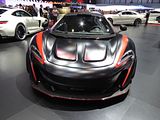

Dressed in white and equipped with numerous upgrades, the Mercedes-AMG GT S Areion is one of the more interesting approaches made to the German sports car. FAB Design have added a more aggressive and wider front bumper, distinctive air-outakes and sculpted side skirts and black-finished 9.5×20-inch front and 11×21-inch rear FAB Design Evolution III wheels. At the rear, it sports a reshaped bumper, new diffuser, quad exhaust pipes and massive wing, while the cabin can come with a plethora of finishes, the only limit being the customer’s imagination. Aside from the new exhaust system, which is said to be more efficient, the Mercedes-AMG GT S Areion benefits from bigger turbochargers added to the 4.0-litre twin-turbo V8, which produces 190 PS (187 HP) and 375 Nm (277lb-ft) more, to a total of 700 PS (690 HP) and 1,025 Nm (756lb-ft).
FAB Design had also applied their unique styling talent to the Mercedes G Class. This is the Mercedes-Benz G-Class SHAHIN Bi-Color edition and it is quite extraordinary. The G-Class Shahin edition is presented in a limited edition Bi-Colour paint scheme and bears the name of a famous falcon.FAB Design has confirmed that they all will offer the limited edition car with either composite or carbon fibre body panels. As with all their projects, FAB have fitted the car with custom wheels, in this case 11×23 inch FAB designed and manufactured Monoblock wheels shod in 305/35 R23 ADVAN S.T. tires. FAB claim that their Monoblock wheels are up to a staggering 40% lighter than the conventional, stock G-Class wheels from the factory. The tuners have not left the the parts under the skin untouched either. Power output of the G55 and G63 variants have been boosted. Buyers will be treated to horsepower figures of 530 hp or 620 hp on the G55 or G63, respectively. Torque figures have also been raised to 775 Nm on the G55 and 820 Nm on the G63. The interior is where the customisation is taken to another level. FAB promise that the options and choices of materials is only limited by the customers imagination. Hmm!
FERRARI
There are always crowds of people around the perimeter of the Ferrari stand, and this year was no exception, so getting a good look at the cars is quite difficult. They do allow more people to enter and get into the cars than rival brand Lamborghini, which is actually even more frustrating for the photographer who is denied access. Somehow, a certain Dan Grazier of this parish managed to blag his way past the usual very snooty stand staff and so he got into all the cars and got the close ups that eluded the rest of us. I had to content myself with the outsider’s view of Maranello’s latest products.
With the launch of the 488 GTB and Spider following hot on the heels of the California T, that meant the FF had become the “oldest” model in Ferrari’s range and therefore the one that was next in the queue for an update. And here it is, with a new name of GTC4Lusso. Styling changes mark it out visually from its predecessor. Aerodynamic improvements include a new front grille with integrated air intakes, new air vents on the rear wing, a roof-mounted rear spoiler and a new diffuser, all of which combine to give a drag coefficient that is “substantially lower” than that of the FF. At the back, a new twin rear light arrangement makes the car easy to identify compared to the FF, though whether you like it will be a matter of taste. I don’t particularly, but would seem to be in minority, as everyone else who has expressed an opinion seems to prefer the new look. Ferrari are aiming the GTC4Lusso at a younger audience than the brand has traditionally been used to. Owners of the FF, on average, drove more miles than owners of other Ferraris, suggesting that the GTC4Lusso will become the grand tourer of choice in the company’s range. Powering the GTC4Lusso is the same 6.2-litre V12 engine already fitted to the FF, but with power raised from 651bhp to 680bhp. Maximum power is reached at 8000rpm, while torque is rated at 514lb ft at 5750rpm, with 80% of torque available from 1750rpm. As before, drive is channelled through a seven-speed dual-clutch transmission. Ferrari says the car’s engine note is “rich and powerful in performance driving and discreet yet harmonious in the city.” Armed with more power, the GTC4Lusso can reach 62mph from a standing start in 3.4sec – 0.3sec faster than the FF – while its top speed is unchanged at 208mph. When specified with optional lightweight components, the GTC4Lusso has a dry weight of 1790kg, which matches the FF. Ferrari has yet to reveal whether the GTC4Lusso will improve on the FF’s fuel economy or CO2 emissions figures, which currently stand at a claimed 18.3mpg and 360g/km respectively. As with its predecessor, the GTC4Lusso has four-wheel drive but gets rear-wheel steering for the first time. The new, improved system, dubbed 4RM-S, features Ferrari’s Slip Side Control setup, and works with the car’s electronic differential and dampers. Ferrari says the result means drivers can “effortlessly handle the GTC4Lusso’s extraordinary torque even on snow-covered, wet or low-grip roads.” Among the significant interior changes to the four-seat cabin is a new infotainment system which has been developed by Delphi, but remains compatible with Apple CarPlay. The 10.25in screen is much larger than the one in the FF and Ferrari claims that its upgraded usability will put the GTC4Lusso among the class leaders. Ferrari’s dual cockpit display, which allows passengers to see speed and engine information from their side of the cabin, now appears to show a g-force meter – a first in a Ferrari. The smaller steering wheel – made possible due to a more compact airbag – features “more ergonomic” controls, such as a redesigned Manettino control and new buttons for the hands-free telephone system. The GTC4Lusso also gets a recess between the seats specifically to hold the key during driving; a feature the FF did not have. With prices set to rise from the £226,023 of the FF, the car may be aimed at younger buyers. but they are certainly not going to be less affluent ones!
Whilst the GTC4Lusso was the most obviously new Ferrari, it was not the only news on the stand. Ferrari were showing the HS (Handling Speciale) package for the California T, originally previewed in January. Available as an option for the 2+2 drop-top model, it was “designed for owners who appreciate the California T’s versatility and GT prowess”, as the company explains. The package includes faster gear changes, a new exhaust system, 16 percent stiffer springs at the front and 19 percent at the rear, tweaked adaptive dampers to cope with the extra stiffness without affecting the ride comfort too much, revised F1-Trac for better control and grip and some aesthetic differences. The car on display sported a two-tone livery with Rosso Corsa Metallic bodywork and Nero Stellato roof, complemented by the black interior with carbon fibre details.
Ferrari’s other card was another special Tailor Made version of the roadster, inspired by the 250 GT Berlinetta SWB. It featured a Grigio Scuro livery and a deep red transverse racing stripe, along with black diffuser with red fences, chrome tailpipes and a Heritage Bordeaux leather interior.
Completing Ferrari’s lineup at the Geneva show were an Argento Nurburgring 488 GTB, with a Nero Stellato roof, and a F12 Berlinetta in Rosso Berlinetta livery, with Cuoio leather interior.
FIAT
The car I most wanted to see here was the 124 Spider, which was premiered at the Los Angeles Show back in November (which I missed), and is now ready for Europe to have a look at. Visually distinct from the Mazda MX5, whose underpinnings the car shares, the Italian branded car has its own Fiat engine as well, so the character of the two models is going to be quite different. Which you prefer will largely be a matter of personal taste. The very first photos of the car in black did it no favours but the later white ones made the Fiat look far better and having now seen the car in the metal, and sat it in, I declare my liking for it.
There was a classic 124 Spider here as well. What a pretty car that is.
After an absence from the critically important C-segment family hatch sector following the fading out of the last Bravo, Fiat are returning with a range of models that will be made in Turkey, and which for Western Europe resurrect the Tipo name. The saloon model was launched last year and is already gathering sales momentum in Italy and elsewhere, but the more significant hatch and estate models were making their world debuts here. The UK won’t see the saloon, but the other body styles are confirmed for sale later in the year. The Tipo’s engine range is made up of two diesel engines; 1.3 and 1.6-litre units with 94bhp and 148lb ft, 118bhp and 236lb ft respectively, and three petrol engines, a 1.4-litre unit producing 94bhp and 92lb ft, a 1.6-litre 108bhp engine with 150lb ft.and a turbocharged 1.4-litre engine producing 118bhp and 152lb ft torque. A dual-clutch transmission is offered on the larger of the diesel engines, and a full auto ‘box is standard on the 1.6-litre, 108bhp petrol. The entry-level Tipo has air-con, remote central locking, electric front windows – and rear windows in the estate – electric mirrors, a DAB radio and Bluetooth connectivity. Fiat has posted boot space of 420litres for the hatchback, and 520litres for the estate, but with the 60/40 split-folding rear seats of the estate folded down, maximum storage capacity will sharply rise. Fiat also claims that practicality is boosted by a low loading lip. The Tipo hatchback is 4370mm long, 1790mm wide and 1500mm tall, compared to the Ford Focus’ 4360mm length, 1823 width and 1469 height. The Tipo estate, by comparison, is 200mm longer than the hatchback, at 4570mm. No prices have yet been given for the Tipo hatchback or estate, but the intent is that these cars will be significantly cheaper than some of the premium-chasing rivals in the class, a position once occupied by the Korean brands, but they, along with everyone else seem to have tried to head up market, with prices to match. There is no way that you would call the Tipo premium, but it looks neat and the interior is perfectly acceptable. It could be a very successful strategy.
The facelifted 500 was launched last summer and is becoming quite a common sight on our roads, reflecting the massive popularity of this small car. New at this show was a 500S version, which is meant to reflect is the sportier nature of the refreshed 500, which comes with new bumpers, integrated fog lights, special side skirts and spoiler, rear privacy glass, chrome exhaust tailpipe, black grained front air intakes, as well as a bold rear grille. Fiat is also making these Satin Graphite 15″ & 16″ diamond black alloys available on request, as the 500S new body colors certainly demand something more exclusive when it comes to wheels. Customers can order the 500S in either Metallic Azure or Alpine Green, working in contrast with the dark interiors enhanced by the black seats and roof lining. Inside, the dashboard features a Uconnect 7″ HD LIVE touchscreen with HD display as standard – incorporating features such as LIVE services, Bluetooth hands-free, voice recognition and loads of music options. In addition, the system is available on request with integrated mirroring for Apple CarPlay and Android Auto, digital radio (DAB) and 3D integrated TomTom sat-nav. Also on request, customers can equip their car with the exclusive BeatsAudio system, which offers 440 watts, a digital 8-channel amplifier, two dome tweeters, two 165 mm midwoofers, two full-range 165 mm speakers and one 200 mm subwoofer. Powering the 500S is a 1.3-litre MultiJet 95 HP unit, capable of taking the car from 0 to 100 km/h (62 mph) in 10.7 seconds, before maxing out at 180 km/h (111 mph). In terms of fuel consumption, this 500S needs just 3.4 litres of diesel for every 100 km (69 mpg), which is quite an impressive number. Fiat 500 fans who’d rather have the wind in their hair will probably look towards the 500S Cabrio which can still be enjoyed all year round. Other trim versions were on also on the stand.
Also on show were examples of some of the rest of the range. The Punto was conspicuous by its absence, but there were a couple of Panda models, one of which was the Panda Cross version, as well as a 500L and a 500X.
Final Fiat was the Fullback, a new pickup offering that I first saw at the Dubai Show in November. It’s not an entirely new product, though, as it is closely related to the Triton pickup (also known as the L200) that Mitsubishi builds in Thailand for markets in Europe, Asia, and Africa. Riding on a 118″ wheelbase, it measures 208″ long, 71″ wide and 70″ tall. These are identical measurements to the Mitsubishi, and are broadly similar dimensions to other mid-sized pickups, such as the Chevy Colorado/GMC Canyon. It is an important segment in Europe, with sales there totalling 675,000 units in 2014 representing 23% of total sales in the Light Commercial Vehicle segment. With a name that is apparently derived from the cornerstone position in rugby and American football, the Fullback, offered with a standard double body cab, can carry up to 2,300 pounds, and is powered by a 2.4-litre turbo diesel engine available in either 150- or 180 hp states of tune, and mated to a six-speed manual or five-speed automatic transmission and standard four wheel drive. It will be sold in two trim levels by Fiat Professional in markets across Europe, the Middle East, and Africa, where it will compete against the likes of the Toyota Hilux, Ford Ranger, and Volkswagen Amarok, but is unlikely to reach the US. Sales do not start until the Autumn of 2016.
FORD
Ford’s current advertising campaign tells us that we need to Unlearn. Part of that is required as the company executes more of its One World vision with the arrival of some models in Europe which were hitherto the preserve of the North American market. After a seemingly never-ending wait, the Mustang has finally made it on sale in the UK, in the right hand drive form. Coupe and Convertible models are offered, with a choice of the 2.3 litre Ecoboost 4 cylinder engine as well as the thunderous 5 litre V8. AN example of each engine and each body style was proving popular cars to inspect.
Next up is the Edge, which in America is considered a mid-sized SUV, but which in Europe sits high in the range, offering a rival to the likes of the Volvo XC60 and Audi Q5.
More familiar to European eyes is the Kuga, a model known as the Escape, in North America. As that car received a facelift earlier this year, it was no surprise to see one applied to the Kuga model here, with refreshed styling, a new diesel engine option and the latest version of its Sync infotainment service. The updated Kuga has a more heavily sculpted bonnet which is claimed to increase pedestrian protection in the event of an accident. Exterior styling cues have been taken from the updated EcoSport compact SUV, with new self-adjusting bi-xenon headlights, LED daytime running lights and new fog lamps, while the rear gets restyled tail-lights and a power-operated tow bar that stores itself out of sight when not in use. The tailgate can also be opened with a kicking motion below the rear bumper. New ranges of 17- 18- and 19-inch alloy wheels are also available while inside there are fewer buttons, a new electronic parking brake and an improved design. For 2016 the Kuga gets a new 120bhp 1.5-litre TDCi diesel engine with front-wheel drive, which is capable of returning 64.2mpg while emitting 115g/km of CO2. A 2.0-litre TDCi diesel unit with 150bhp is also available, in either front-wheel drive or all-wheel drive; it returns 60.1mpg and emits 122g/km CO2. A 180bhp Intelligent All Wheel Drive version, delivering 54.3mpg and emitting 135g/km CO2, is also available. The 1.5-litre EcoBoost petrol unit also remains in 120bhp or 150bhp guises. An all-wheel-drive 182bhp variant of the petrol engine returns 38.2mpg and 171g/km of CO2. The new Sync 3 system comes with an 8.0-inch touchscreen and includes Apple CarPlay and Android Auto functionality. It allows drivers to control functions using conversational voice commands. By saying ‘I need a coffee’ or ‘I need petrol,’ for example, the system will locate nearby stops. All-wheel-drive models offer Ford’s semi-autonomous perpendicular parking technology which helps drivers to park hands‑free in spaces alongside other cars. Cross traffic alert aids drivers reversing out of a parking space, while park-out assist helps drivers as they exit parallel parking spaces. A new enhanced version of Ford’s active city stop is also onboard, now operating at speeds up to 31mph – an increase of 12mph. The facelifted model will be available from October.
A second transformation that is coming is the push towards premium with the Vignale branding. First revealed a year ago, the idea is that customers will think of their cars as Vignale and not Ford, and thus the extra fittings and improve quality trim will justify the higher prices and hence margins that Ford wants to charge. Mondeo was the first to receive the Vignale treatment, but a whole load more models have now undergone the same, erm, “transformation”. with Vignale versions of the Edge, Kuga and S-Max models all making their debut here. The Vignale element of the stand was significant, and Ford were further reinforcing it with a huge area in the airport terminal, which was serving free coffee to everyone who stopped by. Ford’s Sync3 infotainment system will be included on all models as standard, featuring an 8.0in touchscreen that offers pinch and swipe functionality for the first time. Advanced voice control is also on offer. Users simply speak commands such as, “I need petrol”, and the system will find nearby shops. The Vignale Service app is also included, offering online lifestyle content from the Vignale Magazine, driving tips and information. The complete engine line-up has yet to be revealed, however, one option will be Ford’s 207bhp bi-turbo 2.0-litre TDCi diesel unit. New design options are also available from next year, enabling customers to further personalise the models. Ford of Europe director of design Joel Piaskowski said: “For customers, Ford Vignale is a more individualistic way to enjoy luxury and express your style.” On the stand, there were lots of Vignale cars. The Edge Vignale was shown in Vignale Ametista Scura Brown, and also in Vignale White Platinum, with a dark matte Vignale hexagonal upper grille design and polished aluminium surround.
The Ford S-Max was revealed in the exclusive Vignale Milano Grigio exterior colour and in Vignale White Platinum. Bespoke chrome-finish fog lights and 19in polished aluminium wheels are among the exterior design details featured on both the Edge and S-Max Vignale models, with hexagonal-quilted Windsor leather seats, door interiors, central armrest and instrument panel, on the inside. This model is available to order now.
A concept version of the forthcoming Ford Kuga Vignale also made its world debut at the show. The concept featured leather-clad seats, door trims, instrument panel and boot floor, all with bespoke tuxedo stitching. Ford said almost 80% of the 102,000 Kugas sold in 2015 were high-specification Titanium models, which would suggest a high demand for luxury in the SUV segment.
A five-door version of the Vignale Mondeo made an appearance, too, and this version should go on sale next year.
The Fiesta ST has been a big hit in the UK in particular, with almost two thirds of the 30,000 STs sold in Europe finding homes in Britain. An even more powerful and focused version was revealed here, the Fiesta ST200. It will reach the UK in limited numbers the summer. The ST200 hot hatch uses a tuned version of the standard ST’s 1.6-litre turbocharged EcoBoost engine, with power increased from 180bhp to 197bhp, and torque increased from 180lb ft to 214lb ft. These outputs are further increased, to 212bhp and 236lb ft, for up to 15 seconds through the standard overboost feature. Indeed, these higher figures give a better example of the ST200’s performance potential due to the length of the transient overboost. Tuning packages are already offered on the Fiesta ST that produce similar number, such as with the factory-approved Mountune packages, but the ST200’s modifications are much more extensive. The final drive ratio has been shortened, to improve driveability and in-gear performance. The 0-62mph time in the Fiesta ST200 has been cut from the standard ST by 0.2secs to 6.7sec, and top speed increased slightly by 4mph to 143mph. The six-speed manual gearbox remains. Other modifications include enhanced Torque Vectoring Control and three-stage Electronic Stability Control systems. The front steering knuckle has also been modified, as has the rear twist-beam to increase roll-stiffness. The front and rear damper settings are also new, with the centre of gravity having been lowered by 15mm. The steering arm has been shortened and the steering ratio is quicker, while the brakes have also been beefed up at the rear. Ford has given the ST200 a new look, with a new silver grey paint finish called Storm Grey and 17in matt black alloy wheels and new interior detailing. The part-leather charcoal-coloured Recaro seats get contrasting silver stitching, the seatbelts have silver detailing and the scuff plates are illuminated. The brake calipers are also painted red. The ST200 will act as a swansong for this generation of Fiesta. Ford is known to have a new model in development, with the first sighting of the new model set to come in 2017. There was a regular ST model displayed alongside it, as well.
Also badged ST was this Focus Estate. But it had a diesel engine and an automatic gearbox, so the purists may regret the badging in it, but you see quite a few of them on the road, and this grey colour has certainly found plenty of fans as well.
Also starting to appear in reasonable numbers on our roads is the EcoSport. The early cars were castigated for their very cheap and nasty feel, as well as seriously sub-par dynamics which may well have been acceptable in the developing markets where the car started out, but did not hit the spot in Europe. Ford made a lot of changes last year to try to improve matters and they’ve now put the well-respected 1 litre Ecoboost engine under the bonnet which will make it go better. Sadly the interior is still way off the pace, looking and feeling anything but the premium ambience that the brand is trying to promote with all those Vignale cars.
An updated Galaxy model joined the range soon after the second generation S-Max went on sale, but it has had little publicity and I think this is the first one I have seen in the metal. No doubt Addison Lee, who seemed to buy large quantities of the previous model, will be updating their fleet with these in time, and indeed this massive and commodious machine is well suite for taxi/mincab duty. For everyone else it is probably a bit too big and certainly far from cheap. Buyers with pockets this deep seem to prefer SUV/Crossover these days.
The Ford that was attracting most attention, unsurprisingly, was the new Focus RS. A year ago, the car was seen in public for the first time. Then it was locked, and on a turntable, whilst now, a matter of weeks before it goes on sale, it was open and you could sit in it. Which of course is what lots of people wanted to do. There were probably as many people around this car as there anything in the entire show. I was expecting to be disappointed by the interior, as this is the biggest let-down on the current Focus, and this one is no better, but the real problem is the seat which is simply too high, with no visible means of lowering it. My other worry with this car is that I fear that it will become the car for joy riders and so whenever you parked it up, you would worry whether it would still be there when you returned. That said, it is supposed to be brilliant to drive, and it is certainly very attractively priced.
There was a more desirable Ford than that, though. The very impressive new GT, also seen at this event a year ago was here again. This time it was painted white and it was tucked away upstairs in the area that last year was the coffee lounge, so I suspect some people missed it. A production version should become available later this year, I will sell out very readily, for sure.
As well as the cars on show, Ford had a floor show which broke out from time to time.
HAMANN
German tuner Hamann had a new version of the diesel-powered X6 which they premiered here. Having coaxed extra performance out of several F16 BMW X6 engines, such as the diesel units of the xDrive40d and xDrive30d as well as the petrol xDrive50i and xDrive35i, it’s no surprise that the much more powerful M50d is vastly improved. Specifically, Haman bumps up its output from the stock car’s 381 PS and 740 Nm (545 lb-ft) all the way to 462 PS, to go with 890 Nm (656 lb-ft) of torque. Though no official sprint times were released, the numbers suggest that the 2.2 tone sports activity vehicle will easily hit 100 km/h (62 mph) in the 4.5 seconds range, since it already needs only 5.2 seconds in factory form. Hamann also made sure this car came with plenty of custom aesthetic bits, such as an ultra lightweight carbon-fibre bonnet, wide-body kit, app-controlled four-pipe Active Sound sports exhaust system, 23″ monoblock wheels, custom front & rear bumpers, custom emblems, lowering suspension kit and a fixed rear wing. Inside, the car features aluminium pedals, Alcantara-covered steering wheel, Alcantara boot mat, and an LED door entry illumination projecting the Hamann logo.
The Porsche Macan based model on display evidenced some aerodynamic work and offered a small boost in performance. The Hamann Porsche Macan is built upon the V6 turbo diesel model. Chip tuning allows a 52 hp power increase, total power rises from 258 hp to 310 hp while torque is up by 100 Nm from 580 Nm to 600 Nm. The Hamann Porsche Macan sprints to 100 km/h within 5.7 seconds, 0.6 seconds faster than the standard model. The wide body kit is what sets the Hamann Porsche Macan apart though. Hamann have developed a new front spoiler, a set of front and rear wing extensions, side skirts, a rear spoiler and a rear apron end panel. The Hamann Porsche Macan gains a full twelve centimetres in width, bringing it closer to the Porsche Cayenne in width. Other options include a lowering system which makes the car sit up to 40 mm closer to the tarmac, a sports rear muffler with active sound from 4 tailpipes and a valve controlled rear muffler. The muffler tips measure 101 mm in diameter and include a Wifi module and sound booster. Finishes include Carbon, Black and Chrome.
This pair were displayed alongside a modified BMW X4 and the Mercedes GLE Coupe a car which is vulgar enough in its regular guise even before the likes of the aftermarket gets to it.
HONDA
With no previously unseen production models on show, Honda resorted to the trick of using a car that they called a concept, but which is in reality very close to a car that they will sell in the near future, to generate interest on the stand. That concept previews the look of the tenth generation Civic. Saloon and Coupe versions of such a car are already available in other markets, but these bodystyles find little favour in Europe, where a hatch is a must. The next Euro Civic will have a range of turbocharged engines and will be one of the biggest cars in its segment. Honda says that it is 30mm wider, 20mm lower and 130mm longer than the current car, making it 140mm longer than a Ford Focus and 245mm longer than a VW Golf. Those dimensions should result in a far more spacious cabin. The concept was shown without an interior, but it is understood that the design is similar to that of the saloon and coupé, which have a touch-sensitive central display and an instrument display incorporating a TFT screen. Don’t expect the basic production version to share the concept’s 19-inch alloys or vast brake calipers, but aerodynamic details such as the twin rear wing elements (one high and one low) are likely to make it to production. The Civic will be launched with three engines, of which the two petrol units are new, comprising 1.0-litre three-cylinder and a 1.5-litre four-cylinder motors. Both are turbocharged VTECs. Power and economy figures haven’t been released, but the 1.5-litre produces a quoted 174bhp in the US-spec Civic saloon and it’s understood the 1.0-litre will be at least as potent as the 100bhp 1.6-litre engine in the current base Civic. The smaller petrol engine should emit less than 100g/km of CO2. The 1.6-litre i-DTEC engine will continue in the new car, albeit with more power and a lower CO2 output than the current car’s 120bhp and 94g/km. A six-speed manual gearbox will be standard, with a CVT automatic as an option. The Type R will use a development of the current model’s 300bhp 2.0-litre turbocharged motor. All five-door Civics will be produced at Honda’s Swindon plant, with sales starting in the first quarter of next year. There’s no official line on pricing, but a £17,000 starting price is likely. I did not like it in pictures and I liked it even less when I saw it for real. Honda will have to hope that the rest of the market does not agree with me, as their sales have plummeted in Europe in recent years.
We seem to have been waiting literally for ever for the new second generation NSX. The production version in European spec was first seen at this show exactly a year ago, and now we are told that it is going to take til the end of 2016 before the cars reach European customers. The UK starting price of the new Honda NSX hybrid supercar is approximately £130,000, the Japanese manufacturer has revealed at the Geneva motor show today. And if you’ve not got your name on the list, you’ll be waiting a lot longer than that, as Honda UK’s allocation for the next two to three years is already accounted for. Although Honda UK isn’t able to confirm precisely how many examples of the tech-laden supercar will come to the UK, a spokesman told Autocar that it will “remain a relatively rare sight on the roads” in order to preserve exclusivity. As far back as 2014 Honda UK accepted £5000 deposits from around 100 customers and closed the pre-order books for the NSX. The very first NSX – which is being sold under the Acura brand in the US – was sold at auction for charity at the end of January for a massive $1.2 million. The production car’s starting price means the NSX is priced below McLaren’s 570S, which costs £143,250. However, the 532bhp version of the Audi R8 comes in at £119,500. Unlike the first NSX, which was created in Japan, the second-generation car has been developed in the US and will be produced in the new Performance Manufacturing Centre in Marysville, Ohio, with about 100 technicians working on the build of the car. Although the new NSX is built around a lightweight structure and has a mid-mounted V6 engine, that is where the resemblance to the all-aluminium original NSX ends. The new model has a petrol-electric hybrid powertrain driving all four wheels and a new multi-material structure with an ultra-stiff carbonfibre floor. The heart of the NSX’s powertrain is a 75-degree, twin-turbocharged V6, which drives an all-new nine-speed dual-clutch automatic gearbox. On top of this, the NSX’s sport hybrid system incorporates three electric motors. The total system output is 550bhp at 7500rpm, with torque rated at 406lb ft. Those power outputs allow the NSX to reach 62mph in 2.9 seconds, with a top speed of 191mph. The V6 has a dry-sump lubrication system and ‘compact’ valvetrain designed to allow the motor to be mounted as low as possible in the body, helping to lower the car’s centre of gravity. Honda says the nine-speed DCT is capable of “synapse-quick” shifts and executes rev-matching downshifts. One of the three electric motors is housed between the engine and gearbox and is said to support “acceleration, braking and transmission shifting performance”. The other two motors are mounted on the NSX’s front axle. Each motor drives an individual wheel, not only delivering “instantaneous torque”, according to Honda, but also providing dynamic torque vectoring. Each motor drives a front wheel and can apply differing levels of torque, “enhancing acceleration and braking performance”. This set-up can also deliver “zero-delay launch and braking performance”, the company says. Agile Handling Assist (AHA) uses “subtle application of brake torque to further enhance response and dynamic stability”. The NSX has four switchable chassis modes. Quiet mode allows the car to be driven on battery power only for short distances. The other modes – in an ascending order of dynamism – are Sport, Sport+ and Track. Honda claims the latter “reveals the full spectrum of the NSX’s capabilities”. During the NSX’s development, chief engineer Ted Klaus said that the complex electronics would be tuned to only intervene if they improve the driving experience. In particular, he highlighted the possibility of using the electric motors to deliver instant throttle response, or to allow silent all-electric drive. “The NSX must stay true to the role it created, of being an everyday exotic,” said Klaus. “That means we must only use the new tech to support the driver to live with the car every day, and to give the driver a car with a depth of abilities that they can peel away with familiarity, as they get to know the car. “The technology gives us a chance to create a car that is focused on being agile, precise and linear in its responses like never before. We are looking to do more than chase numbers on paper – as with the original NSX we won’t have the most powerful car in the category, for instance, but we believe the human element is more important than that. Whatever we do, the driver must be at the centre of the experience, not the car.” The structure of the new NSX is described as a spaceframe design that is constructed from ultra-high-strength steel and aluminium. The floor of the structure is made of carbonfibre and the cabin features “ultra-thin” A-pillars. The NSX also features a “world-first [aluminium] casting process that combines the benefits of both cast and forged components”. The body panels are made from a combination of aluminium and sheet moulding composite. At 4470mm long, the NSX is about 40mm longer the original, as well as 130mm wider and 45mm higher. The front track is a significant 145mm wider and the rear track 75mm wider. The car’s shape was aerodynamically refined in Honda’s Ohio wind tunnel. Under the skin, the NSX’s T-shaped battery pack is mounted down the car’s centre tunnel and behind the seats. Suspension is by aluminium double wishbones all round and the car rolls on 8.5x19in front and 11x20in rear wheels. The braking system features carbon-ceramic discs with six-pot calipers on the front and four-pot calipers at the rear. The Nissan GT-R, Porsche 911, Audi R8, Ferrari 458 and McLaren 12C are among the competitors that were used as benchmarks by the development team, according to Klaus. “We’re looking for the excitement of the 458 at the price of the 911, and we think the hybrid technology can help us achieve that,” he said. “The NSX has never been about a set of figures on a piece of paper,” he added. “As with the original, the eventual power figure won’t grab headlines, for instance, but the qualities that you can’t write down, such as driver involvement and pleasure, are the ones that will matter. As engineers, we like numbers, but I’m acutely aware that if we build this car against a set of criteria that has been written down, we will lose our sense of focus.”
The current Civic model was represented by both 5 door hatch and the estate Tourer cars as well as the well-reviewed but extremely brash-looking Type R and the WTCC version of the model.
These days, it is the SUV/Crossover models which deliver most of Honda’s European sales, and there are two such models in the range. The HRV was new last year and the larger Cr-V received a comprehensive facelift which strengthens the styling cues with the rest of the range, making it look more brash (and the basic outline is far from elegant, anyway). These are very practical cars that would be painless to own, but also pretty soul-less. They probably beat the Toyota models that they emulate, but keen motorists would be better off looking to Mazda is they want a Japanese car of this type.
The third generation Jazz finally reached European customers last autumn, nearly two years after Japanese buyers were able to acquire the car. This is another car which scores for practicality but has no “want one” at all about it. They are starting to appear on our roads, generally finished in some bright colours. Currently there is no choice of engine, as all models get the efficient 1.3 litre petrol, the Hybrid model having being discontinued.
As well as the production Jazz models, there was a new Jazz Keenlight Concept on show. This uses sleek design elements and accessories, together with a custom copper colour called ‘keenlight’ in order to put an emphasis on style and eventually attract new customers. Looking at its exterior, we can spot this new colour on the roof spoiler, mirror caps, front grille and tailgate, while a new decal offers visual elements of London’s skyline. Completing its fresh exterior looks is a set of unique two-tone 15″ keenlight-finished alloys. Inside, this Jazz concept features keenlight accents on the steering wheel, dashboard and doorstep garnishes, as well as custom floor carpets and leather upholstery. Honda says that this new concept is meant to highlight the Jazz’s potential for personalisation, although a similar yet production-ready special edition is certainly not out of the question.
Tucked away at the back of the stand was Honda’s hydrogen powered car, the FCX Clarity that was been available to a very limited number of customers in California for the past couple of years.
Reminding us of Honda’s preivous exploits in motorsport was the diminutive F1 RA272 Formula 1 car.
HYUNDAI
Probably one of the most significant cars making its European debut was on this stand, the hybrid-only Hyundai Ioniq. It’s no surprise to see Hyundai developing a dedicated hybrid model, as sales of alternatively fuelled vehicles continue to grow in Europe and the UK. Figures from the Society of Motor Manufacturers and Traders (SMMT) show that sales of AFVs have grown by 130% year-on-year in this country. The launch of a dedicated hybrid model will also help Hyundai to reach strict 95g/km CO2 regulations coming into force in Europe in 2020. The firm’s first dedicated hybrid model, the Ioniq is billed as being the first car from any manufacturer to be offered with three electric powertrain options within a single body type and all three were on show here. The Ioniq can be specified as a fully electric vehicle, a plug-in hybrid or a full hybrid, and is aimed fair and square at the Toyota Prius. The first powertrain to be made available will be the hybrid. Comprising a 1.6-litre Kappa GDi engine that produces a peak of 103bhp and 108.5lb ft of torque, and a lithium-ion battery-powered, permanent magnetic electric motor, which contributes a maximum of 43bhp and 125lb ft of torque, the hybrid is claimed to have a thermal efficiency of 40% – which conveniently matches its arch-rival, the Prius. This efficiency is possible thanks to the combustion engine’s use of optimised cooling and a 200 bar six-point direct fuel injection system, while the electric motor benefits from declination coils that allow it to work with a claimed 95% efficiency. Drive is sent to the front wheels via a six-speed DCT dual clutch transmission that’s been optimised for the hybrid to offer as much as 97.5% efficiency – another class leading feature, according to Hyundai. The plug-in hybrid variant of the Ioniq uses the same 1.6-litre engine and electric motor combination, but with electric power boosted to 51bhp, giving a combined total of 155bhp. It’s capable of travelling for 31 miles on electric power alone, and emits 32g/km of CO2. The Ioniq Electric features an uprated lithium-ion battery back, and is good for an estimated 155 miles of pure electric driving. The electric motor now produces 118bhp and 218lb ft of torque, with drive channelled through a single-speed transmission. In this form, the Ioniq has a top speed of 103mph. The new model is built on a brand new platform, which is shared with sister brand Kia for the new Niro, also due to launch this year. Hyundai says the new model’s chassis has been optimised to deliver “responsive handling while remaining efficient in each of its three powertrain configurations”. It’s made up of a mix of Advanced High Strength Steel – the material contributes a significant 53% to the structure – and aluminium, which saves 12.6kg by casting parts such as the bonnet, boot and suspension components. Hyundai’s handling claims appear backed up by the fitment of dual-lower arm multi-link suspension at the rear, while the car’s batteries have been located in the car’s floor in order to lower centre of gravity. The new alternatively fuelled Ioniq will also offer “class-leading aerodynamics”, according to the Korean manufacturer. The vehicle’s exterior styling is said to make it very slippery through the air, reducing drag and enhancing fuel economy. At the front Hyundai’s hexagonal grille incorporates moving ‘flaps’ that can direct airflow over the car. Hyundai has gone for a clutter-free approach, combining “efficient use of interior space and a clear, logical approach is applied to the layout of control functions”. The cabin is said to be con structured with eco-friendly materials – though the manufacturer hasn’t elaborated on what those materials are yet, the latest interior picture shows soft-touch plastics, leather with contrasted stitching and chrome-coloured trim are available. Android Auto and Apple CarPlay feature on the Ioniq, with satellite navigation provided by TomTom’s Live service. A wireless charging mat for mobile phones is also available. The dashboard’s shape and layout appears very similar to the Hyundai Tucson’s – there’s even the same digital touchscreen display housed between the two central air vents, and the heating controls look near identical. In terms of safety technology, the Ioniq features autonomous emergency braking, lane keeping assistance, blind spot detection, rear traffic alert and adaptive cruise control systems. While all three models of the Ioniq look broadly similar, the two hybrid versions receive blue trim accent colours, while the electric model gets copper accents. For those who cannot stomach the looks of the new Prius (which is probably most of us!), this Hyundai looks like a very worthy rival indeed.
Hyundai were also showing their ix35 Fuel Cell car. This technology was shown at shows for a number of years, and finally reached limited production. The car on which it is based, the ix35 is now replaced by the new Tucson, and no doubt that the underlying technology will be moved to the newer model in due course, but for now
Hyundai has a large range these days, so there was only room on their vast stand for a single example of all the other models in the range. as well as the familiar i30 in 5 door hatch and estate model Touring and the larger i40 Touring, there were a number of i20 models., Launched a year ago as a five door hatch, Hyundai soon added a three door version which they call a Coupe and more recently new engines including a potent 1 litre turbo have found their way under the bonnet as well as a new faux off-roader Active version giving quite an extensive range.
Although the 2016 UEFA European Football Championship in France is still a few months away, Hyundai are getting ready to celebrate it with three special edition cars. Dubbed “GO!”, they are based on the familiar i10, i20 and i30, each with new trims promising to add more appealing and unique design features, starting with their colours that resemble the French flag (blue, white and red) and ending with the lightweight alloy wheels. Hyundai states that the new i10 GO! benefits from a glossy black finish on the central console, blue stitching on the seats, steering wheel and gearshift lever and rear privacy glass. The special i20 GO! is offered with new design alloy wheels, blue and white stiching details, blue surrounds for the gearshift and outer air vents and black headlining to complete the picture. Setting apart the i30 GO! from regular versions are the new grille and 17-inch alloy wheels. Inside, it comes with metallic front-door scuff plates, black headlining and gunmetal finish on the steering wheel, centre console, air vents and doors. Hyundai’s new GO! editions are available for order in selected markets across Europe and they are accompanied by the “Real Deal for Real Fans” advertising campaigns. Prices and specifications will vary by market.
The Tucson name was reapplied to the mid-sized SUV that was put on sale last autumn, and several of this well-rated model were on show along with its larger brother, the Santa Fe.
Tucked away at the back of the vast stand was a model which whilst perhaps of limited appeal in Europe, is no doubt globally significant. This was the Genesis G90, the first model in what is now a separate brand. In time there will be a range of six different saloon and SUV models. The G90 is first up. It is a direct replacement for the Hyundai Equus, a car which was not sold in Europe, and which struggled in America, even though objectively, it was a very good car. Will the new one fare better? Ask anybody at Hyundai and they’ll probably tell you that the G90 is capable of battling it out with Europe’s best in this segment, and to some extent, they could be right. The car was after all rigorously tested at the Nurburgring in Germany during its development, and the fact that by purchasing a flagship 5.0-litre V8 model you also get 420 HP, at least puts you in the conversation with other luxury saloons. As it so happens, this very model displayed here was the G90 5.0 H-TRAC, which aside from the impressive power output, also comes with 376 lb/ft of torque and an advanced all-wheel drive system. Other powertrain configurations for the G90 include a turbocharged 3.3-litre V6 T-GDI unit with 365 HP as well as the 3.8-litre V6 GDI, which is good for 311 HP. However, some European customers might need to look elsewhere if they also care about fuel economy, since there currently is no diesel option available for the G90, and that could be the fatal flaw in the strategy to get Europeans out of their German prestige models and into this.
Final model on show was the i20-based WRC car which will once again be campaigned this season. Hyundai first competed with this car in 2014, though it was not their first attempt at the WRC, as they ran a team based around the old Accent model between 2000 and 2003. Last year the three car team managed a second place finish in Sweden and managed two third placings in Italy and Spain, and this year Thierry Neuville finished third on the Monte Carlo Rally. The company is taking the venture seriously as building brand reputation and image in motor sport is key to ensuring that when the first of the N brand cars are launched – probably in 2017 – the Korean firm hopes that this will become as renowned as M Sport, AMG Sport and S-Line. I wouldn’t bet against it!
IED
Shown on Italian motoring magazine Quattroruote’s stand was this rather bizarre machine. Inspired by Origami and named after the Japanese word for “fold”, the new Shiwa concept is a different approach on the future of mobility. The project was started by a Korean student, Youngjin Shim, and it was further developed by a team of twelve people, from the Turin European Design Institute, who were in charge or creating the unique exterior that seems to come straight from sci-fi movies. It has futuristic-looking lighting units on both ends, with LED technology, an OLED display that indicates the charging level of the batteries, but by far the most interesting feature is that the designers didn’t add any windows to the autonomous driving study. Inside its 4,700 mm long, 2,000 mm wide and 1,500 mm tall body, there are two lounge-style seats that can accommodate up to four passengers, while the interior surfaces are “designed to project multimedia contents towards the passengers, outdoors or to create an augmented reality”, as IED Turin explains. Being all about the future, an internal combustion engine had no place on the Shiwa, which is propelled by 4 brushless electric motors, mounted directly on the wheels to form an intelligent all-wheel drive system.
INFINITI
There was plenty to look at on Infiniti’s expansive stand, as this Japanese brand brings on-board a number of new products aimed at trying to kick start their sales in Europe.
At the entry point of the range are the Q30 hatchbacks which went on sale earlier this year. Joining them in the new premium compact lineup are the QX30 versions, which Infiniti say are “compact crossovers”, though the cars look very similar to the non-crossover Q30 model. The QX30 comes with an ‘Intelligent AWD’ system, combined with elevated ground clearance and a seven-speed dual-clutch transmission, offered at no extra cost. The QX30 will be introduced in select European markets in mid-2016.
Updated for 2016, the Q50 premium sports sedan was making its first European appearance. The manufacturer states that the vehicle “has played a critical role in the brand’s sustained global growth” and has great confidence in its selection of technology and performance upgrades. This is hard to believe as the car has been widely condemned as being nothing like as appealing as the G37 which it replaced and European sales have been pretty paltry. Making its debut in the Q50 is a new V6 engine, taken from the Q60, along with the second-gen Direct Adaptive Steering and Dynamic Digital Suspension.
The new Q60 coupe was Infiniti’s third European debut and it comes after a world premiere made two months ago, in Detroit. A new lightweight 3.0-litre V6 twin-turbo engine, from the VR30 family, is offered in Europe in the high-performance 399 hp version, with standard AWD. The car will go on sale on the continent in the second half of 2016.
The stand was completed with the Q70 executive saloon and the now quite venerable QX70 SUV, long the best selling Infiniti in Europe (it is a relative term!).
ITALDESIGN
Italdesign was founded by Giorgetto Giugiaro in 1968, but he sold his remaining shares to Audi in July last year, bringing to an end his participation in the firm. It was headed by former VW Group design boss Walter de Silva until November last year when de Silva announced he would leave Volkswagen. His replacement, Michael Mauer, was announced in December. Around 60% of Italdesign’s business is in engineering, with 25% building prototypes and 15% on styling work. 2015 was a record year for the company, with a turnover of €197 million, the bulk of the work being done for the VW Group of companies. The new strategy envisages more work outside, though and to help achieve this, the company is being reorganised around six core competencies, one of which is virtual design, in which a prototype or concept car goes from computer design to physical model without the need for a clay model. The car shown on the stand was developed this way. It follows on from previous concepts unveiled by the company which include 2012’s Brivido, a dramatic two-door four-seater coupe constructed of aluminium and carbonfibre with a large glasshouse “dome”, and 2013’s Parcour crossover. In 2014, Italdesign revealed the Clipper electric MPV, and last year showcased the GEA autonomous saloon. This year’s offering was the all-electric Italdesign GTZero concept. Built on a modular monocoque carbon frame with a 311-mile range and high-tech interior, this 483bhp concept is powered by three motors – two on the front axle and one on the rear – and the manufacturer claims its modular layout allows for several different configuration and powertrain options, including a 3+1 seat layout and hybrid technology. Top speed is limited to 155mph, and the manufacturer quotes an 80% recharge time of 30 minutes. Power comes from batteries integrated into the frame and inside the central tunnel, with the three electric motors distributed over the axles, but a hybrid version would have the drive shaft inside the tunnel. It sports 22in wheels at the front and 23in at the rear, and the air intakes and spoiler provide an active aerodynamic system. There are clear influences from the Lamborghini Huracan in the aggressive styling, and the Volkswagen-owned company claims elements of the design pay homage to past cars like the Alfa Romeo Scighera, Daewoo Bucrane and Bizzarini Manta, while the practical side is a nod to the Ferrari GG50. The four-wheel-drive and four-wheel-steering concept has been styled under Italdesign design boss Filippo Perini, formerly Lamborghini’s design chief, who was appointed last September. Planned, designed and built at Italdesign’s Italian headquarters in Moncalieri, the solid monocoque carbon frame with aluminium sub-frames means it can accommodate different body shapes and fuel systems because it’s possible to change the overall dimensions while keeping the carbon structure the same. Inside, there are three large air vents with no internal structure on the dashboard for the air-conditioning, and all functions except for the parking brake are controlled via touchscreens with “multitouch control” that can show different menus and settings depending on the number of fingers placed on them. In the absence of paddle-shifters, the steering wheel features pads in their place that can alter the dashboard display, while another two pads control functions such as lights, windscreen wipers and indicators. The manufacturer has also unveiled a new logo with the concept car.
JAGUAR
No surprise that this was a busy stand, with plenty that was new, and that people wanted to see. Centrepiece was the SVR version of the F Type whose arrival was revealed a little prematurely by what may or may not have been an official leak. Just before the show opened, Jaguar confirmed some more details of this very enticing range-topper. Initially, Jaguar had only confirmed the 200mph top speed of the F-Type SVR coupé, although a leaked brochure revealed many more details, but now we know that power comes from a 567bhp, 516lb ft version of the firm’s 5.0-litre supercharged V8. The F-Type SVR is four-wheel drive and uses an eight-speed automatic gearbox. The 1705kg F-Type SVR coupé can crack 0-60mph in 3.5sec and reach a 200mph top speed. The 1720kg convertible shares its 0-60mph time with the coupé but has a top speed reduced to 195mph. Economy and CO2 emissions figures are the same for both cars, at 25.0mpg and 269g/km respectively. The SVR’s aerodynamic package is an uprated version of that used by the F-Type R on which the new model is based. It includes a new front end, a flat underfloor and a carbonfibre active rear wing. The chassis has been tweaked, with new dampers and anti-roll bars added and stiffer rear knuckles fitted, while wider tyres wrap around lightweight 20in forged alloy wheels. Carbon-ceramic brakes provide stopping power. A new titanium exhaust is said to give “an even more purposeful, harder-edged sound”. Completing the upgrades are new calibrations for the gearbox and the all-wheel drive, torque vectoring, adaptive dynamic, power steering and stability control systems. The SVR coupé costs from £110,000 and the convertible from £115,485. Both are available to order now ahead of summer deliveries. A convertible version was on a turntable in the middle of the stand, and there were crowds around the perimeter all day long. Pictures from Press Day show an orange Coupe model as well, but I did not see that on the stand during my visit.
A penned off area had three more appealing cars in it, all of them with All Wheel Drive. These were the F Type Coupe, the latest XF saloon and the one that was attracting the most attention, the new F Pace. I’m not usually a fan of SUV type vehicles, but this Jaguar changes all that. I think it looks sensational outside and the interior is also fantastic, combining the latest Jaguar thinking and equipment (including a new and much praised infotainment set up) with a feeling of plenty of space. Jaguar hesitated a long time before building this car, so let’s hope that the public now vindicate the decision to build it by buying it as fast as they can be built. It deserves nothing less. Probably my “Car of the Show”.
Outside this area was another F Pace, which completely eluded the photographer, as well a couple of XE models and the latest XJ. All of them were much in demand and were very hard to get close to, almost impossible to get inside and very challenging targets for the photographer. A sectioned F Pace completed the display, with one side of the car looking like a complete model, but the other half showing us just what is under that elegant skin.
JEEP
Sales of Jeeps are booming, with among the biggest percentage growth figures of any brand being achieved in many markets in recent months. Much of that can be attributed to the addition to the range of the Renegade, a smaller and cheaper model that is actually built in Europe on the same line as the Fiat 500X. This cheeky little off-roader, often seen in bold colours, is becoming quite a common sight on our roads, and there were several examples on display here.
As a reminder of Jeep’s heritage, there were a couple of classic models on show as well, including the car which could arguably be said to be the first SUV, a 1946 Jeep WIllys Station Wagon. Joining it was the 1963 Jeep Wagoneer, the founder of the luxurious large SUVs way before the term was even coined. Jeep’s legendary model was introduced seven years before the original Range Rover and stayed in production for nearly three decades. Among the features that made the Wagoneer stand out of its competition was the independent front suspension, power steering and of course the automatic gearbox. Everyone remembers and praises the original Willys as the archetypal off-road vehicle but the truth is that the Wagoneer was just as revolutionary among the off-road models, offering for the first time a cabin with luxurious creature comforts in a segment filled with naked utilitarian models. The years have been kind to the Wagoneer’s design as well, making the daddy of the SUVs a very cool car indeed. It was attracting a lot of interest.
KAHN
Bradford engineering firm Kahn revealed a new coachbuilt two-door coupé called the Vengeance. Based on the Aston Martin DB9, the two-seat sports car has received a reworked exterior that’s completely hand built. The design is said to take influence from Aston Martins of the 80s and 90s. Most noticeable is the Vengeance’s wide-mouth front grille, which comes finished in chrome and sporting seven individual slats. The dominating feature will likely split opinion, and is joined by a new front bumper, front wings and bonnet. Things are slightly more restrained at the rear, where a DB7 Zagato-inspired tailgate and light arrangement give the car a more classic look. Wider C-pillars and rear wings add width to the DB9 chassis’s footprint. The car sits on a set of retro-looking wheels, which take heavy influence from the angular designs of the 1980s. To add muscle, the rear wheels are 335mm wide, while each of the fronts is 225mm across. The modifications are only skin deep, however, because no mechanical work has been carried out on the car. Instead, Kahn wanted to focus purely on design to “take on coach building in its traditional sense”. Company founder and designer Afzal Kahn emphasised the importance of this new reveal: “I want to leave a legacy which I can be proud of. The 2016 Geneva motor show is the ideal platform to launch such a handcrafted vehicle.” Slightly surprisingly, perhaps, Aston Martin purchasing director Gary Archer welcomed the arrival of a reworked DB9. “There is a rich history of specialist coach-built Aston Martins,” he said. “We wish Kahn every success with the Vengeance.” There’s no word on pricing, but Kahn’s suggestion that the Vengeance will serve as a “sound investment” hints at a hefty increase in the DB9’s sticker price, which is about £125,000.
KIA
Kia showed their Sportspace concept, based on the new Optima saloon at the Geneva Show in 2015, and the reaction from many people – me included – was “just build it”. Twelve months on, and it’s time to see the production version of the car, which was one of the models making its debut on this large stand. Called the Optima Sportswagon (SW), it is Kia’s first rival to the likes of the estate versions of the Ford Mondeo, Vauxhall Insignia and Mazda 6, the latter of which Kia says is the chief rival for the SW. The case for building it was not that hard as in Europe, two thirds of all models sold in the class are estates, rising to three quarters when looking purely at fleet sales. In its case, Kia says the estate could outsell the saloon six to one. The model was actually designed and conceived alongside the saloon, both models being led by Kia’s European design team. That means it is based on the latest version of the Optima saloon. The estate has the same 4855mm length and 1860mm width of the saloon, although it grows 5mm in height to 1470mm. Its wheelbase is 2805mm. Boot capacity is 553 litres with the rear seats up, which is a 48-litre increase over the saloon. Kia has yet to confirm a figure for the maximum capacity with the rear seats folded down. In comparison the Mondeo estate offers 500-1605 litres of space (rear seats up and down), the Insignia estate offers 540-1530 litres and the Mazda 6 estate 506-1648 litres. The rear seats split 40:20:40 as standard, alongside several convenience features. Included is a pop-up sliding metal luggage rack to secure single items, a powered tailgate that opens automatically when the key is in close proximity to the boot, and a low, flat boot lip. The interior is based on that of the Optima saloon, and is offered with a 7.0in or 8.0in touchscreen infotainment system. The Optima SW is offered with Android Auto and Apple CarPlay smartphone integration systems, alongside a wireless charging mat and two USB charging points, one of which is located in the rear. The Optima SW is set to be offered with two engines in the UK, including a range-topping GT version with a turbocharged 242bhp, 260lb ft 2.0-litre petrol engine hooked up to a six-speed automatic gearbox. Performance figures have yet to be revealed. The other engine in the line-up is the 139bhp, 251lb ft 1.7-litre turbodiesel. This can be hooked up to either a six-speed manual or seven-speed dual-clutch automatic. Economy and CO2 figures have yet to be revealed. In the Optima saloon, the 1.7 manual has CO2 emissions of 110g/km and 56mpg combined economy. Kia also has plans to equip the Optima SW with the same plug-in hybrid drivetrain that is being introduced in the saloon. An all-road version has been ruled out, however. Kia claims to have tuned the Optima SW’s independent suspension to improve agility and offer better protection from bumps and poor road surfaces. There are also bespoke spring and damper settings for the estate. An electronically controlled adaptive suspension system is offered on the Optima SW, which includes Normal and Sport modes and is tuned specifically for European driving tastes. This is optional on the diesel version and standard on the petrol-powered GT model. The GT model, which will also be offered on the saloon, includes a bodykit with a more aggressive front bumper, new air intakes, different 18in alloys, a tweaked rear bumper, twin exhausts, pseudo diffuser and new interior detailing and trim. Work has been done at the Nürburgring to tune it as a sporty model. Kia will offer the Optima SW with a whole host of safety and convenience features. These include a self-parking function for both parallel and perpendicular spaces, headlights that move in line with the steering wheel, radar cruise control, and an autonomous emergency braking that has a radar that can detect collisions at both short and medium ranges and low and medium speeds. The Optima SW will go on sale in the UK in the autumn. It is tipped to command a price premium of a few hundred pounds over the saloon model, which starts at £21,495.
Also making its European debut was the Optima PHEV Hybrid, which had been first seen at the Chicago show a few weeks earlier. is targeting CO2 emissions as low as 37g/km from the new Optima Plug-in Hybrid, which is due to go on sale in Europe at the end of 2016. The Optima PHEV uses a 2.0-litre, four-cylinder petrol engine that produces 154bhp and 139lb ft and is mated to a six-speed automatic transmission. Electric power is produced by a transmission-mounted 50kW motor, which is 42% more powerful than that used in the previous parallel Optima Hybrid in order to provide greater all-electric capability. With an estimated 600 miles of total driving range, the Kia Optima PHEV’s next-generation battery system features a 9.8 kWh lithium ion polymer battery pack, which is estimated to have a range of 33 miles in full EV mode. The car will operate in EV mode at speeds of up to 74mph. The total output of the petrol-electric powertrain is 202bhp and 276lb ft, with the latter available from 2300rpm. According to Kia’s figures, the Optima Plug-in Hybrid can accelerate from 0-62mph in 9.4sec. The battery pack is situated behind the rear seat and in tyre well, both to maximise cargo volume and provide the space needed to offer 60/40 split folding rear seats. It means the car offers a 307 litre boot, compared with the 510-litre capacity of the standard petrol-powered Optima’s boot. Additional power for the battery system is harvested from a regenerative braking system. Updated over the system found in earlier iterations of the Optima Hybrid, the new system is able to regenerate 11% more energy. The car is also equipped with an heating, ventilation and air conditioning (HVAC) system that allows ventilation to the driver only during single-occupancy driving. The Optima PHEV is equipped with a single charging port located in the front wing. A full charge can be achieved in less than three hours via a 240V charger, and less than nine hours via a 120V charger. The driver can choose between all-electric mode (EV) for city driving, hybrid mode (HEV) for open roads and charging mode, which increases the amount of energy being sent back to the battery during higher-speed driving. The Optima gets some design elements to set it apart from its petrol and diesel powered siblings, including a bespoke instrument cluster and a special design of alloy wheels. It also features an active grille which automatically opens and closes to improve aerodynamics and optimise engine bay cooling. Other styling differences include a model-specific front air curtain, a bevelled rear bumper and a rear diffuser designed to streamline airflow by shrouding the exhaust tip. These are complemented by LED lights, a chrome side sill moulding and ‘Eco Plug-In’ badging. The aerodynamic tweaks actually make it more slippery through the air than the standard Optima saloon, with a drag coefficient of just 0.25. The Optima Plug-in Hybrid carries over the same suspension hardware from the standard Optima saloon, ensuring high ride comfort and engaging handling, while the spring, damper and alignment settings have been tuned specially for the Plug-in Hybrid model, in order to manage the additional weight of the powertrain. Larger disc brakes at the rear of the car compared to conventionally-powered Optima models (300mm in diameter for the Plug-in Hybrid, up from 262mm) ensure braking performance remains high in spite of the additional weight. The Optima Plug-in Hybrid is equipped with Kia’s latest satnav system, with an 8.0-inch touchscreen infotainment system and DAB radio. The infotainment system also features Android Auto and Apple CarPlay for smartphone connection and a series of bespoke menus to show the car’s current EV range and a new function to locate nearby charging stations. The Optima Plug-in Hybrid will be built at Hwasung, South Korea and will go on sale in the fourth quarter of this year. Pricing will be confirmed closer to the on-sale date, but it is likely to sit at the top of the Optima’s model range, costing more than £30,000.
Third new Kia was the Niro, a petrol-electric hybrid that will kickstart the next stage of the Korean manufacturer’s green car strategy. Although the Niro takes its name from a concept car shown at the Frankfurt Show in 2013, it is not related to that vehicle, which was a small SUV. That car is set to make production under a different name by 2018, as a rival to the Nissan Juke. Billed by its maker as a ‘Hybrid Utility Vehicle’ – which essentially means it combines crossover looks with hybrid technology – the vehicle is part of Kia’s aim to increase its green car line-up from four cars to 11 by the end of this decade. First revealed at the recent Chicago motor show, it is the first Kia product to make use of a new platform specifically for hybrid and plug-in hybrid vehicles that’s been developed for use by parent firm Hyundai. The Kia Niro occupies a new space within the brand’s model line-up in terms of its size. The Niro is 4355mm in length, 1800mm wide and 1535mm tall, with a wheelbase of 2700mm, making it smaller overall than the all-new Kia Sportage, though occupying a larger footprint than the Cee’d hatchback. At the heart of the Niro’s power supply is a new 1.6-litre four-cylinder petrol engine that has been engineered specifically for hybrid applications. The 102bhp engine maximises efficiency by combining the Atkinson Cycle, cooled exhaust gas recirculation (EGR), direct injection and when Kia calls a “long-stroke-narrow-bore specification”. An exhaust heat recovery system speeds the engine’s warm-up by routing coolant to a heat exchanger in the exhaust system. A transmission-mounted 32kW (43bhp) electric motor is powered by a 1.56kWh lithium ion polymer battery and works in tandem with the petrol engine to produce a total of 139bhp and 195lb ft of torque. Kia says the battery pack, which weighs 33kg, is the “lightest and most efficient” used by the manufacturer to date and it features an brake energy regeneration system. Fuel economy and CO2 emissions have yet to be officially ratified, but Kia engineers are targeting a CO2 output of 89g/km for the Niro. The power is fed to the front wheels via a six-speed dual-clutch transmission (DCT). The transmission also offers a manual shifting mode. To minimise noise, vibration and harshness, the Niro is fitted with specially designed engine mounts, equal-length driveshafts, and a damper inside the steering wheel hub to minimise vibrations felt in the steering wheel. Other NVH measures include a special embossed foam under the carpet, and a dense insulating pad underneath the bonnet also dampen noise. Kia said it paid special attention to achieving a “seamless” feel to the transition between electric and petrol propulsion. It also focused on braking feel from the regenerative braking system, to offer “consistent and linear” braking. The new petrol-electric platform uses 55% of Advanced High Strength Steel (AHSS), including reinforcement in the A- and B-pillars as well as the roof rails, to reduce weight and increase durability. AHSS was also used to engineer other elements, including the unusual lightweight seat frames. Engineers brought down the overall weight by using aluminium for the bonnet, tailgate and several suspension elements including the front lower control arms, front and rear knuckles, and in the brake calipers. Detail tweaks such as a parking brake pedal made from fibre-reinforced plastic contributes to the weight savings. Kia also eliminated the traditional 12-volt battery found in conventional cars to reduce weight, instead, utilising the 1.56kWh lithium-ion polymer battery. The battery itself is situated underneath the rear seats to maximise cabin and cargo space and allow for a flat floor in the load bay. The Niro offers 421 litres of space with the rear seats in place. The fuel tank for the petrol engine has a 45-litre capacity. Although the Niro sports a crossover body style, Kia said it was also designed “with aerodynamics in mind” and has a drag coefficient of 0.29. The Niro will be introduced under Kia’s EcoDynamics sub-brand, the name of which appears on many of its most frugal models. Like the rest of Kia’s lineup, the Niro will be offered with a suite of technology including blind spot detection; adaptive cruise control; lane departure warning and autonomous emergency braking. The petrol-hybrid SUV was jointly designed by Kia’s design centres in California, USA and Namyang, Korea. It will rival a disparate group of cars when it hits UK roads in early 2017, including the Toyota Prius. Key design details include the relatively wide stance, which Kia says conveys “stability and a low centre of gravity” and the long wheelbase, which reduces the front and rear overhangs for a more dynamic look, while also allowing for maximised interior space. At the front Kia’s signature grille is present, flanked by aggressively shaped headlights. It also gets the flared wheel arches, rocker cladding, roof rails and a rear skid plate that are de rigeur in the crossover segment. Artur Martins, Kia’s European marketing director, explained why the Korean manufacturer had chosen a crossover design for the Niro: “Good design will be important if this segment is to grow to 700,000 vehicles in Europe by 2020 as we expect. The segment depends on good products; there’s a consensus that people like the idea of the powertrains but don’t feel the design of car fits in with these expectations. The powertrain is very futuristic, but the design is not. “People still buy cars mainly for the design. This is a good combination of design and powertrain. I think we can be successful, and this is a good opportunity. At the moment the restrictions on hybrids being successful isn’t the powertrain, it’s the design.” The interior features an elevated seating position similar to that of the Soul, with a minimalist cabin design in line with many modern hybrids. The interior will be a single-tone cabin, available either in black or dark grey, and upholstered in cloth, a mix of cloth and leather or full leather. Kia says there is 1117mm of legroom for front passengers and 950mm in the rear, with a 1800mm-wide body providing occupants with 1423mm of shoulder room in the front and 1402mm in the rear. The manufacturer is also claiming “class-leading” headroom, with up to 1049mm in the front and 993mm in the rear. There will be a choice of a 7in or 8in touchscreen infotainment system, with optional navigation. Both systems support Bluetooth smartphone and audio connectivity and DAB digital radio and are connected to a six-speaker audio system. There’s also an option of a 320-watt JBL eight-speaker audio system. The new Niro will also be the latest model from the company to adopt Kia’s Connected Services. This new connectivity package offers drivers a wide range of up-to-date information, including live traffic updates, speed camera locations and alerts, local point-of-interest search and weather forecasts. Available in cars equipped with the optional navigation system, Kia’s Connected Services will be available free of charge for European buyers for seven years after the car’s purchase. The Niro is also available with a new wireless charging pad for compatible mobile devices. For Europe, the Niro will be available with a choice of seven colours, and buyers can choose from a selection of 16- or 18-inch alloy wheel designs. The new Niro will join the latest Toyota Prius is being able to offer towing ability. A few months after it goes on sale in the UK, the Kia will be available with optional towing functionality allowing owners to tow braked loads of up to 1300kg. At first, the Niro – which will be built at Kia’s Kwasung plant in Korea – will only be available with front-wheel-drive, but there is scope for a four-wheel-drive variant to be added to the line-up later on. There are also plans for a plug-in hybrid and all-electric variants later in its life cycle. The new Niro hybrid is due to come to the UK in late summer. Pricing is to be determined closer to the time, but Kia sources indicate that it’s likely to be priced competitively against the Prius, and it’s possible that the Kia will even undercut the Toyota.
Third car across the side of the stand where non petrol/diesel cars were displayed was the Soul EV. This model went on sale around 18 months ago, and is easily distinguished from the regular petrol and diesel models by its unique grille. Most of them are painted blue with a white grille, but this model had the colour scheme reversed. For those who can accept the range limitations still inherent in all-electric vehicles, this would be a practical family car with some style about it, at a sensible price.
Kia’s existing range comprises a progression of models from the Picanto city car to the commodious Sorento SUV. In my opinion there is not a bad looking model among them. The interiors of the current generation are also well up to par – thank Peter Schreyer, who took everything he learned and delivered at Audi to the Korean brand a few years ago. All the models I have driven, which is most of them, are equally good to pilot down the road. All that is lacking is some excitement. There are no sporting models in the range, and there never have been. That, we are told, will change, and some of the things that we have seen as concepts will make it to the showroom later this year and 2017 as the brand understands that the way they grow and become sought after as opposed to just utilitarian is by injecting more pizzaz into the range. We are also promised next generations of many of the cars shown here within the next 12 months or so. Frequent refresh is still a way of life for Kia )and Hyundai), so expect new versions of the Picanto, Rio and Cee’d within a year or so.
The crossover and SUV range starts with the small Venga, now the oldest model in the range, and goes through the funky Soul, the capacious Carens and mid-sized Sportage up to the large Sorento. This was my first opportunity to see thew latest Sportage up close. The UK press seem rather disappointed with this car, having been very fond of its predecessor. I agree that the new front end styling is rather bolder, and maybe not to everyone’s tastes, but the interior has taken a step or two up in perceived quality and the car is still as practical and roomy inside as ever. Judging by the number I have seen on British roads in the few weeks since it went on sale, I suspect it will be sell at least as well as its predecessor.
KLASSEN
Klassen’s website claims that the company “Is remarkable for individuals and passionate experts in matters of taste, who appreciate highest quality, personalised service and have passion for detail”. This passion extends to this bespoke Range Rover, in blue, with a blue interior and a blue body kit. No prizes for guessing what Land Rover design boss Gerry McGovern thinks of it. Or me, for that matter!
KOENIGSEGG
Located just around the corner from Bugatti was Swedish maker Koenigsegg, who had three dramatic hypercars on their stand, and barely anyone looking at them. And that seemed a pity, as these cars are far more exclusive then the Bugatti, even if the Top Trumps figures are not quite as impressive.
The production-ready Koenigsegg Regera hybrid hypercar starred at one end of the stand. Set to be made in strictly limited numbers for around £1.23 million each, the first hybrid Koenigsegg model was introduced in concept form at the Geneva show last year. The Swedish car maker says that since then more than 3000 changes have been made to the car, including slashing its kerb weight to 1590kg. Sporting a softer, less aggressive design than the more hardcore Agera RS, the Regera appears virtually unchanged from last year’s concept car. Powering the Regera is a combination of a twin-turbocharged 5.0-litre V8 engine with 1085bhp at 7800rpm. Joining the V8 engine are three electric motors – one on each rear wheel and one on the crankshaft – which produce an extra 704bhp, giving the Regera a combined power output of 1479bhp together with 1475lb ft of torque. Power for the electric motors is drawn from an 800 volt battery pack, something Koenigsegg says is a world first. The firm says its battery technology is on par with that found in Formula One cars. The battery features sophisticated cooing technology and is housed within a sealed unit for better cooling. The pack weighs 90kg – a saving of 25kg compared with the Regera concept. Koenigsegg claims the Regera can reach 62mph in 2.8sec, 124mph in 6.6sec and 186mph in 10.9sec. The 0-249mph sprint should take an estimated 20sec, while acceleration from 93-155mph should take 3.9sec. Those specs put the Regera on par with the likes of the McLaren P1 GTR and LaFerrari FXX K – both track-only derivatives of existing hypercars Key to the Regera’s blistering performance is Koenigsegg’s Direct Drive transmission. The system is said to be capable of reducing energy losses by up to 50% compared with normal transmissions and CVTs. Koenigsegg says the interior of the Regera has been designed with “optimum comfort and functionality” in mind. The rear and side-facing cameras can be optioned together with a forward-facing camera to produce a bird’s eye view of the Regera. Apple CarPlay features as standard, and the Regera offers a WiFi hotspot and inductive charging for mobile phones. Describing its new model, Koenigsegg says the Regera is “the latest embodiment” of the company’s vision to “find the best possible solution to a given challenge. Our enduring goal is maximum performance, the pursuit of automotive perfection.” The first Regeras should be delivered towards the end of this year.
Making its debut here was the Koenigsegg Agera Final, based on the Agera RS, just three examples of which will be made, in celebration of the Agera RS. They will be the last examples of the car to be made. The Agera RS made its debut at the Geneva motor show last year, all 25 cars were sold within 10 months, making it the fastest-selling Koenigsegg model in history. The buyers of the Agera Final cars will have “unprecedented input” into the design and specification of their vehicles, including custom-made parts. The car on display in Geneva features customised bodywork, including a 3D-printed titanium exhaust outlet. The Geneva show car, dubbed “One of 1” was created by a customer who “wanted an Agera that would be as close to a One:1 as possible in performance terms, while retaining the roof window, storable roof and full luggage space.” Powering the One of 1 car is an upgraded twin-turbocharged 5.0-litre V8 engine with 1341bhp and 1011lb ft of torque – well up on the standard Agera RS’s 1144bhp. Weight has been reduced, too, with the One of 1 weighing in at 1380kg – 15kg less than the standard car. All of the options available on the Agera RS are standard equipment on the Final models, which sit on hollow carbonfibre wheels, each weighing just 7kg.
Third car on the stand was an Agera RS. Speaking at the launch of this model last year, Koenigsegg founder Christian von Koenigseff said: “I am extremely proud of the Agera RS program. The RS is a classic Koenigsegg, with all the core values and features that the Koenigsegg brand stands for. The performance, road feel and responsiveness are truly amazing and the level of technical sophistication is second to none. It is a true ‘pinnacle’ project that has been wholly embraced by our customers and friends.” The last Agera RS models will be shipped to customers early in 2017.
LAMBORGHINI
You need an invitation to get access to the Lamborghini stand, and clearly relatively few people had one, as there were never many people actually mingling up close with the cars on display. There were huge crowds around the perimeter, though, which is almost always the case at this event. Star of the stand was a very special car indeed, the Centenario. News that Lamborghini was planning something special, following on from a series of other recent very low volume cars such as the Reventon, Sesto Elemento and the Veneno, leaked out in late 2015, when it became apparent that this was at least one of the ways that the firm would mark the fact that 2016 is 100 years since company founder Ferruccio Lamborghini’s birth. The Centenario is based on the current top of the range, model. the Aventador, but this car pushes the design of the already-striking Aventador to new levels of extreme. It flaunts sharply angled carbonfibre bodywork with deep air intakes and ducts carving across the body, making even the hardcore Aventador SV look positively tame by comparison. Lamborghini says that as eye-catching as the Centenario is, its design placed function ahead of form, with downforce a clear priority. Evidence for this comes with an ultra-low nose that houses wide-mouthed intakes and six vertical vanes. At the back, a massive rear diffuser uses six long vanes that stretch from the car’s underside up to its tail-lights. Lamborghini says so much air flows through the Centenario that it has, in effect, a ‘permeable’ body. To adjust aero performance on the move, there’s also an active rear wing that extends to 150mm and rotates up to 15 degrees depending on the car’s driving mode. The Centenario has kept some Aventador features, however, with the long swooping roofline perhaps the clearest example. There are also headlights that resemble those of the Huracan and taillights that are clearly inspired by the Y-shaped units of the Asterion concept. At the heart of the Centenario is the naturally aspirated 6.5-litre V12 from the Aventador. Power has been ramped up to 759bhp, 19bhp more than the Aventador SV, while maximum revs have been raised from 8350rpm to a spine-tingling 8600rpm. It is Lamborghini’s most powerful production engine ever. This extra power gives the 1520kg car an impressive power-to-weight ratio of 499bhp/ton – 7bhp more than the SV. Performance is, therefore, going to be somewhat scintillating. The Centenario completes the 0-62mph sprint in 2.8sec, and reaches 186mph in just 23.5sec – 0.5sec faster than the Aventador SV. Top speed is claimed to be more than 217mph. Stopping power is provided by carbon-ceramic brakes, which Lamborghini claims can bring the Centenario to a halt from 186mph in just 290 metres. They’re located behind a set of forged and milled aluminium wheels wrapped in Pirelli P Zero rubber. The front wheels are 20 inches in diameter, and the rears 21 inches. The Centenario makes use of Lamborghini’s latest four-wheel-steering system. The cabin features panels wrapped in carbonfibre and Alcantara, and a pair of carbonfibre seats. A 10.1in touchscreen dominates the centre console, and features Apple CarPlay as standard. The infotainment system is connected to the internet, so passengers can use social media and email, as well listen to internet radio. For buyers hoping to venture on track, the system incorporates sophisticated telemetry software, which can record speeds, times and G forces, while two interior cameras can record the overall experience. There’s also space for two helmets in the back. Just 40 examples will be built – 20 coupé versions and 20 roadsters – and they’ve all already been sold, even at the asking price of £1.64 million. It is unlikely that any two will be exactly the same because the buyers will be able to extensively customise their cars using Lamborghini’s Ad Personam personalisation programme.
The other three cars on the stand were all Huracán models. Two were regular production models, a Coupe and a Spider and the third, the blue one was the the limited edition Huracán LP 610-4 Avio, which it is said is aviation-inspired, and is offered in special colours and with additional standard equipment. You can easily spot the Avio edition from the outside from its white or grey flourishes on the lower portion of the mirrors, side sills, the front spoiler’s lip, and a double stripe down the roof and engine cover. Customers can also order five new colours: pearlescent finish Grigio Falco and matte shades of Blu Grifo, Grigio Nibbio, Grigio Vulcano and Verde Turbine. The final exterior tweak is a small L63 emblem on the doors, which stands for Lamborghini and the company’s founding in 1963. Inside, customers find a combination of black leather and hexagonal-pattern Alcantara upholstery with white stitching. Lamborghini also puts the L63 emblem on the seats, and there’s a hand-enamelled plate on the driver’s side window. In addition to the upgraded surfaces, the Avio comes standard with a lifting system, cruise control, and GPS, which should probably come with every version of the supercar. Lamborghini will limit the Avio to 250 units, and they’ll start arriving at dealers in Europe this summer.
LAND ROVER
Land Rover were sharing their long and thin stand with Jaguar. A number of cars were in a fenced off area at one end, with restricted access. This was done simply to limit the number of people around the cars at any one time, and we barely had to wait to be able to enter this part of the stand to see the products included. Brand new was the Evoque Convertible. Much has been written about this car, with many questioning the wisdom of producing such a car and wondering whether it deviates so far from the Land Rover ethos and brand values as to be potentially damaging. The conclusion many have reached, and I absolutely agree with them, is that whilst this may not be the car that they would choose (I am certainly in accord there!), if it brings additional sales and profit to the company, then it is worth making. And will it sell? I suspect it will, and the people who buy it will largely be a different sort of buyer from those who would have bought a regular Evoque. You trade a certain amount of boot space and less sharp driving dynamics thanks to the extra weight and stiffening that has had to be applied, for the joy of open topped motoring, and for some that will be just what they are looking for.
Far more appealing to me were the two cars parked behind it, showing two different directions in which the brand can move further up market and up the revenue/profit lines. Larger of the two was the Range Rover SV Autobiography, which in LWB guise costs an not inconsiderable £165,000. But get in it, especially the rear seats and see what you are getting, and you will probably conclude that this is not just an over-priced over-embellished top of the range car, but rather it is something really rather special that oozes more desirability in so many ways than an S Class Mercedes or even perhaps a Flying Spur. All the usual Range Rover attributes are here. which means a lofty perch and genuine go anywhere capability, but in LWB form, with an acre of space for the rear passengers and a list of luxury fittings longer than your arm. We noted that there is a cubby that is so deep that it could accommodate an entire wine bottle both in the rear console and between the front seats, and everywhere we looked, we found more surprise and delight features.
A different way of spending your pennies – just under £100,000 of them, would be to gain extra performance, with the Range Rover Sport SVR. There’s clearly a market for cars like this, with Porsche, Mercedes and BMW already offering rivals. None of them appeal as much this one, though, which feels special and looks far better than all those brands just mentioned.
On a plinth in the middle of the stand was a Discovery Sport. Launched just under a year ago, Land Rover recently announced that over 100,000 of these cars have been sold, and it is not hard to see why. This model is in a particularly competitive part of the market and it has the attributes to beat all its rivals, as a number of recently published comparison tests have reminded us. There were also floor standing models which you could sit in.
Also on the stand were the latest Discovery and Evoque models.
LEXUS
Lexus have now just about completed the first round of hitting all their products with the same Ugly Stick, so are now show-casing the next round of design changes, and the LF FC Concept gives us a clue. This executive sized saloon points to the next generation LS, and having inflicted the awkward grilles on the front of everything we can now see than the styling cues manifest on the rear end of the latest hideous Toyota models (Mirai and Prius) are headed for the prestige models as well. It’s not a look which will receive universal approbation, and for existing Lexus customer it alienates (which could be most of them!), Lexus will need to find new buyers who do approve. Could be difficult, especially in Europe, though truth be told, Lexus makes little effort to make its products appealing to European buyers, relying on a huge customer base in America to keep themselves buoyant.
A car you will be able to buy (if you must!) is the Lexus LC500h, a hybrid version of the LC performance coupé, which was first seen earlier this year at the Detroit Show. Based on 2012’s LF-LC concept and under development since then, Lexus is predicting that 70% of LC sales will be taken by the US market, where the V8-engined LC500 is likely to be the bigger seller. The LC is a large Coupe which will be positioned in the market somewhere between the £59,430 BMW 6 Series and the £76,412 Porsche 911 Carrera. This new model measures 4760mm long, 1920mm wide, with a height of 1345mm and a wheelbase of 2870mm, and sits as standard on 20-inch alloy wheels, although 21-inch rims are also available. Those dimensions make it longer, wider and lower than the Mercedes-Benz E-Class Coupé. Described by the Japanese brand as signalling “the next phase in the evolution of Lexus”, the LC500h is front-engined and rear-wheel drive, and is said to “deliver the sharpest and most refined drive yet from a full hybrid”. The car is powered by a so-called Lexus Multi Stage Hybrid System. The new hybrid powertrain mates a 295bhp 3.5-litre V6 petrol engine with a four-speed transmission, and an electric motor that utilises an infinitely variable CVT transmission, which is programmed to deliver six physical gearchange sensations to the driver. Those sensations are matched to the engine’s revs to deliver instant acceleration – unlike on current CVT systems. The two systems combine to create, in effect, a 10-speed set-up. The gearchange times of the system are also said to match those of a dual-clutch automatic, but it is said to be more compact and lighter. Total system output is rated as 354bhp, meaning the LC500h can reach 62mph in less than five seconds. Lexus Europe boss Alain Uyttenhoven said: “The engineers promise me that this will be a hybrid that will spin its wheels – even the LC’s 21-inch ones – on dry asphalt. This is a hybrid system with instant torque and drivability.” Lexus says that despite the hybrid system’s extra technology, it weighs no more than the firm’s current hybrid set-up because of the use of its lightweight electric motor and lithium-ion batteries. Like the LC500, the 2+2 interior of the LC500h sits on Lexus’s new GA-L platform, which features high-strength steel and aluminium suspension components to reduce weight, as well as a multi-link front suspension system. Other weight-saving tech includes the use of aluminium mounted on a carbonfibre structure in the bonnet and wings, and carbonfibre in the roof. The car’s sporty credentials are underlined by a driver-focused interior, which takes inspiration from the Lexus LFA supercar. Highlights include having all of the major controls cited around the driver, who is sat as low and centrally as possible. Chief engineer Koji Sato revealed that the seating position was modelled on that of the Porsche Cayman. Gearshifts are via magnesium alloy paddleshifts located behind the steering wheel, while the instrument binnacle is a faithful interpretation of that in the LFA. Among the technology included with the car is a pre-crash safety system, adaptive cruise control, lane-keeping and automatic high-beam assistance. The LC500 is powered by the same naturally aspirated 5.0-litre V8 engine that is already used in the RC F and GS F. The engine produces 467bhp and 389lb ft of torque – enough to get the LC500 to 60mph in less than 4.5 seconds. Drive is sent to the rear wheels through a 10-speed automatic gearbox. Lexus says the launch of the LC line-up “marks the beginning of a new phase for the Lexus brand, with a shift in engineering processes and design ideologies”. Lexus’ Uyttenhoven has confirmed that a convertible LC is possible, saying: “Some people like convertibles – I’m aware of that. But that’s all I will say now”. Lexus have also confirmed the hybrid system could handle more torque if Lexus were to produce a faster ‘F’ version of the car.
Slightly smaller than the LC500 is the RC Coupe. This went on sale in top spec RC F guise a year ago and less potent models are just reaching UK buyers. How many of them there will be remains to be seen. Aimed clearly at the BMW 4 Series, Audi A5 and Mercedes C and E Coupes, the RC brings typical Lexus attributes of an impeccable interior and a painless ownership experience to a market where style and driving enjoyment matter. Whilst the engine in the RC F is a good one, the car is to heavy to be as good to drive as the German rivals. Lower down the range, the engine choices, of the new 2 litre Turbo or the 3 litre Hybrid mean that the car hits not just performance issues but also fuel economy/emissions and or cost challenges that mean you’d have to like the gawky styling a lot to prefer one of these to its rivals., I would not want one, and nor I guess will many other Europeans.
What they might buy would be the latest RX, though the styling of this is even more extreme in some ways than the smaller NX which launched a year earlier. The floating rear C pillar and protruding front end with that huge spindle shaped grille are just gauche, and the RX has now got pretty expensive (to be fair, so are many of its rivals), but historically, this has been the best selling Lexus in Europe and although in Hybrid guise it has competition now from everything from the Outlander PHEV to the Mercedes GLC 300h and Volvo XC90 T8 as well the Cayenne eHybrid, I suspect that some will still choose it, most probably as repeat customers.
The NX has only enjoyed limited success, largely because it is also rather pricey, with the 200t petrol model even costlier than the expensive Hybrid version, and few people like the styling which looks like their car has been involved in a crash test. That the ride is apparently crashy and the thing is still pretty insipid to drive further undermines its credentials.
Other models on show were the now quite venerable CT200h, the unloveable IS compact executive saloon, the GS which promised much but has singularly failed to deliver any sales of any consequence at all in Europe and the top of the range LS.
LOTUS
Lotus had four cars on their stand, all of them new in some respect, even if three of them have very familiar outlines, proving that there is still development potential in the cars which have been on sale for many years. Top of the range was the new Evora Sport 410. Based on the Evora 400 that was launched last year, the Evora Sport 410 is 70kg lighter, weight being shed by the use of carbonfibre components for the front splitter, roof panel, tailgate, rear diffuser, a one-piece tailgate and forged alloy wheels. This also accounts for an improved aerodynamic downforce of 15%. Powering the model is a tuned version of the 3.5-litre six-cylinder supercharged engine from the track-bred 3-Eleven; it produces 453bhp and 302lb ft of torque mated to a manual gearbox. With a lower centre of gravity, a kerb weight of 1325kg and that supercharged engine, the Sport 410 can sprint from 0-60mph in 3.9sec and go on to a top speed of 186mph. It can also lap Lotus’s Hethel test track in 1min 28sec. An automatic transmission with paddle shifters is also available as an option. According to Lotus, the suspension has been recalibrated to provide sharper handing and better body and roll control, while retaining ride comfort. A Torsen-type limited slip differential (LSD) has also been added to improve traction. Sport and Race settings are available through Lotus’ Dynamic Performance Management system. They increase throttle response, lower traction slip thresholds and remove understeer recognition. On the inside, the Evora Sport 410 gets carbonfibre sports seats trimmed with Alcantara and an integrated touchscreen infotainment system with iPod and Bluetooth connectivity. As well as the standard paint choices, the new Evora can also be personalised via the recently launched Lotus Exclusive programme. The Sport 410 will be available in all major markets from June, and just 150 examples will be produced each year. A specific version for North America will be announced later this year.
The new Lotus Elise Cup 250 is claimed to be the fastest production Elise model so far. Replacing the Elise Cup 220, the new Elise Cup 250 has shed 21kg over its sibling and, while it’s still powered by the same 1.8-litre four-cylinder petrol engine, it has gained 26bhp in the process. This gives it a power output of 240bhp, which is also 26bhp more than the track-only Elise Cup R. Weighing in at 931kg, 31kg more than the Cup R, the new model sprints from 0-60mph in 3.9sec (0.3sec quicker than the 220), while torque sits at 184lb ft between 3500rpm and 5500rpm. The model also achieved a 1 min34sec track time at the Hethel test track, taking four seconds off the 220’s best time. The body kit has been optimised for aerodynamics, providing 66kg of downforce at 100mph, with 155kg at its top speed of 154mph. Weight-saving measures include a 10kg lighter lithium-ion battery, carbonfibre seats and ultra-lightweight forged alloy wheels – 16in at the front and 17in at the rear. An optional Carbon Aero pack replaces the standard front splitter, rear wing, rear diffuser and side floor-extensions with lightweight carbon components and reduces weight by a further 10kg, to 921kg. The new model continues to use the motorsport-derived suspension and braking components from the Elise Cup 220, while AP Racing twin-piston front calipers and Brembo single-piston rear calipers work in conjunction with the track-tuned ABS system. The new Lotus Dynamic Performance Management (DPM) system provides a Sport mode that increases throttle response, lowers traction slip thresholds and removes understeer recognition, allowing enhanced control before the system intervenes. The cabin includes full Alcantara trim in red or black as standard, with an optional Leather Pack available. An in-car entertainment system with iPod and Bluetooth connectivity, full carpets and enhanced sound insulation are available as options. There’s also a new engine start button. The Lotus Elise Cup 250 is available in roadster guise as standard, with a hard top available as an option. It’s on sale from April at a starting price of £45,600.
Third debutant was an open-top version of its ultra-light Exige Sport 350. Weighing just 1085kg, 10kg less than its coupé equivalent, making it the lightest iteration of the current Exige to have ever made production, the car makes use of the same supercharged 3.5-litre V6 as the regular 350 Sport, which produces 345bhp and 295lb ft of torque, but thanks to the Roadster’s weight advantage, power-to-weight is up by 2bhp to 318bhp/ton. This small but noticeable saving enables the car to sprint from 0-60mph in just 3.7sec, 0.2sec quicker than the coupé, while top speed remains 145mph. As standard, power is sent to the rear wheels via a six-speed manual gearbox that Lotus has engineered to be as light as possible. A six-speed automatic with steering wheel-mounted paddle shifters is also available, which can be operated in manual or full auto mode. Like the coupé, the car features a carbonfibre tailgate and side intakes, and there’s also a lightweight battery and engine mounts. Buyers seeking maximum performance can option in carbonfibre aerodynamic addenda, comprised of a spoiler, front splitter and rear diffuser. Inside, Lotus has equipped the 350 with a lightweight centre console, and a there’s a choice of leather, Alcantara or heritage-oriented red and yellow tartan for the rest of the cabin. Though pricing is yet to be confirmed, expect the Exige Sport 350 Roadster to command a £1000 increase on the coupé, which currently retails from £55,900. For comparison, the similarly focused Porsche Boxster Spyder starts at £60,459, but this car weighs a substantial 305kg more.
Final car on the stand, and the fourth of four cars which it is claim can deliver a 0 – 60 time of less than 4 seconds was the 3-Eleven, the track day car that Lotus first showed at the 2015 Goodwood Festival of Speed. A new 450bhp, 890kg model, the 3-Eleven is the fastest and most expensive model Lotus has built. The 3-Eleven covered over 1200 miles of the Nürburgring as part of its test programme, with a fastest time of 7min 06sec being recorded. That time was calculated from adding together the fastest sector times from two separate laps of the course, which Lotus did not have to itself. The car will come in two versions – Road and Race – costing between £82,500 and £116,500, depending on specification. Gales has called the 3-Eleven “an uncompromised manifestation of the Lotus idiom” that delivers “legendary handling and blistering speed”. In Race form, it lapped Lotus’s Hethel circuit in just 1min 19.5sec, more than 10sec faster than the next-quickest Lotus. Straight-line performance is just as electrifying. The Race version can cover 0-60mph in 2.9sec, which pitches it straight into McLaren P1 and LaFerrari territory. Flat out, the 3-Eleven can top 174mph in Race trim, and the Road model, on a slightly taller gearing, can do 180mph. The engine is a transverse, midmounted version of Lotus’s 3.5-litre Toyota-sourced V6, with the supercharger, integrated charge cooler and engine management electronics designed at Hethel. Power is 453bhp at 7000rpm, and maximum torque is 332lb ft at 3500rpm. The Road variant has a dry weight of 925kg and maximum power of 404bhp. The road-going 3-Eleven gets a conventional six-speed H-pattern gearbox (with racing clutch) and the Race version has an Xtrac sequential six-speed paddleshift ’box. Both have Torsentype limited-slip differentials. The car has a bonded and riveted aluminium monocoque tub chassis reminiscent of other Lotus models’ but “massively strengthened” for this new application. The Road model’s rollcage incorporates extra side impact bars, and the Race cage has additional bars to meet FIA international race regulations. The 3-Eleven’s dramatic silhouette is formed in a new composite material 40% lighter than standard glassfibre, its first application in a production car. Designed in-house at Lotus, the car has all the cooling scoops and exit vents a powerful car needs while keeping aerodynamic drag and frontal area low. The car’s profile is dominated by an “aerodynamically significant” roll-over bar cover and there are different front splitter and rear spoiler designs for Road and Race models. In Race trim, the aero package delivers about 215kg of downforce at 150mph. The cockpit treatment is minimalistic. There’s an aero screen, the instrument pack is designed around a single TFT screen, and the driver’s seat is a lightweight Lotus-designed bucket. A quick-release steering wheel and four-point harness are both standard. Road car owners have the option of a tonneau panel covering the passenger’s side, or can remove it and fit an optional passenger’s seat. Both the Race and Road models get an all-independent suspension with lightweight coil-sprung double wishbones, special Ohlins dampers and adjustable front anti-roll bars. Both models ride on lightweight forged alloy wheels (18in front, 19in rear) and wear either Michelin Pilot Super Sport tyres (Road) or Michelin Cup 2s (Race). Both also get two-piece cross-drilled and vented disc brakes with AP Racing four-piston callipers. It is planned to build 311 examples, selling them both through dealers and from its Racing department. Deliveries will begin in March and it is likely to take two years before they will all have been built.
Anticipating strong worldwide demand for the 3-Eleven and the recently announced Evora 400, Lotus is splitting its Hethel production onto two lines, Evora and The Rest, and ramping up production to 70 cars a week by this September from the current 45.
MAGNA
MANSORY
No question about it, Mansory had the most, erm, eye-catching collection of cars on their stand. These are definitely cars that you will either love or find just so vulgar that you cannot imagine how anyone could conceive them let alone want to pay large sums of money to own one. Brand new offering was the Mansory 4XX Siracusa, and it’s what happens when someone decides the Ferrari 488 GTB isn’t as extreme as it should be. The 3.9-litre, twin-turbocharged V8’s output has been increased from 661 horsepower to 790 ponies, while torque is up from 561 lb/ft to 643. These are improvements that are supportable, but the impact on stopwatch performance isn’t quite enough – Mansory claims the 4XX Siracusa will hit 60 in just 2.9 seconds and keep going to 212 miles per hour. But the question with this Mansory is whether a tenth-of-a-second improvement and an extra seven mph on the high end is enough to warrant the, ahem, unique design direction of this aftermarket offering. You need to really like carbon fibre to enjoy the 4XX. Like, a lot. Because Mansory has gone beyond even Ferrari’s optional carbon-fibre treatments, finishing the front splitter, rear diffuser, roof, pillars, mirror, fender vents, sills, intakes, taillight surrounds, parts of the engine cover, the spoiler, and both rear wings in the stuff. Then, if that wasn’t eye-catching enough, the entire car gets a more aggressive body kit and very, very yellow paint. It’s just too much. Way too much.
If you need more space, then you might needs one of the cars that was next to the Siracusa. There were a pair of Bentley and Rolls Royce models, presented in the same combination of white and gold. The Bentley was based on the Flying Spur, which they had transformed from luxury saloon into a much more “bold” proposition. In true Mansory fashion, it was to be seen sporting a carbon-fibre bodywork, and it had lowered by 30 mm before being made to sit on 22-inch alloys. All of which is what you would politely call “not very subtle”, especially if you take into account its eye-poking two-tone paint scheme. And, of course, the cabin has also received a lot of attention, with bespoke trimming and quilted leather to make it stand out from the stock model. The output has been upped “slightly”. Which actually means there’s an extra 120 PS over the standard power figure, and that translates into total of 745 PS. Torque has been increased as well, to an impressive 950 Nm figure. Thanks to the additional power the Bentley now rockets from 0 to 100 km/h in 4.0 seconds and from 0 to 200 km/h in 14.0 seconds. Whilst there might be no questions about performance and opulence, then. the bodywork, on the other hand, can be labelled interesting or plain garish. You know the saying about opinions, but I’d go for the second.
Perhaps you would prefer a Rolls Royce? Mansory had one of those, too. A gold-decorated Rolls Royce Wraith that they call the Mansory Wraith Palm Edition 999 is the automobile for you. The German tuner claims they to want to redefine the boundaries for opulent automobiles, and what better way to do it than with a Rolls Royce (the crown of the automotive world) garnished in pure gold. So yes, all the gold-decorated elements were actually artfully finished – as Mansory says – with 999 pure gold, and if that was not enough, the company can and will (upon request) gold plate all metallic parts – door handles, sill guards, radiator grille, you name it. The Rolls’ exterior details aren’t limited to the gold accents and lavish colour scheme, as Mansory created a new body-kit for the luxurious automobile, changing even the headlights to those of the Rolls Royce Dawn in the process. The interior was revised in conjunction with Mansory’s upholstery team to purportedly outperform the luxury for which the British car manufacturer is famous for; whether Mansory outperformed Rolls Royce, remains to be debated. The standard model’s 6.6-litre V12 is found under the bonnet, but the stock output of 632 PS and 590 lb/ft of torque was uprated to 740 PS and 737 lb/ft – enough to take the car from 0 to 100 km/h in 4.4 seconds, all the way to a maximum speed of 300 km/h (187mph).
In case these cars were not bold enough, perhaps you need the Gronos. Based on the Mercedes G Wagen, Mansory has given its Gronos 4×4 new carbon aerodynamic parts, stiff enough to meet on-road and off-road demands. Whilst I am not sure who would take this carbon-fibre monster out on the trail, its impressive 840 PS and 1,150 Nm of torque power figure just begs for trying it out somewhere. The AMG twin-turbo V8 was completely reworked in order to develop the commendable output and the model now features a new exhaust system, too. The Gronos sports a 40 mm wider carbon fibre body, designed and manufactured in house by Mansory in their own autoclaves. It includes front and rear bumpers with underside protection, side skirts, extended fenders and everything in between. The interior, as usual, received the tuner’s unique print. The dashboard and the entire console area have been completely redesigned, while the in-house studio garnished the cabin with leather and carbon fibre accents. Again’ you decide on the result.
The G Wagen was not the only Mercedes to come in for the Mansory treatment. Joining it on the stand was a model which started off life as an S Coupe AMG S63 but after Mansory had finished with it, it becomes the Platinum Edition, having received some major modifications, both styling- and engine-wise. Every visual cue is designed to enhance cooling, as it features big air inlets, a lightweight bonnet with integrated NACA ducts and a carbon-fibre wide-body kit, widened by 50 mm, and fitted with side vents and air scoops. The roof spoiler and rear lip are made out of carbon fibre as well, while the rear bumper’s diffuser and the 22-inch wheels complete the overhauled look. Mansory has installed an new exhaust system, which provides an angrier sound to go with the V8 bi-turbo that’s been pumped up to 840 PS and an electronically limited torque figure of 1,150 Nm after receiving new turbochargers, a sports filter, among other parts. The Platinum Edition rockets from 0 to 100 km/h in 3.5 seconds and tops at an electronically limited 300 km/h (186 mph) top speed. The tuner will only manufacture one example, as is evident from the “One Of One” inscription in the centre console.
The GLE Coupe is hardly an attractive car to start with. but by the time Mansory have had a go at it, it is even more vulgar than ever. Sporting a lightweight, wide-body kit, Mansory’s GLE Coupe comes with larger air intakes, a new front spoiler with embedded daytime running lights, and a lift reducing front lip. The new bonnet and the impressive 30 mm widened wheel arches complete the vehicle’s aggressive design. Under the bonnet lies the well-known 5,461 cc bi-turbo V8 with a hefty upgrade form the Swiss tuner, now boasting 840 PS and 1150 Nm of torque. According to Mansory, the top speed of the vehicle was increased by 45 km/h (28mph) over the stock, electronically limited 250 km/h to 295km/h (183mph). Staying true to the automobile’s exterior, the interior was tailored accordingly, being equipped with an ergonomically redesigned sports steering wheel, while Mansory’s own upholstery department overhauled every square inch of the cabin.
Final Mansory model was Mansory their proposal for the Mercedes AMG GT S, adding more than 200hp and a traditionally controversial wide body kit into the mix. If you thought then that the Mercedes AMG GT S lacked in power and in stance, then Mansory has you covered. The twin-turbo 4-litre V8 engine now features a set of larger turbochargers, a new stainless steel sports exhaust system and a new mapping system for a total of 720hp, up from the factory 503hp. This allows the Mansory AMG GT S to accelerate from zero to 62mph (0-100km/h) in 3.4 seconds and onto a top speed of 205mph (330km/h). The tuner claims that all bodywork changes were ‘targeted’ in order to boost the aerodynamic values of the AMG GT S. For instance, the new front spoiler reduces lift while the rear wing combined with the rear diffuser increase the provided downforce for more grip on the road. The main highlight though is the side extensions which add 250mm (nearly 10 inches!) per side in width, making room for bigger wheels and wider tires, essential components when you have so much power on tap. Every component of Mansory’s wide body kit is made out of carbon fibre for the obvious reduced-weight reasons. The lightweight ‘Spyder’ wheels measure 9.5×21″ at the front and 10.5×21″ at the rear and wear 245/30s and 305/25s respectively. Mansory also offers as an option a set of 10-spoke central lock rims. The cabin now hosts a combination of hand-stitched leather and Mansory’s carbon fabric, with the steering wheel featuring a red visible carbon trim.
MASERATI
Maserati first signalled that they were looking at an SUV as long ago as 2004 when they showed us a rather elegant concept, the Kubang. Time passed, presumably whilst the company deliberated on whether to go ahead or not, and then another concept, also bearing the same name was shown in 2014, but by this time the intent to offer a production model was in the public domain, listed in the product roadmap which FCA chief Sergio Marchionne had presented to the market. Finally, at Geneva 2016, the production model, called Levante, was revealed. Following on the heels of successful SUVs like the Porsche Cayenne and the Range Rover Sport, the presentation of a vehicle of this type from a marque which has only ever produced sports cars and sports saloons is far less contentious now than it would have been 10 years ago, but the name may cause some issues. Levante is the name of a piece of the Ligurian coastline near Genoa, but other historical definitions include the geographical name for Syria and Palestine, and the French name for the area that covers Syria, Jordan, Lebanon, Egypt, Iraq, Israel, Palestine, Cyprus and Turkey, so don’t be surprised if an alternative is used in some markets. The Levante enters the market in a sector which is still growing, so the timing is spot on, as it faces off to the Range Rover Sport, Porsche Cayenne and the newly released Jaguar F-Pace, among others. Maserati is playing up the SUV’s sporting credentials and claims the Levante has a drag coefficient of 0.31, putting it at the top of the class. To boost aerodynamics further, the Levante features an Air Shutter behind the concave grille, which is designed to control the amount of air making its way to the engine. The Levante sits on an updated version of the platform used in the Ghibli and Quattroporte saloons. All models come with standard air suspension, four-wheel drive and a torque vectoring system that’s designed to improve on-road handling as well as the Levante’s off-road ability. Three engine options are available; two petrols and one diesel, though it seems like that the UK market will only see the oil-burner, at least for now. All are 3.0-litre units. The range-topping petrol model is the 424bhp Levante S. It does 0-62mph in 5.2sec and has a top speed of 164mph. The less powerful petrol Levante produces 345bhp and reaches 62mph in 6.0sec and a top speed of 156mph. Claimed official fuel economy figures for the petrol Levante models are 25.9mpg and 253g/km of CO2 for the Levante S and 26.4mpg and 249g/km of CO2 for the standard petrol Levante. Diesel buyers get a 3.0-litre unit that produces 271bhp and 442lb ft of torque. It will get to 62mph in 6.9sec and reach a top speed of 143mph. Fuel economy figures for the diesel version are more impressive at 39.2mpg and 189g/km of CO2. Whichever Levante model you choose, it’ll come with an eight-speed automatic gearbox, four-wheel drive and air suspension as standard. Inside, all models seat five and have a 580-litre boot. Equipment-wise, all versions get leather seats, an 8.4in touchscreen infotainment system, cruise control, hill descent control, climate control, alloy wheels (18in on the lower-powered petrol and the Levante diesel and 19in on the S version) and an electrically operated tailgate. One notable piece of optional equipment is a tow bar, the first time Maserati has ever offered this item on its options list. The Levante will have a maximum towing capacity of 2700kg. Production of the car has already started, and it goes on sale in Europe almost immediately, though it will be towards the end of the year before it reaches the UK, at prices which are likely to start at around £60,000. It is an important car for Maserati, likely to become the marque’s best seller (just as the Cayenne is for Porsche), and 25% of European sales are expected to be in the UK . To my eyes, it beats the Porsche on looks, but perhaps not the Jaguar, which is a truly fantastic looking car. It will need to be good to drive, too, and we are told that it is, retaining much of the Maserati DNA, whilst offering levels of practicality which give it as much room inside as a Cayenne and more than you get in the BMW X6. It is going to be interesting to see how the market takes to it.
The stand also included examples of the Ghibli, Quattroporte and GranTurismo.
MAZDA
Mazda is definitely onto something with the striking RX-Vision Concept, but before deciding whether to put it into production, it paraded it to Europeans here. Details on the new version of the 16X rotary engine that propels the study are still not available, with Mazda’s press release just repeating the talk on the car’s Kodo design philosophy and reminding us that it was named “Most Beautiful Concept car of the Year”, in January, at an event in Paris. Mazda engineers are hoping that if they can solve the fuel economy, emissions and reliability issues with the constant development of the 16X wankel engine, the company’s brass will give the car the green light. Here’s crossing our fingers that they do, as this was indeed a fabulous looking car. “Just build it”!
2015 was a busy year for Mazda with three new models in the range: a replacement for the often unfairly forgotten 2 hatchback, a small cross over called CX3 and the availability of the fourth generation MX5. All are now established models which continue the brand’s recent form of producing among the best looking cars in their respective classes, that are just as good to drive as they are to look at.
As if that was not enough, the 6 and the CX5 were updated during the year, too, with new higher-quality interiors among the many changes and there were several examples of these excellent vehicles on the stand as well as the C-segment 3 model in Hatchback guise.
McLAREN
McLaren were the one brand with a completely different location in the show. In previous years they have had a large stand with cars parked around the perimeter so that even those who could not gain access could get a good look. This year the stand had only one side from which the cars could be seen. However, by late afternoon when we reached it, we were able to gain almost immediate access, so could get a close up view of the cars on show and indeed sit in some of them. I gather that over the weekend, the wait time had been over 2 hours, though, so you need to pick your time carefully.
To one side of the stand were bespoke examples of the P1 hypercar and 675LT Spider produced by its McLaren Special Operations (MSO) division. The one-off 675LT Spider features ceramic grey paintwork, a carbonfibre retractable hard-top (saving 1kg of weight), and carbonfibre louvres around the front wings. Carbonfibre weave is also used for the car’s airbrake at the rear. Inside, the car features black Alcantara seats with contrasting yellow stitching and unique colour detailing. The titanium exhaust system also receives a 24-carat gold heat shield. The MSO 675LT Spider is unchanged mechanically, which means it retains its twin-turbocharged 3.8-litre V8 engine with 666bhp and 516lb ft of torque. The Spider variant matches the 675LT coupé from 0-62mph, with a time of 2.9sec, and has a top speed of 203mph. Only 500 examples of the regular 675LT Spider will be made, all of which have already been sold.
This is the first time that a full visual carbon fibre body conversion has been displayed publicly after it was made available to P1 customers earlier this year. The bespoke McLaren P1 receives a full ‘visual’ carbon fibre body conversion n a bespoke “Lio Blue” tinted lacquer, contrasted by black-finished wheels. while interior was retrimmed with black Alcantara trim inside with contrasting blue stitching, and the same gold heat shield as the 675LT Spider. This P1 is customer-owned and was returned to the factory for these upgrades. It is believed that its rightful owner paid around $200,000 to have McLaren Special Operations to customise the car, so stand staff were vigilant in making sure no-one got too close.
Most significant car on the stand was the new 570GT, announced a few days before the show opened. McLaren’s 570S sports car has spawned a more practical and luxurious GT variant, with significant changes designed to make the car more road-biased and usable everyday. The two-seat 570GT is the second of three models so far confirmed for McLaren’s entry-level Sports Series range; a convertible version is the other and is being prepared for 2017. The 570GT will reach the UK in July. At the heart of the new car is the same 562bhp twin-turbo 3.8-litre engine as in the 570S. The new car shares its front end and dihedral doors with the 570S on which it is based, but it gets a new roof and rear end, which features a new upper structure, spoiler and aerodynamic package. But the most significant feature is a glass ‘Touring Deck’. This is, in essence, a side-hinged glass door. The hinges can be on either side of the car, depending on whether it’s right- or left-hand drive, allowing for loading of the ‘boot’ at the kerbside. Opening it gives access to a leather-lined 220-litre luggage space behind the two-seat cabin. Couple this area with the 130-litre space at the front of the car and the 570GT’s total luggage carrying ability is 350 litres, which is more than a Ford Focus hatchback can offer. The space behind the seats is good for medium-sized bags, while the area immediately below the glass deck fits suit bags and laptop bags. The interior has also been tweaked. The basic structure remains the same as that in the 570S, but the materials used are more luxurious, and special Luxury or Sport interior themes will be offered. A tinted panoramic roof, equipped with a noise insulation and solar radiation absorption material, is standard to make the cabin lighter and airier. The more luxurious interior is in keeping with the car’s grand tourer brief, which has also entailed changes to the chassis. The spring rates have been reduced by 15% at the front and 10% at the rear for a softer ride than the 570S offers. The adaptive suspension system is shared with the 570S, however, and the Normal, Sport and Track driving modes remain, although the system and anti-roll bars have been revised to improve the ride over more broken surfaces. The glass hatch is framed in carbonfibre to ensure that the 570GT’s rigidity is as stiff as that in the 570S. The steering ratio of the electrohydraulic system has been reduced by 2% over the 570S, and iron brake discs with aluminium hubs are fitted as standard, replacing the 570S’s carbon-ceramic brakes. The Pirelli P Zero tyres are also of a bespoke compound designed to minimise road noise. The exhaust of the 570GT is taken from the detuned 540C model that sits below the 570S in the range, as it is 3dB quieter than the 570S’s sports exhaust system, although the fruitier pipe remains an option. The alloy wheels have a diameter of 19in at the front and 20in at the rear and are of a unique 15-spoke design. As you’d expect, the 570GT is well appointed. It comes with a full leather cabin, electrically adjustable and heated seats, an electrically adjustable steering column and soft-close dihedral doors. However, the new rear structure means the 570GT is heavier than its 570S sister car; the GT weighs 1350kg dry, compared with the 1313kg of the S. This has had a minuscule impact on performance; the 0-62mph time is 3.4sec (up 0.2sec from the 570S) and the 0-124mph time is 9.8sec (up 0.3sec). Top speed is 204mph, which is the same as the 570S can manage. The gearbox is the same seven-speed dual-clutch automatic unit, driving the rear wheels. Once the Sports Series range is complete, McLaren should be at its annual production target of 4000 cars by 2017, which it will maintain until 2019. It plans to build around 3000 cars this year, two-thirds of which will be in the Sports Series (the 650S range of supercars is the Super Series and the P1 is the Ultimate Series). McLaren expects around one in four Sports Series models to be the GT. The 570GT has been priced at £154,000, just over £10,000 more than the 570S. Two examples of the model were on the stand I was able to sit in one of them, and can confirm that it fits me perfectly.
Also displayed were the 570S and the 650 Spider models.
At the back of the stand was the 650S GT3 race car.
MERCEDES-BENZ
Mercedes have a massive stand at the far end of Hall 6, and it was a busy place, until very close to show closing time. There was a lot to see, with plenty of new models, some brand new and others facelifted and in some cases renamed as part of the strategy to try to come up with a simpler and more cohesive naming policy. Brand new, and the most significant car on show was the latest W213 series E Class. Coming soon to the middle lane of the M4 around Heathrow, at 50 mph, and finished in black, the E Class serves as taxi of choice for many private hire cab drivers in the UK and elsewhere as well as being a staple of the executive section of the corporate car park. The range will grow from the initial selection of saloon only models, as is always the case with Mercedes. The first cars come with a choice of the less powerful diesel, petrol and hybrid engines, using familiar model names, such as E220d and E250d, even though they do actually receive brand new engines under their bonnets. The styling is very clearly derived from that of the current C and S Class. To my eyes, it is more successful than either of those, with proportions that look less awkward. The interior of the E200d that was parked up by the dispensary of water had a lot of options on it, including some rather odd looking striped wood inlays which was not to my taste, but as with any Mercedes, there is a lot that you can do to personalise you car, so you would not need to embrace this rather bizarre finish if you did not like it. Whilst the E has a properly integrated display screen for the infotainment system, unlike the stuck on iPod look of the C Class, I was rather surprised to see that if you look at the entire dash display from side on, the whole thing looks like it is almost stuck into the recess in the dashboard, which is an odd lapse of detailing judgment.
Mercedes-Benz also used the show to present the C-Class Cabriolet which will go on sale this summer, to take on the likes of the Audi A5 Cabriolet and BMW 4 Series Convertible. The new four-seat soft-top keeps the same basic dimensions as the coupé, but is marginally taller. Its fabric roof can be opened or closed in 20 seconds at up to 31mph. When closed, the roof is stored in the boot. Unsurprisingly, the interior of the C-Class Cabriolet is almost identical to that of the coupé, but includes heat-reflecting leather and a switch on the centre console to open and close the roof. The sports seats also include Mercedes’ Airscarf heating system, while the Aircap system stops draughts inside the cabin. From launch, the C-Class Cabriolet will be offered with a choice of two diesel engines, and six petrols. The C220 d and C250 d diesels offer 168bhp and 201bhp respectively, while the C220 d returns up to 62.7mpg and emits 116g/km. It’s capable of reaching 62mph in 8.3sec, and has a top speed of 144mph. The C250 d, meanwhile, manages the same 0-62mph sprint in 7.2sec, and returns an average of 61.4mpg. The entry-level C180 petrol produces 154bhp, with the C200, C250, C300 and C400 gaining in power up to 328bhp. The quickest option here, the C400, can reach 62mph in 8.0sec, and emits 181g/km of CO2. The C220 d, C200 and C400 can also be fitted with Mercedes’ 4Matic four-wheel-drive system. All engines can be specified with Mercedes’ nine-speed automatic transmission. Drivers can also specify Dynamic Select, which allows owners to choose from five transmission modes. For the moment, the range is topped by the Mercedes-AMG C43 4Matic Cabriolet, which is powered by a 3.0-litre twin-turbocharged V6 petrol with 362bhp. It can reach 62mph in 4.8sec, and has a limited top speed of 155mph. This version also gets an AMG bodykit and a bespoke steering wheel. Similarly, AMG Line models receive larger alloy wheels and a bodykit with a special grille treatment. An Edition 1 model will also be available for a short time when the C-Class Cabriolet goes on sale. A high-performance C63 Cabriolet, which will use the same twin-turbocharged 4.0-litre V8 engine as the saloon, is expected to appear before the end of 2016. Mechanical upgrades include suspension that has been lowered by 15mm compared with the coupé’s. Sports suspension with firmer springs and dampers is optional, as is Mercedes’ Airmatic suspension. Boot space is down on that of the C-Class Coupé, at 360 litres, but well up on the BMW 4 Series Cabriolet’s. The C-Class Cabriolet’s safety package includes a driver-monitoring system, collision warning and autonomous emergency braking. Optional extras include active lane-keeping assistance, adaptive cruise control with motorway-steering assistance, a 360-degree camera, parking assistance and pedestrian detection. The cabriolet will join saloon, estate and coupé versions of the C-Class when it goes on sale this summer. There’s no word on pricing currently, but expect the C-Class Cabriolet to command a premium over the coupé on which it is based. That car currently starts from £30,995. A number of examples were shown on the stand.
Looking very much like the same car was enlarged in the photocopier was the new S Cabrio, a car which was first seen at the 2015 Frankfurt Show but which has still to go on sale. Effectively an open topped version of the lauded S Class Coupe. this model provides Mercedes with a softer more luxurious open-topped model that the SL model which has been the only source of luxurious open-topped motoring Mercedes-style for the past year or so.
The SL was facelifted recently and then a few weeks ago, the smaller SLK also emerged from its freshening with a new name, of SLC. Sad to say that neither of these appeal to me, particularly, unlike their predecessors a couple of generations back which would have been close to top of the class in my opinion.
Not appealing at all is the GLE Coupe, seen here in AMG63S guise. Given the massive success of the BMW X6, it is no surprise that Mercedes decided to build it, but the result is at least as vulgar as its Bavarian rival and in AMG guise particularly brash.
Mercedes had an array of their plug-in hybrid models, all of which now bear an “e” suffix in their nomenclature, on show. These ranged from the new W213 class E350e to the SUV GLE350e and the luxury S350e.
If any car shows how Mercedes have thrown away their traditional brand values and are now chasing a different sort of customer then it has to be this, the A250 Sport Engineered by AMG. Although clearly intended to look like the full-on A45 AMG, this vulgar looking car, with its crass detailed dilutes the value of the AMG badge by applying it to a rather luke warm and frankly not particularly able and rather costly version of the A Class hatchback. Traditional Mercedes buyers will hate it, and I am not sure how may of the new sort of buyer who might like the styling touches would actually have deep enough pockets to buy a new warm. In any case, for this money you could have a Golf GTi or a Leon Cupra or a Focus ST, all of which are massively better cars in just about every respect.
There was an example of the full-on A45 here as well. This model received a few changes last year, with a power increase to ensure that it would beat Audi’s RS3 in the bragging Top Trumps stakes being one of the more significant changes. Power output was not the thing which needed fixing!
A Mercedes I do like, and there are not many in the current range, is the svelte AMG GT Coupe that launched a year ago. The more powerful of the two models currently offered, the S was on show here.
There were plenty of other, familiar cars on display from the vast range of products which Mercedes now offer, including the regular A and B Class hatches, a CLS in Saloon and Shooting Brake guises and the wonderful G Wagen.
S Class saloons included the top of the range Mercedes-Maybach S600. There were too many other people queuing to luxuriate in the rear compartment of this car, but I have not forgotten so doing in the extra LWB model at the Dubai Show. It is a deeply impressive machine, of course, but I cannot help but think that for this level of accommodation and for the money I would still pick that Range Rover LWB Autobiography instead.
Mercedes had last year title winning Formula 1 car on the stand.
This GLC model was on the Yokohama stand.
MINI
MINI were not officially at the Show at all, so the only example of the model that we found in the Halls was this one.
MITSUBISHI
With a limited range of products, many of which are far from new, it would surprise no-one if Mitsubishi announced that they were pulling out of some markets or even car production altogether. But no, they soldier on, and in fact sales are growing at present. That success is largely down to the popularity of the Plug In Hybrid version of the Outlander SUV, which offers a lot of car for no real price premium over the conventional diesel model, but a huge saving in tax and running costs. The model received a new nose last year, which some will prefer ( I don’t, it looks too brash to me).
Across the back of the stand were a couple of design study models, which were effectively toughened up versions of the current L200 pick-up and the ASX SUV. Called Geoseek, both were painted grey with orange accents and featured roof boxes and black alloy wheels. Mitsubishi labelled both cars as ‘special action’ vehicles and says that they’ll serve only as design studies – so neither will make production.
Rather more innovative was the eX Concept. This model is said to have design cues for the next generation of Mitsubishi SUVs, a range which is set to grow as the ASX will be replaced by two vehicles, one smaller and one larger than the current offering. This all-electric vehicle gives good clues, we are told, to the smaller of these, which we are likely to see in a couple of years in production form.
A model you will be able to buy from May will be the facelifted Mirage hatchback (known as the SpaceStar in mainland Europe). First seen in modified form at the Los Angeles Show last November, the latest car was making its European debut, complete with new styling, interior fittings and technology. The Mirage receives a new front-end design which fits more closely with the rest of the Mitsubishi range. The facelift also features an upgraded interior, with improved interior materials such as piano black and chrome trim, as well as a leather-wrapped steering wheel. New seat upholstery also features, in either black or black and white. A new optional 6.5in touchscreen infotainment system with sat-nav, Apple Carplay, Android Auto and voice control will also first feature on the Mirage, before being offered on other cars in the Mitsubishi line-up Revised suspension and chassis updates are among the mechanical upgrades, as well as improved power steering and hill start assist, which has been made standard across the Mirage range. A new engine lineup also features, with two three-cylinder petrol engines now available. A 1.0-litre unit, with 70bhp and 65lb ft of torque, and a 1.2-litre, with 79bhp and 78 lb ft, with stop-start and variable valve timing, although Mitsubishi is yet to confirm official emissions and fuel economy figures. UK specs and prices are yet to be confirmed, but are likely to remain the same as those of the current Mirage, which starts at £9054. Whilst Mitsubishi’s declared strategy is to be a niche manufacturer of four-wheel drive vehicles with electric or hybrid power trains, there is apparently a core of small car buyers for whom the Mirage is the car they want (yes, really!), as it is small, efficient, capable enough and cheap. It will account for around 1500 of the 31, 000 sales the company expects to make this year.
Also on show was a facelifted ASX, the main update to which is the revised styling, which incorporates Mitsubishi’s new corporate front-end, with revised grille and chrome trim. The design was first introduced on the Outlander PHEV and is due to be rolled out across more Mitsubishi models as product cycles progress. Also new to the ASX is a shark-fin antenna and the addition of 18in alloy wheels, an auto-dimming rear-view mirror, gloss black trim on the steering wheel and revised rear seats and upholstery. A new engine has also been added to the ASX: a 1.6-litre diesel with 112bhp and stop-start function. The motor will be available in both front-wheel drive and all-wheel drive ASX models, although Mitsubishi is yet to confirm fuel economy or emissions figures. Mitsubishi also claims that service intervals are extended with the facelifted ASX. The facelifted ASX is likely to go on sale in September 2016, with prices in line with the current ASX and rivals such as the Nissan Qashqai and Mazda CX-5.
Smaller than the Mirage is the i-MIEV, a diminutive city car sold in now only in all-electric form. Innovative when new, it now looks rather out-classed, and certainly far too expensive compared to more recent rivals.
Final Mitsubishi was what must be one of the oldest designs still in production, the Lancer. Sales of this model ceased in the UK some years ago, but it is still in production and selling strongly in some Middle Eastern markets, where its virtues of a low price, and, erm, a low price, count for something.
MORGAN
Morgan may still be the epitome of a traditional British sports car manufacturer, but long gone are the days when all that changed was the suffix or prefix on the registration plate. Despite the prophecy of an imminent demise made by the late Sir John Harvey-Jones in a tv series some years ago, the Malvern Link car company goes from strength to strength, combining new technologies with the attributes which make the brand feel special and hand-built. New this year was the EV3, the first all-electric series production car in the company’s history. Based on the successful 3 Wheeler sports car, the EV3 swaps the 3 Wheeler’s 80bhp V-twin engine for a 62bhp electric motor, which is fed by a lithium battery and promises a zero-emissions range of 150 miles. Despite the addition of a heavy electric powertrain, the EV3 weighs less than 500kg – a significant reduction on the 525kg of the standard 3 Wheeler. Part of that saving is due to new lightweight carbonfibre composite body panels. Morgan says the new car can reach 62mph in less than 9.0sec, with a top speed of more than 90mph. In comparison, the 3 Wheeler reaches 62mph in 8.0sec, with a top speed of around 115mph. The interior of the EV3 features a classic ‘magneto’ switch for drive selection, a digital screen and wood, brass and polished aluminium trim. A pre-production version of the EV3 was revealed at the Goodwood Festival of Speed last year, but Morgan says it is now ready to start the last stages of testing for the new car ahead of production beginning in Q4 of this year. A group of 10 customers in the UK and Holland will provide feedback for the final car. Morgan says the EV3 will be priced “comparably” with the 3 Wheeler, which currently starts at £25,950.
Also on display in Geneva was a special 80th anniversary edition of Morgan’s staple 4/4. Having been originally launched in 1936, the 4/4 is billed as the longest running production car in the world. Just 80 examples will be made, and they will feature solid wheels, bespoke paintwork, a side exit sports exhaust, new exterior details and new personalisation options. Prices start at £39,996.
Morgan’s stand included the other models in the range, as well. The very popular Three-Wheeler was joined by two example of the Aero 8 that was premiered at this show a year ago, a Roadster and the 4 seater 4/4 model completed the display.
MTM
Ignore for a moment the silly wrap and look at the numbers; 802hp, 217mph, 0-62mph in just above 3 seconds. Numbers like this typically belong to exotic supercars not in a big limo with room for five people and all the luxury you could ask for. The Audi S8 Talladega R by MTM is essentially the updated version of the Talladega S. The company didn’t mess with the figures as they were considered bonkers-enough, instead they focused on improving the power delivery. Zero to 124mph (0-200km/h) comes in 9.9 seconds and to 186mph (300km/h) in just 29 clicks of the watch, which makes the Talladega R a true supercar-killer. A set of 22in Bimoto wheels shod 265/30 tires and huge carbon ceramic brakes guarantee the necessary grip and stopping power needed with a vehicle of this mass and firepower. Even Walter Röhrl liked it saying things like “the handling is superb”, “throttle response is fantastic!”, “power delivery is both outstanding and developed evenly“. It even offers good value for money as the final price, with the donor car included, is set at 222,000 euros. Is there a better all-rounder 800hp monster for the money out there?
Sitting alongside it was an MTM conversion of the Audi RS3 Sportback. Named the RS3 R, MTM has increases the power of the car’s 2.5-litre five-cylinder TFSI unit to an astonishing 502 hp at 6,600 rpm with the help of a new turbocharger and intercooler. Furthermore, 650 Nm of torque is available between 2,250 and 5,750 rpm, sufficient to propel this monster from 0 to 100 km/h in just 3.6 seconds, 0 to 200 km/h in 13.6 seconds and finally max out at 300 km/h. There are also new 19-inch wheels, combined with high-performance Michelin tyres- with the duo giving a very aggressive look to the RS3. This is not the first MTM-tuned RS3. as last November, the German firm showcased one with a 435 hp upgrade and a 0 to 100 km/h time of 4.3 seconds.
The new VW T6 E-Motion hybrid doesn’t come from the factory as the name suggests, but straight out of the MTM tuning house. Instead of fiddling with bigger turbos and other traditional ways of making more power, MTM took the liberty and created a hybrid powertrain for the T6, based on the 2.0-litre BiTDI engine. The twin-turbodiesel engine now makes 240hp and is paired with VW’s seven-speed double-clutch gearbox. MTM added a pair of 15kW electric hub motors at the rear axle, making this T6 essentially an all-wheel drive model. The additional 42hp brings the power up to a combined 282hp and more importantly 811lb ft (1100Nm) of torque. MTM claims a 0-62mph (0-100km/h) in 8.2 seconds and a top speed of 133mph (215km/h). Unlike the released image, the show car will ride on Bimoto 9×20 alloy wheels shod in 275/35 Michelin Pilot Super Sports.
Final MTM on show was the Amarok V8 Passion Desert, essentially an off-road version of their previous V8 model. The German tuner ditched the puny 2.0-litre TDI engine for a proper powerplant like the 4.2-litre TDI V8, known from other models in the Group VW. They also upgraded the V8 diesel, which now makes 410hp and a humongous 930Nm (685lb ft) of torque between 2,000 and 3,000rpm. An eight-speed Tiptronic gearbox has the task to transfer the power in all four wheels. The MTM VW Amarok V8 Passion Desert is capable of a 0-62mph (100km/h) in 6 seconds, with the top speed rated at 240km/h (149mph), depending on the choice of tires. Speaking of which, the show car you see here is wearing a set of 305/50 Cooper off-road tires, mounted on BBS 10x20in alloy wheels. All this mass and performance requires good brakes too, with MTM upgrading the braking system by installing a set of massive 405mm front discs and 356mm at the rear. If you want one, you better be prepared. MTM says that the Amarok V8 Passion Desert will cost you around 200,000 euros, with the donor car included
NIMROD
Hungarian after-market tuner and customiser had three cars on their stand, reflecting their latest creations: the 740 HP Avanti Toro starts life as an Aventador, the Le Mans was once a Ferrari 458 but with a Hennessey tuned engine which now puts out 738HP and the Concorde is a slightly less potent model with “just” 610 HP at its disposal. Needless to say, the modifications do not stop with the engine, as there are plenty of visual changes as well.
NISSAN
With no new production cars to show us, Nissan had to resort to a number of concept vehicles for some interest, with two of them based on familiar vehicles, the Qashqai and X-Trail. The Qashqai Premium Concept features a matt black exterior, with golden copper-coloured detailing on the wheel arches, window line, headlamp clusters and roof rails. Carbonfibre is used on the lower sections and it has new machined 20in alloy wheels. Inside the Qashqai Premium Concept is soft white Nappa leather seating with a quilted finish. Golden copper weave and carbonfibre is also used throughout, with black satin chrome and gloss black used on the steering wheel and gearlever.
In contrast, the X-Trail Premium Concept model gets a matt white exterior finish. The front skid plate is finished in golden copper, while the bonnet and roof get matt black carbonfibre. The body cladding is painted gloss black, and 20in alloy wheels are fitted. On the inside, tan leather and Ultrasuede seats with a ‘cloud effect’ design can be seen, with black carbonfibre and matt chrome black finishings to the dashboard and door trim. There are no plans for either model to make production.
Far more interesting was the IDS Concept which was first seen at the 2015 Tokyo Motor Show. This is a vision of what cars could look like in the not-so-distant future. If you compare it with photos from Tokyo car, it may look different, but apparently that is all down to lighting, as it is the same car, with the same colour, a sort of blueish satin silver. The IDS Concept doesn’t just come with next-gen autonomous technology and an all-electric power train, it also has different driving modes which actually change the appearance of the interior. While in Manual Drive, you’ll be able to command the vehicle using what sort of looks like a steering wheel (Knight Rider fans would be pleased), though Piloted Drive mode will take away your controls, replacing them with a very large tablet-like screen. So while everyone in Geneva is busy gathering around the Chiron or the Centenario, or the Porsche 911 R, it’s cars such as the Nissan IDS Concept that will eventually shape the future of the automotive industry.
There were single examples of the rest of Nissan’s range, starting with the humble and largely unloved Micra, and including the practical Note, the worthy but slightly disappointing Pulsar and a regular Qashqai as well as a Juke Nismo RS and the latest Navara pickup truck.
OLDSMOBILE
Not a car you can buy, or even a brand that is still available in the market, as GM put this once big-selling nameplate into the history books back in 2004, but here was a 1969 Cutlass 442 Coupe, with an incredible paintfinish which was attracting plenty of attention even though the car was hidden away in a narrow corridor between a large pillar and the top of the escalator well.
OPEL
Centrepiece of a three car display on a long plinth across the back of the sizeable Opel stand was the GT Concept. a two-seat coupé which its maker described as “a template for future sports car”. Although it is broadly similar in size and mechanical layout to a Mazda MX-5, it looks smaller than that. Maybe that is an optical trick due to the ultra-modern, flowing lines and a fixed roof. It is so pared down and “unashamedly avant-garde” that it doesn’t even need door handles or exterior mirrors. It does, however, employ the classical long-bonnet, short-boot proportions used by ‘emotional’ rear-wheel-drive sports cars through the ages, although its mechanical components are distinctly modern. The car’s infotainment system is operated purely by voice control, but a touchpad controller is included as a backup. The voice-controlled system is described as being able to learn a driver’s habits or adapt to their needs, and can even respond vocally to commands, and the Human-Machine Interface can allegedly even select appropriate music for passengers. The instrument clusters can display 3D content in a variety of colours, a development of the system first shown on 2013’s Monza concept. The system displays different content depending on the situation. At high speed, for example, the system displays g-force values. The system can also issue spoken warnings on upcoming obstacles. As on many concept cars, the GT eschews traditional door mirrors in favour of cameras. A 144bhp turbocharged version of Vauxhall’s 1.0-litre three-cylinder petrol engine drives the rear wheels through a six-speed sequential gearbox, which is also controllable by column-mounted shift paddles. Vauxhall-Opel design chief Mark Adams, who led the project, said the GT Concept unashamedly pays homage to two influential European concepts of the mid-1960s – the Vauxhall XVR and the Opel Experimental GT – both of which had a big influence on the design of the production cars that followed. In particular, the Vauxhall XVR – a long-nosed coupé produced under legendary British design boss Wayne Cherry – used and refined design influences from the US-built Mako Shark II concept of 1963, which six years later went into wide circulation in the Chevrolet Corvette C3. Then came the Vauxhall Equus, another promising Cherry design, plausibly based on the Chevette city car. As well as echoes from the past, this latest GT Concept also carries influences from Vauxhall-Opel’s Monza sporting estate, a 2+2 plug-in hybrid concept shown at the Frankfurt motor show in 2013. Company officials admitted at the time that the car might eventually be the precursor of a new-generation Manta in production. “It’s difficult to reinvent iconic concepts like these,” said Adams of the Vauxhall XVR and Opel GT, “but just as each of them was avant-garde back then, so is this GT Concept today. It’s pure and minimalistic, yet bold and uncompromising.” The GT Concept’s rakish looks are backed by a very contemporary mechanical package. The 1.0-litre, all-aluminium 144bhp engine (used in various guises in the Adam, Corsa and Astra) also packs an impressive 151lb ft of torque in the GT’s turbocharged form. Ready for the road, the GT is tipped to weigh less than 1000kg. A 0-62mph time of less than eight seconds and a 134mph top speed are promised. Perhaps the GT Concept’s most striking design features are the large doors, whose side windows integrate seamlessly into the body surface without the need for conventional sills. They are opened via roof-mounted touchpads in the red signature line, which flows on either side from the GT’s eye-catching red front tyres, along the tops of the front wings and over the roof on to the rear, enclosing a see-through roof. Another unique feature is the GT’s use of integrated headlight/indicator units that develop the technology used for the new Astra’s glare-reducing IntelliLux matrix lighting to its next level. The large doors have space-saving hinges ingeniously mounted in the front wheel arches that allow the door to open wide, even in tight parking spaces. Although most observers will see the GT Concept’s use of red front tyres, mounted on ‘rollerskate’ wheels, as an avant-garde feature, they are also a subtle reference to an iconic Opel motorcycle from the 1920s called the Motoclub 500, which had red tyres front and rear. The wheels are steel, which is lighter and cheaper, and can have clip-on centres to provide different looks. The wheels are 18in, the same as an Astra’s, with relatively modest rubber. But because the car is small and relatively narrow, they look fairly large. The square steering wheel is intended to imply a quick-rate rack of variable ratio, enabling you to perform most manoeuvres without the need to take your hands off the rim. Vauxhall-Opel bosses are saying very little about the GT Concept’s prospects for production. Spokesmen say they have “heard of no plan” to build it, but they also say they will “judge reaction” to the car before deciding whether it has any production future. At present, the company lacks a suitable front-engined, rear-drive platform on which to base a production GT. But Vauxhall-Opel has a history of putting rule-breaking sports cars into production. It turned the Opel GT from concept to production car in the late 1960s. It also built a Vectra-engined Lotus Elise in the 1990s and called it the Vauxhall VX220/Opel Speedster. Most recently, it turned the US Pontiac Solstice roadster into a second-generation Opel GT. The concept was a real star of the show, and is something that would doubtless help the brand which is still churning out a range of worthy but dull cars which lack any real “want one” factor.
A model which you will be able to buy which was displayed on the same plinth as the GT Concept is the facelifted Mokka, which is going to be called Mokka X. Despite the new name, the X is essentially just a facelifted version of the current Mokka. It gains an updated exterior, a new engine and a more comprehensive list of technical features. The most noticeable change for the 2016 model is that new nose. Vauxhall says the Mokka’s design team wanted to create a more muscular stance, so it swapped the old car’s soft face for a sharper, angrier looking one. There’s also less plastic trim and new sharply angled LED day running lights, adding more class to the design. The rear has seen fewer changes, but new lights and a redesigned bumper help to freshen things up, while inside, the Mokka’s dashboard has been completely revamped. Inspired by the cabin of the new Astra, the Mokka X gains a new centre stack with the choice of a 7.0in or 8.0in touchscreen infotainment system. The system can integrate with smartphones via Apple CarPlay and Android Auto, and has enabled the design team to remove most of the outgoing car’s buttons, giving the dash a simpler, cleaner look. The Mokka X also gains a new 1.4-litre turbocharged direct injection engine. The 152bhp petrol unit first appeared in the new Astra, and, when mated to Vauxhall’s six-speed automatic transmission, is claimed to be good for 42.8mpg combined and an output of 154g/km of CO2 in the Mokka X. The 1.6-litre turbocharged diesel units of the existing Mokka are retained with the X. They come in 108bhp and 134bhp guises and are both good for a claimed 68.9mpg combined when specced in two-wheel drive ecoFlex form. Standard fit for all engines is a six-speed manual, and stop/start technology is also available. Four-wheel drive is optional on manual models, and it uses an electro-magnetic multi-plate clutch to offer both front and all-wheel drive modes. The car’s default setting is front-wheel drive, helping to save fuel, but as soon as the system detects slip, up to 50% of torque can be instantly directed to the rear wheels. The Mokka X also gains a few optional extras compared with its predecessor. These are headed by Vauxhall’s latest LED Adaptive Forward Lighting headlamps, which automatically adapt to the driving situation. It has nine different settings that can adjust the lighting for different driving conditions, such as in town or on country roads. There’s even a tourist mode, which angles the headlights in the other direction to avoid dazzling drivers when driving on the right side of the road. Vauxhall’s OnStar personal connectivity service is also available from launch, and adds a range of wireless safety features to the car. If an airbag deploys, OnStar is automatically alerted, with an advisor contacting the car to determine if passengers need help or not. OnStar customers also have 24-hour access to Vauxhall’s services, which can help with things such as requesting roadside assistance. The system’s connection enables the Mokka to become a 4G LTE hotspot too, offering internet connectivity for up to seven devices. The new Mokka X arrives in UK showrooms in late 2016. Pricing is yet to be confirmed, but insiders are predicting that there’ll be little change from the current model, which starts from £18,749.
Just before the show opened, the latest Astra was crowned as European Car of the Year for 2016. In a year when there was no clear stand-out winner of the contest, I would guess that overall worthiness was what helped the GM product claim its victory over the second placed Volvo XC90. It would not have been my choice. Whilst there is nothing wrong with this latest family-sized model from Opel/Vauxhall, it enters a very competitive class and – from my static impressions – seems to have no killer attribute to haul it over the competition. For sure the interior is better than a Focus (what isn’t) and it looks less bland than an Auris (what isn’t?) and does not have the ridiculous steering wheel/instrument relationship of a 308 (but nor does anything else!), but would you really pick one over a Golf? or a Leon? or a better value Cee’d or i30? GM clearly hope you will. Putting what we called “the Adam line” on the rear C pillar of the yet to go on sale estate (Sport Tourer) does it no favours, looking like a styling frippery that is trying to hard, but take it off and the car is probably just too unmemorable. Several examples were on the stand along with a DTM race version on the display plinth.
The rest of the Opel range was well represented. Least familiar, perhaps was the car that Europeans know as the Karl, but which is called Viva in the UK. A new city car that was added to the range last summer, this is still an rare sighting on our roads, suggesting that GM have not found the magic which makes the Up!” and its close relatives, as well as the i10/Picanto and the Fiat Panda so successful in this class.
The Adam is gradually becoming a car you will see most days, but again, it is – despite what its maker may claim – far from hitting the mark that was intended, where the thought was that this could keep up with the DS3 and Fiat 500 and MINI. It’s never got close, and, frankly, never likely to, even though the new engines that were dropped in the car last year did make a little less humdrum to drive.
Also shown were several examples of the disappointing Corsa and the Insignia, as well as a Cascada.
PAGANI
Believe it or not, it is 5 years since Pagani first showed us the car we still cannot pronounce or spell, the Huayra. The planned 100 examples of the car have all been sold and built (in that order), but now Pagani is back with a more hardcore mode, the Huayra BC. There were huge crowds around the stand, anxious to see this car all day long, so that it can stand out even among all the other enticing new machinery, such as the Chiron and the Koenigseggs which were on adjoining stands tells you this is something special. Following in the footsteps of the Zonda Cinque and Zonda R, the new Pagani Huayra BC is a more focused affair than the “regular” Huyara. The BC went through a strict diet to lose 132 kg (291 lbs) over the regular Huayra, with key elements including a new titanium exhaust system and a fresh composite material, which Pagani claims to be 50 percent lighter and 20 percent stronger than carbon fibre. Every single body panel, except for the roof, is new, and the insane Huayra was fitted with an extended front splitter, large front canards, bespoke side skirts, aggressive diffuser and large rear wing, complemented by 7 double-spoke rims, wrapped in Pirelli PZero Corsa rubber. The interior was upgraded too, with more matte carbon fibre and Alcantara, wrapped in the “specific Pagani way”. Mercedes-AMG was in charge of tuning the 6.0-litre V12 twin-turbo mill, which develops 60 PS more, to a total of 800 PS (789 HP) and 1,100 Nm (811lb-ft) of torque, sent to the rear axle via new Xtrac 7-speed automated manual. Pagani Automobili will produce just 20 units of the car that was named after Benny Caiola, a close friend of Horacio Pagani and his first ever customer, but all examples have been already sold out, despite the steep €2.3 million price tag.
The second car on the stand was a regular Huayra.
PEUGEOT
Perhaps the most interesting car on Peugeot’s stand was this, the 308 R Hybrid. Still just a concept, the R Hybrid develops 493bhp and 538lb ft of torque from its petrol-electric hybrid powertrain, which sees the 267bhp 1.6-litre petrol engine from the Peugeot RCZ R mated to two electric motors. Combined, the car has a 0-62 mph sprint time of 4.0 seconds, but emits just 70g/km of CO2. The 308 R Hybrid has been adapted to cope with the extra power on offer, with the front and rear tracks both widened by 80mm. It sits on 19-inch alloy wheels, clad with 235/35 R19 tyres. Power is sent to all four wheels, and there are upgraded brakes front and rear. There are four driving modes: Hot Lap; Track; Road, and ZEV. Hot Lap mode is designed to make the most of the car’s power, while Track only allows access to 395bhp. Track uses the petrol engine and the rear electric motor, with the front one acting as a booster for acceleration. Road mode has 296bhp and uses the petrol engine, supplemented by the rear motor for acceleration, while ZEV only runs on the electric motors. Peugeot has not said how far the car can travel on electric power alone, but has said it can be fully recharged on a fast charger in just 45 minutes. At the front, the grille has been modified and features a chequered pattern, while the bonnet has two air scoops, one on either side. It is more understated at the rear, with a narrow spoiler at the top of the tailgate. There are two more air scoops on the bumper, which help keep the battery cool by drawing out hot air. The two-tone paint job is familiar as this also appeared on the earlier 308 R concept that first appeared at the 2013 Frankfurt motor show, although it is blue and black on this Hybrid. The paint contains glass particles to add shine, while the colour scheme is normally only used on French competition cars. Inside, the cockpit is familiar to the rest of the 308 range in many ways, with the same instrumentation. However, it gets four individual sport seats, in fawn leather, while the dashboard is covered in a soft-touch fabric that Peugeot uses on its concept cars. It has the same small steering wheel as the rest of the 308 range, but with 308 Hybrid R badging. The six-speed automatic gearbox is controlled by paddles behind the wheel, and a head-up display projects the crucial data into the driver’s eye-line. Production is still very much a possibility.
The biggest news on Peugeot’s large stand was the facelifted 2008, which features styling updates inside and out and the option of a new automatic transmission as part of its mid-life refresh. Styling upgrades include a new front grille, extended wheel arches and scuff plates at the front and rear, all designed to give the 2008 a more muscular appearance. The car’s front and rear LED lights have also been upgraded. Inside, available storage space has grown from a maximum of 1194 litres to 1400 litres, with new split folding rear seats providing more rear space. An additional 22 litres of space can also be found under the boot lid. The range also gets a new trim level, GT Line, which joins the existing Access, Active and Allure levels. This top-end version receives 17in alloy wheels, glossy black exterior trim elements and GT Line badging. The cabin of the facelifted 2008 is much the same as before, and features the same Grip Control traction system, which allows drivers to select from various off-road driving modes. The 7in touchscreen infotainment system receives Apple Carplay and MirrorLink functionality, allowing drivers to connect and use their mobile phones on the move. Among the new technologies fitted to the facelifted 2008 is Active City Brake, an autonomous emergency braking system, and autonomous parking via Park Assist. The 2008 gets the same range of petrol and diesel engines as before, but drivers can now choose a new six-speed automatic transmission alongside the established five and six-speed manuals. Engine options start with the 1.2-litre three-cylinder PureTech 82, which produces 81bhp, returns 57.6mpg and emits 114g/km of CO2. That same engine is available in 108bhp and 128bhp forms. The diesel range consists of a 1.6-litre BlueHDI unit in 74bhp, 99bhp and 118bhp forms, with the cleanest option emitting just 96g/km of CO2 and all versions returning a claimed 76.3mpg. Pricing for the updated 2008 hasn’t been revealed, but expect prices to remain broadly in line with today’s car, which starts at £13,345. Sales are due to start in the summer.
The stand included plenty of examples of the existing range, from the diminutive 108 through regular 208 and 308 hatches, the 308 SW, the 508 and the crossover 3008. and 4008 models. Less gawky looking than the previous generation of Peugeot models these may be, and they are also less odious to drive, but Peugeot is still some way from the heady days of the late 1980s and early 1990s when they had among the most desirable volume production cars of any manufacturer.
Quite unlike any of the Peugeots you can buy was the winner of the Dakar Rally 2016, the 2008DKR. A joint venture between Peugeot, Red Bull and Total, the Peugeot 2008 DKR shares an unmistakable family resemblance with Peugeot’s road-going crossover, albeit with more muscular forms and more imposing overall proportions that have been honed to meet the challenges of one of the worlds toughest events, in which Carlos Sainz and Cyril Despres were to compete. The 2008 DKR features an aggressive stance dictated by the technical constraints associated with its mission. There was a very precise brief for Peugeot’s Style Centre, with the basic key dimensions, as well as other information such as the cabin space required, plus the wheel size and the suspension travel. There was also aerodynamic data resulting from early simulation work. One question that Peugeot Sport’s design team had to answer at a very early stage concerned the new beast’s transmission: four-wheel or two-wheel drive? The decision effectively influenced the car’s design in two key areas: Having carried out an in-depth analysis of what already existed in the world of cross-country rallying and weighed up the benefits of the different solutions, Peugeot opted for an approach that was quite different to that of the competition. Given the off-road capability of two-wheel drive transmission and its ability to run on sand, that was the choice. It enabled the fitment of bigger wheels and allowed more suspension travel. The 2008 DKR consequently sits on 37-inch diameter Michelin tyres. A further bold choice as to use a diesel engine, making this car unlike its main rivals. The decision to go for a two wheel drive solution has another advantage: far less weight, as allowed by the regulations. The bigger wheels provide a certain advantage when it comes to coping with the many pitfalls associated with the type of terrain that will be encountered, and it is possible to minimise the front overhang. The 2008 DKR can practically climb vertical walls! And that’s not all! Longer suspension travel – 460mm instead of 250mm – enhances its ability over dunes and when soaking up uneven ground, a key asset on an event like the Dakar! Another advantage of the larger wheel size is a system that enables the tyre pressures to be adjusted remotely from inside the cockpit upon entering a zone of dunes – a tactic that could yield a gain of precious minutes! In order to exploit these benefits fully, Peugeot Sport’s engineers put their creativity to the test to come up with an extremely compact car. With its 340bhp, V6 twin-turbo diesel mid-rear engine, the 2008 DKR resembles a muscular feline ready to pounce and soak up obstacles. Fitting all of the vital assemblies into such a small space gave the designers quite a headache, but as small cars tend to perform more comfortably over twisty WRC-type stages, this arrangement increased the potential of two-wheel drive cars in situations where the 4x4s tend to have the edge. The car went on to win the event.
Also unlike anything you can buy now, but a portent, perhaps, of things to come was this concept machine, the Fractal. It was first seen at the 2015 Frankfurt Show. A two-door, four-seat concept, described as an ‘urban coupé’, the Fractal is powered by two 168bhp electric motors – one located on each axle – with a combined output of 335bhp. Peugeot says the concept has a range of up to 280 miles on a single charge. The motors are fed from a lithium ion battery pack mounted in the centre of the car.Measuring 3.81m long by 1.77m wide, the concept, which features a removable roof, sits on 19in ‘Tall&Narrow’ wheels and weighs just 1000kg. Peugeot says the Fractal can hit 62mph from rest in 6.8sec. The minimalist cabin features a small steering wheel with integrated touchpads that can be used to control most infotainment functions. The 7.7in holographic head-up display and 12.3in digital instrument cluster can be customised by the driver. Switches either side of the driver control the electric drivetrain, while another 7.7in touchscreen forms part of the centre console. More than 80% of the interior has been created using 3D-printed components. The design was inspired by the materials and surfaces used in auditoriums and recording studios. The Fractal features a next-generation sound system, which Peugeot says can create the illusion of direction with sound, such as when delivering navigation instructions. The seats of the concept feature a ‘tactile’ system for delivering bass sound. The concept also has the ability to alter its ride height. A ground clearance of 11cm in the city is reduced to 7cm on motorways in order to improve aerodynamics and conserve battery life. One of the most important features of the Fractal concept is its digital sound signature, which is used to alert pedestrians and cyclists to its presence. The sound is a response to forthcoming European legislation that states that all electric vehicles must make some sort of sound while driving by 2019. Peugeot is one of a number of car makers that collaborated on the eVADER project, an EU-funded initiative to develop a sound symposer system for EVs. In incorporating the eVADER system into the Fractal, Peugeot has as good as confirmed that it is working on a next-generation EV. Currently, the firm only has the iON electric city car.
PININFARINA
This was the very first stand that we saw, as it is positioned at the top of the escalator up from the main foyer. Star of the stand was the H2 concept car, described as being “halfway between a competition prototype and a production supercar,” and powered by two race-specification electric motors, fed by a lightweight hydrogen fuel cell with power quoted as 503 bhp. The concept also features a brake energy recuperation system. Pininfarina says the powertrain has taken two years to develop and test, and claims that the H2 Speed is “the first hydrogen high-performance track car in the world.” Along with its efficiency-focussed powertrain, the H2 Speed features bodywork styled to increase aerodynamic efficiency. Designed specifically around the hydrogen technology, Pininfarina took inspiration from racing cars, aiming to produce something that displayed beauty, as well as extreme performance. Design cues include a racy roof design, joining the top of the car to the large rear spoiler just like an LMP racer, with sporty touches such as the sleek front splitter and angular rear diffuser. According to the company, the sound of the vehicle is completely unique and has a different tone from that of current conventional electric cars. The unique sound has been put down to the use of its compressor technology, creating an almost silent drive, with futuristic-sounding whistles. The company behind the hydrogen power unit, GreenGT, has specialised in the design, production and development of sustainable propulsion systems and high power performances since 2008. Pininfarina says the concept “will appeal to customers who love speed, performance and innovation and who are, at the same time, attracted by the typical exclusivity of a Pininfarina-designed vehicle produced in limited series”.
The Sigma Grand Prix of 1969, symbol of Pininfarina’s commitment to research and innovation, shared the stand
PORSCHE
Porsche have a large stand, which is needed because of the vast array of models in their range, and also because it gets very busy. The two newest models were on plinths at the back of the stand, which meant that they were the easiest ones to get a good look at, and some decent photos. First of the cars here was the new 911 R, a new back-to-basics model aimed squarely at driving enthusiasts. The new R is a 493bhp rear-wheel-drive variant of the rear-engined coupé that has been conceived around the premise of simple driving pleasure rather than all-out lap time potential. Inspiration for the new model has been taken from the classic 911 R that was produced in limited numbers in 1967 as part of a homologation process for Porsche’s sports car racing programme. It was campaigned in events such as the legendary Targa Florio. The stripped-down, two-seat R has been developed by Porsche Motorsport to project all the feel, response and interaction of Porsche’s earlier race car-based models in a modern package. In a move that is sure to win favour among 911 traditionalists, power comes courtesy of the naturally aspirated 4.0-litre, horizontally opposed petrol engine used by the 911 GT3 RS. The six-cylinder unit is mounted on dynamic engine mounts to suppress driveline movement and provide more consistent weight transfer during cornering. It produces 493bhp at 8250rpm along with 339lb ft of torque at an unfashionably high 6250rpm — figures that hint at a peaky power delivery in keeping with 911s of old. Crucially, the R marks the return of a manual gearbox to the more sporting end of the 911 line-up in the form of a specially developed, short-throw six-speed unit that uses a bespoke set of ratios. It also features a double-declutch function that’s activated by the press of a button. The seven-speed dual-clutch automatic gearbox that appears in the GT3 RS isn’t available even as an option.As is traditional, drive is channelled to the rear wheels through a mechanical locking differential. Underpinning the new R is a reworked version of the chassis used in the GT3, complete with rear-wheel steering and carbon-ceramic brakes featuring 410mm discs up front and 390mm discs at the rear. Its wheel and tyre package mates 20in centre-lock rims with 245-section tyres up front and 305-section at the rear. The back-to-basics approach is clearly evident in the R’s styling. Its body is largely shared with the GT3 and it has that car’s plastic bumpers and sills. It also has a bonnet and front wings made from carbonfibre and features the magnesium roof and plastic side windows and rear screen that already appear in the GT3 RS. However, while the GT3 runs an adjustable rear wing, the R features a retractable spoiler similar to that found on the Carrera in combination with a specially developed diffuser element mounted at the rear, which gives it a far more reserved appearance. Additional savings have been made in the cabin, which contains less sound deadening material than is used in its more road-biased siblings. The rear seats, air conditioning system and radio have also been jettisoned, all of which helps the R to tip the scales at 1370kg, a full 50kg less than the current flyweight 911, the GT3 RS. This provides the 911 R with a power-to-weight ratio of 360bhp per tonne, or 13bhp per tonne more than the GT3 RS. It is sufficient, according to Porsche’s official performance claims, to give it a 0-62mph time of 3.8sec and a top speed of 201mph. Porsche is planning to make just 991 examples of the 911 R, which will be built alongside other 911 models. It is priced at £136,901. Good luck trying to get one, though. I understand that – at least for the UK – they were all allocated many months ago, long before the car was announced.
The other car on the rear plinth was an example of the newly re-christened 718 Boxster. The biggest change is found under the rear deck. That’s where Zuffenhausen has embraced the latest trend in downsizing and turbocharging. In place of the previous naturally-aspirated flat-sixes, the new 718 packs a 2.0-litre turbo boxer four good for 300 horsepower, or a 2.5 litre S version with 350 hp. They’re smaller than the engines they replace, but also more powerful – and offer a significant improvement in torque as well. The result is a 0-60 time as low as 4.0 seconds – in what’s long been considered the “junior” Porsche sports car. Of course Porsche didn’t just swap the engines out and call it a day. The styling has been updated inside and out, and there’s new equipment as well. The S model was shown in the display area at the back of the stand and further examples of the car were on display on the main part of the stand.
Although the model sold out within hours of announcement in February 2015, Porsche had an example of the much lauded Cayman GT4 on show. Displaying would doubtless frustrate all those who wanted to buy one and could not!
The stand included a number of the latest 911 models. The first of the facelifted all-turbo models went on sale a few weeks ago, and the more costly models are now filtering through with their modifications, too. There are a lot of different 911s available in an array of bodystyles from the traditional Coupe to the open Cabrio and the Targa with its very complex opening roof system, and all were present here.
Also on show were the Panamera and Porsche’s big selling SUVs, the Cayenne and Macan.
Reminding us of the origins of the 718 name was this magnificent 1957 718 RS Spyder, a lightweight four cylinder sports-racing car which enjoyed huge success in motorsport over a five year period.
There were a couple of racing Porsches on other stands, with the GT3 entrant 911 displayed by BR Techintacto and the 919 Spyder Le Mans on the ACS (Automobile Club de Suisse) stand.
QUANT
Making another appearance, on a large stand against the back wall of Hall 1, next to Chevrolet, was Quant, and there were several cars on display, as was the case in 2015. The maker, NanoFlowcell, says its innovative flow cell-powered Quantino could make production this year, the car having successfully passed pre-production tests.The bright yellow Quantino seen here, one year on from when the first Quantino concept was revealed. is said to be “near finished”. The 2016 car is completely revised, and the company is weighing up the option to produce a small-batch production run. The Quantino has grabbed industry attention because it is powered by flow cell technology, which enables it to travel farther than (a claimed) 600 miles on one fill. It is driven by four electric motors – one on each wheel – and uses two fuel tanks of electrolytic fluids, one positively charged and one negatively charged. The flow cell is split into two halves by a membrane, with positively charged electrolyte flowing through one side and negatively charged through the other. Ion exchange takes place through the membrane, generating an electric current. Normally, flow cells can be replenished by recharging like any other battery, or simply by replacing the fluid. The NanoFlowcell works differently. As it discharges, the water-based ‘ionic’ fluid electrolyte evaporates, leaving the storage tanks empty and ready for refilling. Quant cars can be refuelled at a pump using a two-pronged nozzle to fill both the ‘positive’ and ‘negative’ tanks at the same time. Chief technical officer and inventor of the NanoFlowcell Nunzio La Vecchia says: “The ionic fluid is non-flammable and non-toxic, and there are no emissions or high pressures involved. As a result, he adds, on-board storage is straightforward and establishing a filling station network simple and relatively cheap. When the Quantino concept was revealed in 2015, it used a low-voltage system of just 48V but “more than 200A”. In real terms, that meant the system could deliver enough electrical energy to power four 25kW, 134bhp electric motors and deliver a quoted top speed of more than 125mph. But while the near-production-ready car of 2016 also uses a 48V system, its combined power output is rated at 108bhp. The car maker omits to mention the range of the new car, but the concept was claimed to be good for as much as 621 miles on one fill. Even with a hefty reduction, that’s still better than a large percentage of more conventionally powered vehicles. The lithium ion battery-powered Nissan Leaf, for example, can cover only about 124 miles, while a 1.0-litre petrol-engined Skoda Citigo can manage about 500 miles to a tank. NanoFlowcell wants to open a feasibility study this year to decide on the Quantino’s future. Its display at the Geneva motor show will therefore be useful in gauging the reaction of potential buyers, as well as to boost interest in this technology.
Alongside the Quantino, the Quant FE sports car was also on show. This four-seat concept also uses flow cell technology, but its powertrain has been developed with performance in mind. The four-wheel-drive concept is claimed to produce 1075bhp and be capable of accelerating from 0-62mph in about 2.8sec, a time that would place the zero-emissions vehicle alongside the fastest hypercars of today. Interestingly, NanoFlowcell is also labelling the Quant FE as “near-series maturity”, suggesting that it too could influence a production model in the future. The car maker says the model has been completely redesigned since its 2015 launch, “with a keen eye on homologation requirements”.
Despite such promise, we won’t know if either model will actually make production until later this year, but NanoFlowcell’s technology is undoubtedly intriguing. Experts say its power could be applied to other industries, for example, the ionic fluids could be used to store energy for the electricity grid during off-peak hours, and the drivetrain itself could be developed to offer power in other modes of transport such as trains, lorries, planes and even space flight.
RADICAL
Specialist British manufacturer Radical used the show to unveil the 700bhp RXC Turbo 500R, by far the most powerful car in its history. The car will be available in both road and race trim and in the summer will be used for an assault on the Nürburgring lap record for a road car, which has been held since 2009 by the Radical SR8, which lapped in 6min 48sec in the hands of Michael Vergers. The RXC Turbo 500R is based on the extant RXC Turbo but comes with new turbos, indirect and direct fuel injection to boost power to 600bhp in standard form, but with a further 100bhp available as an option. In addition to the extra power, the new RXC Turbo 500R comes with full carbonfibre bodywork, said to lower weight by around 60kg, giving a kerbweight of almost exactly one tonne. The car will be available first in a stripped-out, limited run of 21 cars to signify the 21 kilometres of a Nürburgring lap, but the mechanical enhancements will then be made available as part of the normal range. The RXC Turbo 500R is priced at £167,500 plus local taxes. Radical won’t be drawn on just how fast the new RXC Turbo 500R may go around the ‘Ring and has not yet run any lap simulations. “But we do have all the data from the 2009 run,” said a spokesman, “and know where we were strong and where we were weak. Essentially the car carried huge speed through the corners but didn’t reach high enough speeds on the straight. With 700bhp and completely different aerodynamics, we plan to ensure that does not happen again.” Radical plans to do three runs as part of a new partnership with Dunlop. One will be on a standard tyres, one with track day but still road legal rubber and finally a run on slicks. It should be noted that no standard production car from a mainstream manufacturer has yet got close to the time set by Radical in 2009.
RENAULT
The Renault stand is just inside the entrance to Hall 4, sandwiched between Toyota and Nissan. Once again the French marque has an undulating surface to it, with some care needed when you realise that there are slowly rotating turntables on some of the “hill tops”.
Probably one of the most important volume selling car debuts here was the all-new fourth generation Scenic. A striking new design with the inevitable enlarged proportions, Renault claims the car now occupies a new segment that straddles the MPV and crossover classes, reflecting the fact that sales of MPVs have been falling steadily in recent years as the market moves inexorably to SUVs and Crossovers The new Scenic inherits much of the design philosophy seen on the R-Space concept of 2011, which mixed the lines of a conventional MPV with the stance and presence of a crossover. Alhough it’s bigger than the old car, short overhangs and 20in wheels – which are standard fitment across the range – help to create the illusion that the new Scenic is actually more tautly proportioned. The tyre is narrower than average, but the big diameter gives it a decent footprint, as does the tyre’s design, which has been co-developed with Michelin and Continental. I suspect that owners are going to be in for a nasty shock when they have to buy new tyres for their cars, but Renault have side-stepped this, noting instead that apart from removing the need to develop different chassis set-ups for different wheel sizes, this one-size-fits-all approach allows the styling to be optimised around that wheel size, while the narrowness reduces drag and rolling resistance. The tyre has also be developed to provide a good ride. Renault says it worked hard to ensure the car’s stance was just right, because it wanted to inject flare and style into the new model; two things it admits were lacking from the Mk3. On first glances it certainly seems to have done the job, with pushed out wheels and a sleek roofline giving the Scenic a much more muscular stance. The Scenic has a higher than usual H-point for an MPV, to provide the seating position of an SUV. This “puts us in a bit of a bind with aerodynamics,” says Renault design boss Laurens van den Acker, “because the car is taller, and wider too. But the dropping roofline and the narrowing of the car’s body in plan form compensates.” Optional extras for the car’s exterior include LED headlights, diamond cut alloy wheels and two-tone paint – which sees the roof painted in a contrasting colour. The 10 colours options list includes several bold colours, confirming Renault’s intentions to spruce up the Scenic’s image. This design focus has been carried onto the inside, where a driver-hugging dashboard creates the feeling of a more cockpit-like interior. For drivers wanting a more airy cabin, part of the centre console can be opened, while a full-length fixed panoramic roof extends the view to the outside world. The whole cabin is claimed to be significantly more premium feeling that the outgoing car, with soft touch plastics and well finished trim giving the Scenic clout to compete with more expensive models. Renault says it wants the Scenic to appeal to drivers who want both style and practicality in their car, and a wide window of customisation is offered to cater for different tastes. I was massively unimpressed, thinking that the quality was still well below class-leading and the design is as awkward as you get in the Clio and Captur. There are two USB charging ports, and all models aside from the base car get two digital displays. One is an 8.7in vertical touchscreen located on the car’s floating centre console (it houses the car’s R-Link 2 infotainment system), and the other is a 7in horizontal display that sits behind the steering wheel, taking place of conventional dials. A head-up display is also included on these models. The Scenic’s boot can swallow 572 litres of luggage, but more space can be accessed when the 60:40 split rear bench is folded. Optional One Touch Folding can lower the rear seats electronically via the touch of a button in the boot, or through the car’s infotainment system. Powering the new Scenic will be an option of six diesel engines and two petrols. The diesels are made up of dCi units that produce between 94bhp and 158bhp, with a Hybrid Assist model in the mix, while the petrols produce 113bhp and 128bhp. No economy figures have been released as of yet, though using Renault’s other models as example, we’re expecting as much as 70mpg combined to be on offer from the diesels. As standard the Scenic comes with a six-speed manual gearbox. A six-speed dual-clutch automatic is available with the mid-spec 108bhp dCi engine, while a seven-speed dual-clutch auto is exclusively available with the most potent diesel. The car uses Renault’s latest active emergency braking and pedestrian detection systems, which work at speeds between 4mph and 99mph. It also features adaptive cruise control, which can follow traffic between the speeds of 25mph and 99mph, and lane departure warning. Inside there are six airbags, and a tiredness detection warning system works to prevent drivers falling asleep at the wheel. Though pricing is yet to be revealed, it is expected that it will start from about £21,000 – about £500 more than the outgoing car. This places it well above conventional C-segment MPVs like the £18,395 Ford C-Max, and edges it towards the firing line of premium models like the £23,310 BMW 2 Series Active Tourer. For that money, I’d say it stands little chance outside France, as I thought this was one of the more disappointing of the debuts.
The first versions of the fourth generation Megane were revealed last summer, making at show debut at the 2015 Frankfurt Show. Sales in the UK have not yet started, so the car is still not that familiar to our eyes. Joining the five door hatchback was estate model, or Mégane Sport Tourer in Renault speak. It is longer, wider and lower than the car it replaces, and comes available with new turbocharged four-cylinder petrol and diesel engines. It’s claimed to have the longest maximum load length of any car in its segment, and features modular boot arrangements to improve practicality. Inheriting the same front-end design as the new Mégane hatchback, the estate gains roof rails and an extended rear thanks to its larger boot. Like the hatch, the Sport Tourer range will be eventually headed by a GT model, which gets Renaultsport-inspired exterior details and 18in wheels to match a more potent engine line-up. For the regular Sport Tourer, there’s a choice of two turbocharged petrols in 99bhp and 128bhp guises, and four turbocharged diesels with between 108bhp and 128bhp. Renault is yet to confirm which of these engines will be offered to the UK market; we know a Hybrid Assist model will join the range from early 2017. As standard the Sport Tourer comes with a six-speed manual gearbox, but a six-speed automatic and seven-speed dual clutch gearboxes are available with certain engines. There are two engine options for the GT model, a 163bhp diesel or a 202bhp petrol. Both come mated exclusively to dual-clutch automatic transmissions – the petrol gets seven-speeds, while the diesel gets six. The more driver-focused Sport Tourer GTs also benefit from 4Control four-wheel-steering to improve manoeuvrability, and Multi-Sense technology, which constantly adjusts the car’s suspension settings to cater to varying driving circumstances. Renault’s new estate also offers as much as 570 litres of boot storage – matching the outgoing model – while adding more lateral storage bins and under floor space. The whole boot compartment can be spit into two sections to prevent items from sliding around, the rear 60:40 bench can be automatically folded and the front passenger seat folds flat for maximum space. Inside, the carmaker’s latest R-Link infotainment system is available, with an 8.7in touchscreen in the centre console displaying things like satellite navigation and media, as well as storing up to six different profiles that remember driver preference settings. On these models, the car’s dials are also replaced by a 7in horizontal screen. Additionally, GT models get sports seats, blue stitching and chequered logos, as well as blue trim and aluminium pedals to mark out their sporting credentials. With pricing for the new Mégane hatchback set to remain in line with the current model, which starts at £17,570, the same is likely to be true for the Sports Tourer. A starting price of around £18,500 therefore seems likely. Sales for the hatchback will kick off in the summer, but order books for the Sport Tourer and Sport Tourer GT won’t open until winter.
Also unfamiliar to UK eyes, and destined to stay that way, is the Talisman, a replacement for the long running Laguna. This D-segment model is offered as a traditional three-box saloon and an estate, and both were on show here.
Now the best selling electric vehicle in Europe, with 18,000 sales in 2015, Renault marked this with the Zoe Swiss Edition. This version of the electric only small hatchback will only be available in Switzerland, starting this summer, but Renault promise a similar version for the rest of Europe in the fourth quarter. The exterior is available in an exclusive colour called Yttrium Grey and rides on new 16-inch wheels. The improvements are more lavish inside where occupants sit in heated leather seats in Pailleté Brown, and Metallic Fumé Grey trim covers the dashboard, vents, and door panels. A six-speaker Bose stereo and velour floor mats complete the opulent upgrades.
Also solely electrically powered is the zany little Twizy, and there was one of these appealing, if slightly impractical machines on the stand.
There were a number of Clio models on show, including the Tourer version that is not offered to UK buyers, as well as the closely related Captur.
The innovative little rear-engined Twingo was also here, but there was only a single example on show. The French have taken to the car, as you would expect, but it is still a rare sighting in the UK. The sad reality is that the cute looks are not matched by genuine advances in the driving experience and that rear engine does introduce some packaging limitations which are why the market shifted to front wheel drive cars in the 1960s. Will Renault persist with this format for a second time? That will be fascinating to see.
Tucked away in the link to Hall 3, was this Renault Sport concept car.
RIMAC
Rimac revealed the production version of its 1073bhp fully electric Concept-One, a model first shown at the 2011 Frankfurt Motor Show. Eight examples will be built; six have already been sold. Customer orders were being taken back in 2012, with deliveries expected to commence the following year. Now, four years on, the Croatian company is finally showing the model in production form. The Concept-One is powered by a 1073bhp all-electric powertrain, consisting of four permanent magnet oil-cooled motors producing a combined torque figure of 1180lb ft, giving the car a claimed 0-62mph time of 2.6sec. Give it a further 3.6sec and the car will hit 124mph on its way to a top speed of 221mph. Transmission is mounted to each individual electric motor, with double-clutch two-speed gearboxes mounted to the rear axle and single-speed units used up front. All-wheel torque vectoring technology is used to manipulate the amount of power sent to each individual wheel. Setting options include an understeer-biased drive mode, a neutral set-up and a drift mode. There is a carbon-ceramic braking system all round, and a newly developed battery has been developed to support all that power. Rimac also supplies a power-dense battery-system for the Koenigsegg Regera, confirming its expertise in this area. On the inside of the two-seater hypercar is an in-house designed and built infotainment system with 4G LTE Internet connection and its own Cloud. The limited-edition model is priced at £675,605.
RINSPEED
Swiss company Rinspeed brought their self-driving Etos concept to Geneva for the first public appearance of the BMW i8-based creation in Europe. The concept debuted at the CES in Las Vegas, showcasing the Swiss brand’s vision for the autonomous future. There are plenty of crazy details around this re-imagined BMW i8 like its folding and retracting steering wheel, the onboard drone complete with a landing platform at the rear, a pair of 21.5-inch adjustable HD monitors for the interior, the list goes on. A set of eight exterior cameras are used for the automated driving function, monitoring the surroundings of the vehicle with the system connected online to provide accurate information about the specified route, like real-time traffic and tailored warnings and notifications for the driver. Speaking of online, the cabin now hosts Harman’s latest Connected Car tech, a system that “thinks along, is courteous, anticipates needs and on top of that provides perfect entertainment, connectivity and maximum safety”.
ROLLS ROYCE
Three cars could be seen on the Rolls Royce stand, though if you went around the side, you could catch a glimpse of an EWB Phantom model which was in a separate area for private viewings. Of the three at the front, one was the Dawn, an open topped version of the Wraith that was revealed last year but which is still to go on sale.
The other two cars were Black Badge models. These come from a new range of upgrades for its Ghost and Wraith models, which the company hopes will appeal to a younger generation of buyers, and said to be “truly bespoke”. Revealing the line-up, Rolls-Royce boss Torsten Müller-Otvos said: “Today, I am announcing that Rolls-Royce Motor Cars will create a permanent bespoke series of motor cars for a group of young, driven, self-made people that will make a bold and edgy lifestyle statement about their lives. “In an unprecedented collaboration with these new customers, Rolls-Royce has confidently created Black Badge, the ultimate in pure luxury style and engineering substance. Technically and aesthetically, Black Badge is the alter ego of Rolls-Royce Wraith and Ghost: darker, more assertive, more confident and powerful, and more demanding. With Black Badge we have created the most powerful presence on the luxury landscape. It is a truly transformative moment for our great brand.” The first thing that’s noticeably different about the two models is the iconic Spirit of Ecstasy figurine, which is finished in black gloss. Similarly, several pieces of exterior trim, including the Rolls-Royce badges, are black, while the car’s chromed surfaces take on a darker hue. The models sit on new composite carbonfibre alloy wheels with aluminium hubs. Unsurprisingly, both models were painted black. Rolls-Royce says it is taking the colour “to new levels of intensity” by using multiple layers of paint and hand polishing each panel. Both also feature automatic LED headlights. Inside, the cabins of the Black Badge cars feature carbonfibre composite trim, darkened air vents and a bespoke centre-piece clock. While both cars keep their original engines, power from the Ghost’s 6.6-litre twin-turbocharged V12 has been increased by 39bhp to 595bhp, and torque is up to 620lb ft – an increase of 44lb ft. The car’s eight-speed automatic transmission also receives a more sporting set-up that allows the Ghost to hold on to lower gears for longer, and change down more readily than before. Other changes to Ghost Black Badge models include steering and suspension set-up alterations, including new drive shafts. Rolls-Royce says the new model “continues to deliver the most luxurious ride, with just that little bit of extra driver focus.” The Wraith Black Badge keeps its 624bhp V12 engine, but gets an increase in torque to 642lb ft. It gets redesigned air suspension, new drive shafts and the same performance-inspired upgrades to the eight-speed auto’ box. The brakes of both Black Badge models have also been upgraded, with larger front brake discs. If this is what sells, then I suppose, needs must, but Charles and Sir Henry would surely be turning in their graves at the sight of this pair.
RUF
RUF, the renowned Porsche specialist brought a series of seriously impressive models which were displayed on a large stand. The alterations that they make are far more in line with my tastes than some of the other modifiers who handiwork is on display here. Making its debut was the new SCR 4.2 model which, as the name suggests, uses a 4.2-litre water-cooled naturally aspirated engine with no less than 525PS at a screaming 8370rpm. Featuring a skin that’s almost entirely made out of carbon, this manual masterpiece weighs just 1190kg (2,623 lbs), offering a weight-to-power ratio of 2,2kg/PS. RUF has also extended the wheelbase by 7cm and redesigned completely the rear suspension to improve weight distribution and offer better stability and handling.
Next to it was the baby-blue Ultimate model, which retains the standard wheelbase and instead uses a twin-turbo flat-six engine, producing 590PS at 6800rpm and 720Nm of torque at 4500rpm. Given that the car weighs just 1215kg (2,679 lbs), things must be rather interesting behind its wheel.
There were several other models on the stand including the Turbo R Limited, a 620PS 993-based creation that can do 211mph (339km/h) and has a manual gearbox as well as some RUF conversions of classic 911 models.
Long regarded as stand to see for the more eccentric automotive flights of fancy, Sbarro did not disappoint with plenty of fresh ideas on their stand this year. The Haze is a product of the ESPERA design school in Montbeliard, and was produced by 28 students in 60 days.
The same design school was responsible for the Miglia. Following the spirit of the Mille Miglia models created by Franco Sbarro himself over a decade ago, this new version carries the number 12, as it is the 12th prototype produced by the school since its integration into the university’s technology faculty.
This intriguing device is powered by a 550 hp V12 engine and is notable for the pull-out drawer at the back! Weird in the best of Sbarro traditions!
More appealing was this diminutive BMW 328 replica.
Final offering on the Sbarro stand was this, the Lazareth LM847, which is basically a sport bike built around a Maserati V8 engine. This isn’t the first motorcycle there has been packing a giant car engine. There have been more custom jobs than could be listed here, and of course there’s the Boss Hoss – an American cruiser with a 5.7-litre Chevy V8 at its heart. as well as the V10-powered Tomahawk. But this is another matter entirely. The LM847 is made by a French outfit called Lazareth. It’s the same company responsible for the Wazuma quad bike, the Wazuma GT roadster, and that bonkers Renault Twingo with the Range Rover V8 in the back. In other words, Lazareth knows crazy, and hasn’t skimped on it this time. For its latest project, Lazareth started with a 4.7-litre V8 – the kind you used to find the Quattroporte or Alfa Romeo 8C Competizione before Maserati started downsizing and bolting on turbos. It produces 470 hp and 457 lb/ft of torque, channelled through a single-speed hydraulic coupling in place of a multi-gear transmission. Strictly speaking, it’s not a motorcycle, but a quad – owing to the tandem wheels at each end. But it has a saddle and handlebars, and looks like it would lean in a fair bit in the turns. It would take someone very brave to find out!
SEAT
The long awaited first ever SUV SEAT made its debut here, and it dominated the stand, with several examples on show. Named Ateca, which, as is the case with all the other models in the range apart from the Mii, is a town in Spain, it is based on the much lauded Leon hatchback, and it will eventually be one of a three-model family planned by the Spanish car maker. The styling of the Ateca has been previewed before, firstly with the IBX concept in 2011 and latterly with the 20v20 concept at last year’s Geneva show. Visually, it is not really styled to present its off-road credentials, with Seat preferring a reserved design more akin to the current Leon family instead. Underpinned by the VW Group’s versatile MQB platform, the Ateca is 4.36m long, which makes it just 2cm shorter than the Qashqai. It shares its 2.64m wheelbase with the Leon, while the 1.84m width and 1.6m height are also in line with the Qashqai. The five-seat Ateca will be offered with standard front-wheel drive and optional four-wheel drive from launch and a familiar range of turbocharged petrol and diesel engines. The entry-level petrol unit is the three-cylinder 113bhp 1.0 TSI. A 1.4 TSI with 148bhp and cylinder deactivation technology is the other petrol engine. A 1.6 TDI diesel is offered with 113bhp, and a 2.0 TDI with 148bhp or 187bhp. All engines come with a six-speed manual gearbox as standard, with a seven-speed DSG dual-clutch automatic gearbox optional on more powerful engines. All-wheel drive is offered on the diesel engines only. The most efficient model in the range is the 113bhp 1.6 TDI with a manual gearbox and front-wheel drive. This has CO2 emissions of 112g/km and combined economy of 65.7mpg. Seat has already confirmed that an FR version of the Ateca will be offered at a later date, and that a performance Cupra version was under consideration. Versions with off-road styling are also likely. Among the styling features are full LED headlights and the option of LEDs in the exterior mirrors that illuminate the floor area around the doors when they are unlocked, projecting the Ateca name at the same time. A similar feature is offered on Range Rovers. The interior is also familiar from the Leon, borrowing that car’s look and touchscreen infotainment system. The gearstick has been shortened, however, in order to to give a more sporty feeling. Seat is pushing the sporting credentials of the Ateca. R&D boss Matthias Rabe describes the cars as having the “most dynamic ride possible”, and “light-footed, precision handling”. The Ateca’s boot capacity is rated at 510 litres, reducing to 485 litres on all-wheel drive versions. This is significantly greater than the Qashqai’s standard 430 litres. Technology features on the Ateca include wireless smartphone charging, Apple CarPlay and Android Auto compatibility, and the ability to wave your foot under the tailgate for it to open automatically. Another feature is an autonomous driving function called Traffic Jam Assist that steers, accelerates and brakes the car in heavy traffic at speeds of up to 37mph. Also new is a function called Emergency Assist that detects if the driver has been inactive for a period before pinging an alert, pulsing the brake and then bringing the car to a standstill if there’s no reaction. This new Seat SUV should quickly become a volume model for the brand when it goes on sale, capitalising on the rising demand for crossovers and SUVs in Europe. Although some may think the styling unadventurous, I was impressed by the car, and were I in the market for a Qashqai type model, I would look long and hard at this one.
There was just space for a handful of other SEAT models on the stand, with single examples of the Mii, Ibiza Cupra, and the Alhambra, this last celebrating its 20th anniversary this year.
The Leon was represented by a hatch model and the faux off-roader X-Perience model.
SECMA
According to its manufacturer, the products made by Secma are emphatically not kit cars, “but a factory produced M1 category vehicle combining Renault Power reliability with the fun of an Ariel Atom and thrills of a Lotus Caterham at a fraction of the cost.” Hmm! Past products have included the Fun Tech, Fun Quad, Fun Buggy, Fun Elec and the Fun Runner, parts for all of which are still available, Over 30,000 SECMA products have been made, I was surprised to learn. There are 4 models in the range at present: the F16 roadster, one of which was on the stand; the Fun Extr’m 500, a roadster which “combines the characteristics of a lightweight track vehicle with the reliability of an everyday on road use”; the Fun Family, “perfect to get the family from the holiday villa down to the beach and ideal for totally practical transport for short local journeys” and the F 440 DCI, a common rail diesel vehicle for youngsters.
There were also 2 Fun Extre’m 500 on show. This is described as “a restricted Quadricycle for sports motoring on a minimal budget, but with the fun button wound up to the max! Built to full EU type approval the Extre’m it’s a real drivers car. A 5 speed manual box is grafted onto the Lombardini 505cc twin cylinder fuel injected and water cooled powerplant providing a power to weight ratio that gives surprisingly quick acceleration. The Extre’m GT500 is by no means the fastest car on the road, but it’s great value fun for little cost. Maintenance is simple and running costs minimal. Styling is reminiscent of a traditional British sports car, squatting low on 13 inch competition alloys with 5 and a half inch rims. Dual circuit disc brakes all round and double wishbone suspension up front make handling and stopping equally as much fun in the whole experience. Vehicles are built to order from the available colour combinations so each car can be personalised to suit.” The body is made from glassfibre and there is a tubular steel chassis which houses the rear mounted engine, which puts out a heady 21 bhp, enough to give the machine a top speed of 110 km/h. I sat in one of the show examples. Getting in it was not easy, and once installed, I was not comfortable. The pedals are massively offset to the right and are a long back in the footwell. As the seat could not be adjusted, I could not actually depress the clutch if I had my back against the backrest. Maybe you can reposition the seat further forward? If not, this would be a definite “no” from me.
SINCARS
This is another of those cars launched with great expectation and interest, which appears from time to time at various shows, but where it is far from clear if any cars are actually being made let alone sold. The Sin R1 road car, a 444bhp lightweight sports car, was announced at the end of 2013 as being offered for a relatively low price of £72,000. To be be assembled in the UK, the R1 road car is a collaboration between Sin Cars and British supplier ProFormance Metals. Powering the R1 is a Chevrolet-sourced 6.2-litre V8 engine producing 444bhp. Sin says the R1 has a top speed of around 170mph and that it’s capable of 0-62mph in just 3.5sec. Officials also claim the R1 is capable of returning up to 24mpg. The V8 is mated to a six-speed manual transmission, which drives the rear wheels. Paddle-shifted sequential options will be introduced in the future. The car weighs 1100kg, and uses an FIA-homologated tubular spaceframe chassis. Its aerodynamic bodywork is made of carbon composites. Other features include bespoke 19-inch alloy wheels, performance brakes, a Formula 1-style FIA-approved fuel tank, adjustable double wishbone suspension and an interior that features carbonfibre trim and two leather sports seats with racing harnesses. The road-going R1 is the sister car to Sin’s GTB racer, which made its debut at the Autosport show in 2013, with a dynamic debut at the Goodwood Festival of Speed, and then went on to competed in the 2013 GT Cup Championship, driven by company boss Rosen Daskalov. The racing version, which cost £110,000, features unique bodywork and a modified chassis, but Sin officials stress that the road car uses many of the same technologies developed for the racer. At launch, it was claimed that Sin was ready to make up to 120 cars annually, though it is far from clear how many have actually been made since then.
SKODA
After the disappointment a couple of years ago when we found out that Skoda had removed their concept car, the Vision C, as soon as the press had departed, it was pleasing to see that this time they had decided to let the general public have a look as well. This is the VisionS, and it is said to offer a close preview of Skoda’s forthcoming SUV, which is expected to be called Kodiaq and to be seen in production form towards the end of 2016. There are three rows of seats offering space for six passengers and their luggage in a vehicle which is 4700mm long, 1910mm wide and with a height of 1680mm, making it longer, wider and lower than the Kia Sorento. In production form, Skoda’s SUV will be pitched as an upmarket rival to the Sorento and its sister model, Hyundai’s Santa Fe. Powering the concept is a hybrid powertrain which mixes a 154bhp/184lb ft 1.4-litre petrol engine with a 54bhp/162lb ft electric motor mounted within the six-speed DSG gearbox housing. A second 114bhp electric motor is located on the rear axle, giving a combined system output of 222bhp and lending the VisionS a so-called ‘smart’ four-wheel drive system which requires no mechanical coupling. Skoda claims the VisionS can reach 62mph in 7.4 sec with a top speed of 124mph. CO2 emissions are rated at 45g/km. The VisionS is capable of travelling up to 31 miles on electric power alone, with a combined range of 621 miles. As with most electric and hybrid vehicles, drivers can choose to operate the VisionS purely on electric power, or activate the petrol engine to aid progress and recharge the battery. Skoda says the interior of the concept will feature large digital displays designed for “digital networking” and infotainment. Users can “connect to the network in several ways from each seat in the vehicle.” The VisionS’s styling, in line with 2014’s VisionC concept, suggests a new design language for the brand. We were unsure whether we really liked it or not. Recent Skodas have been notable for their elegance and complete absence of the fripperies and excesses of over-stylised (and frankly, ugly) designs that have been coming from so many other brands. This one appears to be heading in that direction.
The rest of Skoda’s range was well represented, and surveying them all on show across the stand reinforced my view that this is one of the best looking ranges of cars on offer at present, with no weak link at all across Citigo, Fabia, Rapid, Octavia, Superb and my favourite, the Yeti.
SMART
The latest ForTwo and ForFour models went on sale early in 2015 and since then, Smart has done little apart from adding the Cabrio version of the two seater car.
Rumours abounded that at Geneva this year, we would see the Brabus versions. In the past this has meant more performance, but what was actually presented here were simply new editions and packages. For the 89hp version of the ForTwo Cabrio, they developed a new limited Brabus edition with a matte light blue finish for the bodypanels, tridion safety cell and grille, combined with a titanium grey soft top, while inside, it has “imitation” aka fake leather and “mesh” fabric surfaces and blue trim parts. It also gets standard heated seats for driver and passenger, Stowage Space package, Cool & Media package, LED & Sensor package, Comfort package and a larger 35-litre tank. Only 200 Brabus edition ForTwos will be built, but that’s probably for the best since it will cost a whopping €29,950 (equal to around $32,600) in Germany, with sales to start in March.
Smart also launched a new Brabus Sport Package available for all models in the ForTwo (priced at €1,900) and ForFour range (€2,000) starting from April. It includes a front apron, rear diffuser, a 10mm lowered sports suspension, 16-inch wheels for the ForTwo Coupe and 17-inch rims for the ForTwo Cabrio and ForFour, a three-spoke sports steering wheels, and Brabus-branded shift lever knob, handbrake lever and aluminium pedals.
SPYKER
It was good to see that the rescued and reborn Dutch company Spyker was here, with the latest incarnation of its C8 sports car, the C8 Preliator, which succeeds the C8 Aileron of 2009. It is the first car from the newly reborn Spyker after its merge with electric aviation company Volta Volaré last year. Spyker’s new model is powered by a supercharged 4.2-litre V8 that produces 518bhp and 443lb ft of torque. As standard, it works with a six-speed manual gearbox and drives the rear wheels, though a six-speed auto is optional. The carmaker says the C8 weighs 1305kg, and is capable of accelerating from 0-62mph just 3.7sec, while top speed is quoted as 201mph. In typical Spyker fashion, the new C8 gets eccentric styling both inside and out. There are brushed aluminium surrounds, switches and trim, exposed linkages and hand-stitched leather throughout the cabin. And the car’s exterior evolves Spyker’s C8 design with modern lighting and tweaked details. This classic styling mixes with modern in-car technology, which includes smartphone connectivity, a digital radio and a twin-screen head-up display with satellite navigation, making the new C8 Preliator as much a user friendly supercar as it is a work of art. Just 50 C8 Preliators will be produced, with production commencing once the final five C8 Ailerons roll off Spyker’s Coventry production line. Prices will start from about £303,000 in the UK, rising to about £309,000 for the automatic.
SSANGYONG
Korean brand SsangYong unveiled their SIV-2, a concept car which previews a new large SUV that will sit above the Tivoli crossover, due to reach the market in two years time, as a development of the original SIV – which stood for “Smart Interface Vehicle” – a concept revealed in Geneva in 2013. The new model is expected to offer seating for five and be around the same size as Nissan’s Qashqai. Bolstering its SUV range with a larger model than the current Tivoli would allow Ssangyong to capitalise on the growing appetite for SUVs in Europe and the UK. The interior of the concept seen here previews a high-end and luxurious interior with Alcantara and Italian suede linings and a woodgrain floor, as well as bucket seats fitted with speakers and lighting graphics emitted from the door panels and side consoles that change in time to music, representing a clear push up-market from the current value positioning of the brand. Powering the concept is a mild hybrid powertrain, which features a 1.5-litre turbocharged petrol engine combined with a small electric motor, coupled to a lithium-ion battery. The 48V mild-hybrid set-up is claimed to offer “quiet and efficient driving, reduced CO2 emissions and silent running when idling and at slow speeds”. The SIV-2 concept features lightweight bodywork, a low centre of gravity and “a chassis and suspension system that can be further developed to create alternative models with high-efficiency powertrains, such as HEV, PHEV and EVs to future proof the Ssangyong brand”. This suggests that when the production version of the SIV-2 goes on sale in 2018, it will be offered with a variety of alternative powertrains as well as regular combustion engines.
A Ssangyong you’ll be able to buy later this year is the Tivoli XLV, a longer, more spacious version of the standard Tivoli crossover. Based on the XLV Air concept first revealed at the Frankfurt motor show in September last year, the Tivoli XLV will go on sale across Europe in May. The production model keeps the same 2600mm wheelbase as the standard Tivoli, but is stretched by 235mm from the C-pillar back, providing more storage space and room inside. In total, carrying capacity has increased to 720 litres with its rear seats in place – well up from the 423 litres offered by the standard car. Powertrain options include the same 1.6-litre diesel and petrol engines already offered in the Tivoli, coupled to either a six-speed manual or six-speed automatic transmission, but the manufacturer says final UK engine options are “to be determined”. It’s available in both two and four-wheel drive forms. Ssangyong says the Tivoli XLV “provides the versatility needed to meet a wide range of individual lifestyles”, and anticipates that with the introduction of this new Tivoli variant more than 100,000 units of the crossover will be sold in 2016. UK specifications have yet to be confirmed, but it is expected that the Tivoli XLV will go on sale with almost identical trim levels and options as the regular Tivoli. Pricing has yet to be revealed, but as the regular Tivoli range starts at £12,950, expect the XLV to cost from around £15,000.
Also on show were examples of the current range, which include the budget priced Tivoli, the slightly costlier Korando, the Rexton W and the commodious but far from elegant Turismo which still bears the Rodius name in some markets.
STARTECH
Yet another of the modifiers, the source cars here were Bentley and Land Rover.
SUBARU
Star of the Subaru stand was a concept version of the next Subaru XV crossover. This XV Concept is shorter and wider than the current XV, but keeps the same wheelbase. It also takes on a far more robust and aggressive appearance than the current car, with elements including body cladding, roof rails and a chunky front bumper giving it a muscular stance. New headlight and taillight designs also feature, while the rear of the car gets a similarly powerful look. The concept is finished in a new paint colour with contrasting orange accents, and sits on 19-inch alloy wheels. Subaru says the new model has “a solid, robust appearance and raised ground clearance that references the go-anywhere All-Wheel Drive capability of every Subaru vehicle”. As well as previewing the next XV, the XV concept also shows the design language of future Subaru models, dubbed ‘Dynamic X Solid’. The current XV has only recently received a mid-life facelift, so it’s not likely that an all-new version of the car will arrive soon. The XV’s facelift has bought mild tweaks to the car’s interior and exterior styling, and a range of more economical engines.
The rest of the cars on the stand were Subaru’s current production models. Sales of this once revered brand have dwindled to insignificant in most of Europe, with Switzerland being the only exception. The standard go-anywhere all wheel drive setup clearly does count for something in a country where the weather can challenge those who live in the more parts of the country for several months a year. But to everyone else, the rather bland set of models, none of which would win prizes for their beauty, their interior quality (though the latest models are a lot better than even a generation back), or even their driving dynamics, just mean that there is no particularly compelling reason to select one in preference to a whole slew of rival products. Seen here were the latest Impreza, Legacy/Outback, XV and Levorg models as well as the much praised (but slow selling) BRZ.
SUZUKI
Last year, Suzuki presented a couple of concept models, both of which were said to be thinly disguised versions of production models. One of them, the iK-2 concept, has subsequently been revealed as the Baleno and the European spec production models were making their debut here. This new compact hatch features an elegant design theme called ‘Liquid Flow’ and is based on a new lightweight platform, while power comes from a turbocharged 1.0-litre direct-injected three-pot BoosterJet petrol unit making 110hp and 170Nm (125lb ft) of torque. Also new is the 1.2-litre SHVS (Smart Hybrid Vehicle by Suzuki) engine option which combines a four-cylinder petrol with an integrated starter generator connected to a lithium-ion battery. Suzuki promises great fuel efficiency combined with an entertaining handling package for the Polo-rivalling Baleno, and press reports from drives of pre-production suggest that this claim could well be true. Both versions were shown here.The new Baleno will be launched across Europe this spring, with UK sales starting in June.
The rest of Suzuki’s range were also on show, ranging from the cheap-looking Celerio, through the Swift hatch to the Vitara and S-Cross crossover vehicles and the venerable Jimny.
TATA
There were three cars on the Tata stand. One of them was the city car launched last year and promoted by Lionel Messi. Initially, Tata planned to call this the Zica, but this has had to be changed due to the unfortunate association with the deadly Zika virus, so it will be known as the Tiago. The Indian manufacturer hasn’t made an announcement on a possible European launch of the model, it’s really anyone’s guess whether Tata plans to offer it here or not. On the Indian subcontinent, the model comes with two engines, a 1.2-liter three-cylinder DOHC petrol, producing 84 PS (83hp) and 114 Nm (84lb-ft) of torque, along with a 3-pot diesel, churning 69 PS (68hp) and 140 Nm (103lb-ft). Some of the features found on it include a Harman infotainment system, cooled glovebox and multi-function steering wheel, along with ABS, EBD and Corner Stability Control.
Joining the Tiago was the Hexa Tuff SUV Concept, which was already brought to the event last year, along with the Kite city car and another study. The SUV is based on the Aria and benefits from a 2.2-litre diesel engine that makes 154 PS (152hp).
TECHART
German tuning house Techart had a big showing, introducing modified versions of a number of Porsche products, with their versions of the new, all-turbo 911 range at the fore. Techart has turned its hand to both the turbocharged 911 and the new 911 Turbo with a range of upgrades covering performance and aesthetics. The Carrera S goes from 420 hp and 368 lb/ft of torque to 460 ponies and 413 lb/ft. The Turbo S gets a bigger boost, going from 580 hp and 553 lb/ft of torque to 640 hp and 649 lb/ft. It’s not clear how Techart has made these gains, aside from the company’s “Techtronic” engine management. Surprisingly for an aftermarket tuner at Geneva, Techart’s exterior treatments are relatively tasteful. There are new front and rear clips and a selection of rear wings, helpfully called Rear Wing I and Rear Wing II, while the diffusers and side skirts are also swapped out. There is a centre-exit exhaust with four meaty tips.
At the opposite end of the equation, Techart is also modding the Cayenne range. The new Magnum Sport treatment can be applied to the base diesel-powered Cayenne and Cayenne S, the GTS, and the Turbo with varying degrees of performance, but it’s the force-induced Cayenne models, they reckon which are likely to generate most interest. In its most potent form, the turbocharged V8 can be boosted from 520 hp and 553 lb/ft of torque to 700 hp and 678 lb/ft. At this level of performance, the Cayenne’s sprint falls from 4.4 seconds to just 4.1. That ties with the factory’s Cayenne Turbo S, but it’s worth noting the Magnum Sport will do 183 miles per hour to the factory model’s 176. Like the 911, there’s a slew of aesthetic upgrades regardless of which Cayenne your Magnum is based on. The full body kit isn’t as tasteful as the 911. The overall look is far more aggressive and dare we say aftermarket, with plenty of carbon-fibre accents, a very low ride and a serious wide-body look. In particular, the new front and rear fascia present a much more imposing appearance. There’s also a carbon-fibre bonnet.
The Macan and Panamera were not ignored, with Techart modified versions of both of these models also on the stand.
TECHRULES
Never heard of Techrules? No, nor had I before the days leading up to this show. A Chinese brand, they were present to showcase their Turbine-Recharging Electric Vehicle (TREV) technology in a new hypercar. TREV is a range-extending micro-turbine system, which generates electricity to charge the battery pack. The battery then powers the motors that drive the wheels. Presented in two designs, the mid-engine electric hypercar features two seats and all-wheel drive. Design one: AT96 ‘Aviation Turbine’ is a track-focused model, which uses a turbine set up that runs on a liquid fuel, such as aviation kerosene, diesel or gasoline. Design two: GT96 ‘Gas Turbine’ is designed to run on a gaseous fuel such as biogas and natural gas and is styled as a road-going hypercar. The hypercar also features plug-in capability, for markets with access to charging networks. The concept’s exterior features a lightweight carbon-fibre monocoque design and is powered by six electric traction motors, each weighing 13 kg. Front wheels are driven by individual single motors, while the rear wheels are driven by a pair to each corner. Peak combined power is 1,030 bhp, while achieving a 0-60mph of 2.5 seconds and a top speed of 217mph. Total range is projected to be up to 93 miles, with a total range of over 1,200 miles from 80-litres of aviation kerosene – or a fuel with the equivalent calorific value – using the TREV range extender. The powerplant features a micro turbine generator, inspired by technology used in aviation, which drives a generator and charges the battery. Unlike many previously developed turbine powertrain systems, there is no direct electrical feed from the generator to the electric motors: the TREV system is purely a series hybrid range extender system. Using the system, the battery pack can be charged in 40 minutes. Techrules chief technology officer Matthew Jin said: “Because turbines have always been a very inefficient way to convert chemical energy into useful wheel turning mechanical energy, only a few have tried to use a turbine in the powertrain system, and none have ever succeeded commercially. “But, with electric vehicles, an electric motor is used to drive the wheels, which effectively frees the combustion engine to exclusively convert chemical energy into mechanical energy and finally into electric energy. This is a major breakthrough, making it possible for us to use the highly efficient turbine engine as a superb range extender on our vehicles.” The Beijing company claims the TREV system is a sealed-for-life powertrain solution, which requires almost zero maintenance throughout the ownership cycle, with the only service item being the air intake filter. A TREV-powered supercar is planned for production and will be sold in low numbers, within the next few years.
TESLA
Tesla had a small stand, and it always had a lot of people on it. There is no doubting the fact that their products have really captured the public’s imagination. There were examples of the Model S on show, but as there were large crowds surrounding them at all times, I decided to focus on the Model X, which I had not seen in person before. The version on show was a Model X P90D, which sits at the top of the range, representing the pinnacle of performance and efficiency when it comes to an SUV. European buyers will probably want to look hard at the 90D and especially the 70D version, which could be viewed as more “sensible” choices. Those who do opt for the flagship P90D version (probably just for the fun of it), will still walk away with an autonomy worth 250 miles (402 km) – on a full charge. The entry-level 70D has an estimated range of 220 miles (354 km), to go with a 0-60 mph sprint time of 6.0 seconds flat and a top speed of 140 mph (225 km/h) – which is more or less the top speed of your run of the mill diesel-powered German SUV, like a VW Touareg V6 TDI.
TOPCAR
Russia-based tuning company TopCar had two of their bespoke vehicles on display. These were TopCar Porsche 991 Stinger GTR Turbo Carbon Edition and the larger tuned Porsche Cayenne. TopCar have mainly customised the exterior of the Porsche 911 Turbo S, which is based on. TopCar said it’s the most extensive customisation project they have ever conducted, taking the company about 9 months to finally see the finished product. The customisation kit consists of 24 class-A carbon fibre composite body panels. Under the bonnet, there is the possibility of increasing the car’s performance with an additional 60 hp and and 130 Nm of torque, using a special HP kit. TopCar’s partnership with ADV.1 wheels let’s customers additionally select from a variety of wheels to go with the carbon fibre makeover. This particular 991 Stinger GTR by TopCar certainly made a very bespoke impression indeed – whether you like it or not, well, you decide.
TOURING
Contender for one of the prettiest debutantes of the show was this 444bhp Touring Superleggera Disco Volante Spyder. Based on the Alfa Romeo 8C Competizione Spider, the Disco Volante Spyder shares the same 4.7-litre V8 engine paired to a six-speed sequential transaxle gearbox and is the first convertible production car in the manufacturer’s history. It has 354lb ft of torque and can cover 0-62mph in 4.5sec with a top speed of 181mph, and the manufacturer claims that noise levels are limited to 24-50dB at 112mph in the cabin with an open roof. “We did not want to compromise the pleasure of driving an open top,” Louis de Fabribeckers, head of design, said. “This car is designed as if there was no roof at all.” The detachable twin roofs are made of carbonfibre, with each one weighing 3.5kg, and can be removed and stored in the boot. The lightweight body is made of aluminium and carbon, and the Disco Volante Spyder gets a front-engined, rear-wheel-drive layout with a limited-slip differential and weight distribution of 49-51% between the front and rear axles, according to the Italian manufacturer. Once a donor 8C Spider is received, the steel frame and other structural elements are retained, as well as frame parts and the central carbon cell. Other parts such as the engine bay and firewall, cowl, locks, hinges, as well as interior elements such as the dashboard, pedals and steering wheel, also remain the same, but the panels, doorframes and C-pillar are modified to fit the new shape.It’s only priced on demand by the Italian coachbuilder and takes six months to manufacturer once the donor 8C Spider is received. The model has been developed as part of the manufacturer’s 90th anniversary and is inspired by the Alfa Romeo C52 from 1952.
Touring had the original Alfa Romeo C52 from 1952.on show as well.
TOYOTA
No question about it, Toyota got my “what were they thinking” award for styling, which is, erm, “courageous” (Sir Humphrey speak for something far less flattering), for the second consecutive show, with their production C-HR. Remaining remarkably faithful to the concept car of the same name that was shown at the 2014 Paris Show, the production model gets a coupe-like shape, thanks to the designers’ determination to create something that stands out in the Toyota range. Its exterior design features angular lines and large wheel arches. To the front, headlight clusters wrap around the car giving a feeling of width, adding to the low body stance of a coupe while featuring the raised ground clearance of an SUV. The clusters also incorporate full LED lighting and sequential turn signals. Rear door handles have been disguised by their integration into the C-pillar, which flows into the rear spoiler design, along with tiny rear side windows, adding to its coupe feel. Based on the Toyota Prius, the new model also sits on the Toyota New Global Architecture (TNGA) platform and gets two powertrain options in the UK. Option one is the latest generation 1.8-litre full hybrid engine, which delivers 122bhp, and is said to emit less than 90g/km of CO2 – meaning it will cost you nothing in road tax. Hybrid components have also been made lighter and smaller, aiding toward the C-HR’s low centre of gravity. A new 114bhp 1.2-litre turbo engine is also available as an option, (first shown in the Auris), which comes mated to either a six-speed manual transmission or a CVT automatic. The CVT option can be specified with front-wheel or four-wheel drive. A 2.0-litre model using the CVT gearbox will also be built, but won’t be sold in the UK. The new model will be positioned below the RAV4 in Toyota’s current range, with direct competitors coming in the form of the Renault Captur and Fiat 500X – however, these are yet to offer a hybrid unit. Interior specifications and pricing details have yet to be revealed. How will it sell? Who knows. There will be people who love the styling (and who presumably who won’t have to ride in the back where the tiny amount of rear window will presumably make for a very claustrophobic experience), but plenty of others who will question the styling direction that Toyota appears to be taking in a desperate effort to make their cars more “interesting”. I certainly can’t imagine the traditional Toyota buyer going within a million miles of this one!
Also making its debut was the Toyota Proace Verso, a van-based MPV, which shares much of its architecture with the Citroën Spacetourer and Peugeot Traveller in the ongoing PSA-Toyota partnership. It will be offered in three separate sizes like its Peugeot and Citroën relatives, and will seat up to nine people. The market segment is currently unoccupied by Toyota, with its largest current MPVs, the Verso and Prius+ offering only seven seats. Among the engines on offer in its Citroën and Peugeot siblings are a 2.0 BlueHDi 150 S&S and a 2.0-litre 180bhp diesel respectively, both of which are used elsewhere in Peugeot and Citroën’s model line-ups. The Proace Verso will use existing Toyota engines, possibly including the 141bhp 2.0 D-4D from the Avensis and RAV4. With hybrid powertrains in an increasing number of Toyotas, it is also likely that the Proace Verso will eventually be offered as a hybrid, although Toyota has not confirmed this.
There were a couple of vehicles marked “concept” on the Toyota stand. More interesting, and far-sighted of the pair was an electric-powered autonomous car called Kikai which actually looks to keep things simple. Ever since this car made its debut at last year’s Tokyo Motor Show, the media called it plenty of clever names, such as “hot rod”, “analog” and even “anti-connected”, which is appropriate seen as how this is the age of connectivity. The reason why this concept looks the way it does is because Toyota wanted to remind people that regardless of how much on-board tech you stuff your car with, the vehicle itself will always function because of its mechanical principals first and foremost, and not because you can sync your iPhone with it and get it to park itself. In Tokyo, the Japanese automaker also stated that the Kikai “reminds us of the appeal of the physical and tactile in a digital age,” which is true, though some people who’ve voiced their opinions about it seem to think it looks ridiculous. So in a weird way, the Kikai would be the ideal car to park next to something like Nissan’s IDS concept, since you’d end up with a sort of “past versus future” type of image.
The second concept was a version of the well-known RAV4. It would seem that Toyota issued a press release on the model a couple of days before the show and then almost instantly removed it, for reasons that have not been made clear, as the vehicle had a prime position on the stand. Two days ago, Toyota accidentally dropped a press release regarding this RAV4 Hybrid Sapphire Show Car only to pull it back almost immediately. Called the Sapphire Edition, it features a unique blue colour, chrome trim, 20″ wheels and Hybrid Blue badges. This RAV4 also comes with a well-endowed cabin, featuring leather upholstery with blue stitching, Hybrid Blue air vents, as well as Piano Black inserts on the console. Though the new RAV4 Hybrid is still a relatively new model, the reason for this show car’s existence was none other than to gauge customer reaction, as it reveals some features that will soon make it into production. Toyota does plan on adding a full body colour version to their catalogue, while the leather seats are already available as an optional extra. Unfortunately, the Japanese automaker did not specify which design elements won’t actually make it to the RAV4 Hybrid currently in production. An example of that model was also on show.
This would be the first chance for many to see the fourth generation Prius. I did not hear much being said, but the online communities are still finding the looks to be beyond challenging. For sure the aerodynamic qualities that the elongated tail and other details will deliver are impressive, but the car is just eye-wateringly ugly to my eyes and just about everyone else. The interior has a lot of white plastic trim in it which is also rather challenging. Whilst this might be appropriate when encasing an Apple product, it does not work on the scale that it features here.
The hydrogen powered Mirai is now available for those who wish to sample the future, and who have access to a refuelling capability. I’ve seen one in the UK and it certainly is not a car you will miss, with it is futuristic and frankly crass styling.
The past couple of years have seen a refresh of many of the familiar models in the range. In 2013 a new Aygo came out, with a rather odd looking hot-cross bun face, and several of these were on show.
The Yaris facelift grafted an odd half-moon on the lower front of the car, which does it no favours. Once a class leader, the Yaris’ only real unique feature now is that you can get a Hybrid version as well as the petrol and diesel models.
2015 saw updates to the Auris and Avensis. There’s a definite family look to these, and the RAV4 model, though whether what was done to the front and back is really an improvement is somewhat debatable.
The massive Sienna people-carrier also featured on the stand. This is a popular car in America, but wisely, it is only sold in selected markets in Europe (not including the UK), as it is larger than most people need or could cope with.
Certainly the facelifted front on the 7 seater Prius + is not an improvement.
Hidden round the back of the stand, in the area where last year free cups of water were being handed out were the trucks, and Toyota’s latest HiLux pickup was making its debut here, seen with a 2.5 litre diesel engine as opposed to the petrol power that features in other markets.
The 2016 Dakar Rally entrant HiLux was also on show here.
Finally, there was the GT86, seen in production form and also adapted with a simulator inside it, which was proving a popular attraction throughout most of the day. Sales of this car, which had rave reviews at launch, have been disappointing, perhaps because the car needs more power fully to deliver on the capabilities of its chassis. A facelifted version is in the wings, probably to be unveiled at the New York Show later this month.
VOLKSWAGEN
Volkswagen’s stand was as large as sister company Audi’s and until late in the evening, was almost as busy. We held back on trying to get to see the cars until the last hour of the show, by which time it was far less frustrating, with free access for the photographer and the person who wanted to sit inside what was on display.
In recent years, VW has had a habit of removing their concept cars from display once the press depart, but at this show, they left all bar one of them for everyone to see. The one missing was the Phideon, a large executive saloon that is aimed at the Chinese market rather than Europe. At the front of the stand was the car which when I first saw it in pictures looked just like an Evoque Convertible. Even in the metal, the resemblance is very strong, though the VW is notably smaller. Called the T-Cross Breeze, it is set to head into production as a more traditional five-door fixed roof model, and this new 4133mm long SUV is one of three high riding Volkswagen models confirmed for launch within the next two years as the German car maker seeks to diversify its traditional line-up and extend its reach into new market segments. Joining the T-Cross in the expanded line-up of Volkswagen SUVs will be production versions of the earlier 4177mm long T-Roc and 4987mm long CrossBlue concepts. They are planned to complement the recently unveiled second-generation Tiguan and upcoming third-generation Touareg in a five strong range of dedicated SUV models. Volkswagen calls the T-Cross Breeze a melding of the SUV and convertible worlds. Styled under Volkswagen brand design boss, Klaus Bischoff, it shares a number of key exterior styling elements with the two-year-old T-Roc, including its full-width grille, taut body surfacing, structured flanks and large wheel houses, in a bid to provide the two new SUV models with a common design lineage in much the same way as the existing Polo and Golf hatchbacks exist alongside each other. Despite the common look, Volkswagen has provided the T-Cross with a number of distinctive styling flourishes, including large LED daytime running lamps mounted within the front bumper as well as more structure flanks with a more distinct swage line than the T-Roc. In a move that hints at a rival to the new Range Rover Evoque cabriolet, the latest concept also features an open top design. “The T-Cross Breeze reflects the new start of our brand. We want to stir enthusiasm with a design that is equally crisp and expressive. We have pulled out all the stops and put what is surely one of the most exciting 4m SUVs of the modern day on its wheels”, says Bischoff. At 4133mm in length, 1798mm in width and 1563mm in height, the T-Cross is 46mm shorter, 33mm narrower and 62mm higher than the earlier T-Roc – dimensions Volkswagen says will be mirrored on the production version, due in 2018. As well as previewing its new entry level SUV, the T-Cross also provides clues to a new look interior Volkswagen is considering for future models featuring touch and pressure sensitive surfaces, a range of new connectivity functions and a 300 Watt Beat Audio sound system. The new Volkswagen, which shares its MQB based underpinnings with the sixth-generation Polo, is set to face stiff competition from the likes of the Nissan Juke, Renault Captur and Vauxhall Mokka in what is shaping up as one of most hotly contested segments. Relying on a combination of aluminium and hot formed high strength steel, the MQB platform helps provides the new price leading SUV with a claimed kerb weight of 1250kg. Power for the latest Volkswagen concept is provided by its new turbocharged 1.0-litre three-cylinder petrol engine – just one of a number of three- and four-cylinder units planned to be offered with the new junior crossover. With 110bhp and 129lb ft of torque on tap at 1500rpm, the compact direct injection unit channels drive to the front wheels via a seven-speed dual shift double clutch gearbox. Performance and economy simulations suggest the T-Cross Breeze hits 62mph from standstill in 10.3sec and reaches a top speed of 117mph, while delivering combination combined cycle consumption of 56.5mpg and CO2 emissions of 115g/km.
Second concept vehicle on the VW stand was one which recalls the Type 2 Bus. Again. VW keep presenting concepts with more than a passing reference to this much-loved classic. One day they might actually build one. This time the model they have produced is an all-electric concept based on the upcoming MEB platform. It is called the BUDD-e, and it is powered by two electric motors, sending a total power output of 301hp (225kW) to all four wheels, while delivering an EPA-estimated autonomy of up to 233 miles (or 533km-NEDC). Furthermore, according to Volkswagen, the concept can be charged to 80% in just 30 minutes – if “fuelled” by a 150kW charger – and does 0 to 100 km/h (62 mph) in just 6.9 seconds; although its electric powertrain can’t make it go faster than 180 km/h (112 mph). The interior stays true to Volkswagen’s commitment for the future of automobiles: drastically reduced knobs and buttons, a philosophy also embraced by the T-Cross Breeze concept. Even the multifunctional steering wheel features pressure or swipe activated functions instead of regular inputs. The BUDD-e could be a very important concept for Volkswagen, offering a glimpse into the future of the car maker. If only they would build it, or something like it!
Newest production car here was the facelifted Up!, announced as the show opened. Among the changes made to the price-leading Volkswagen model is an updated exterior design, a wider range of colour schemes, revised interior trims, an extended range of customisation options, more contemporary smartphone connectivity options and a new 89bhp turbocharged 1.0-litre three-cylinder petrol engine. The exterior design changes build on the look of the original five-year-old model, providing the 2016 Up! with a more mature appearance that Wolfsburg officials hope will see it compete more successfully against the likes of the Fiat 500, Hyundai i10 and Smart ForFour. Central to the revamped look is the new front bumper with integrated cornering lights, larger air ducts and with optional fog lamps. The facelifted Up! also has new-look headlamps with LED daytime driving lights, larger wing mirrors with integrated indicator repeater lamps, new rear light lens graphics and a reprofiled rear bumper with a more defined lip underneath its near-to-vertical glass tailgate. The Volkswagen city car continues to be offered in both three- and five-door body styles, but now comes in a total of seven different trim levels: take Up!, move Up!, eco Up!, load Up!, Cross Up! and e-Up!. Complementing the updated exterior styling is a wider range of customising options, including 13 different body colours, nine exterior decals, three roof colours, 10 dashboard designs and a new ambient light option on upper-end models. While the interior remains largely untouched, the Up now comes with the option of a multi-function steering wheel and Volkswagen’s Pure Air Climatronic automatic air conditioning system for the first time. Volkswagen has added the option of USB and Bluetooth smartphone connectivity, as well as on-board computer functions via a Volkswagen app. Buyers can also specify a 300 watt Beats Audio sound system as part of a new Up Beats equipment line that was also showcased on the T-Cross concept car. The facelifted Up! is the second model, after the Golf BlueMotion TSI, to receive Volkswagen’s new turbocharged 1.0-litre three-cylinder petrol engine. Set to complement the existing naturally-aspirated 1.0-litre three-cylinder unit available until now, it has been tuned to deliver 89bhp and 118lb ft of torque at 1500rpm. Coupled with a manual gearbox, the new engine is claimed to propel the lightest three-door Up! from 0-62mph in 10.0sec and a maximum speed of 115mph. That comprehensively eclipses the 13.2sec and 106mph of the best performing pre-facelift Up! model, whose naturally aspirated 1.0-litre three cylinder engine kicked out 74bhp and 70lb ft at 3000rpm. Together with the improved performance, the new engine also gives the facelifted Up! a claimed combined fuel consumption of 64mpg and average CO2 emissions of 102g/km. I’ve always liked the Up! and these changes all look worthwhile.
Also new, and indeed yet to go on sale, is the second generation Tiguan. Based on the MQB platform, as you would expect, this critical new model has grown slightly, got rather more pronounced creases in the styling and incorporates all the latest engines and technology that are offered in other VW Group products at the moment. There were several of them on the stand, ranging from the production model that you will be able to buy in a few weeks, to some concept versions including a GTE version.
The Golf’s position as the best selling car in Europe looks pretty unassailable, despite the troubles that VW have been going through in the past 6 months. Part of that success comes down to the fact that the model has continued to evolve not just in terms of styling and equipment but by embracing a growing number of different propulsion technologies. As well as the familiar petrol and diesel models, you can now get an all electric version, the eGolf and a hybrid model, the GTE. With Estate versions of most of the models also on offer, there are a vast diversity of Golf models to choose from, and a number of them were shown here. Among them were the top of the range R, seen in Estate guise and the “tall” model, the SV.
Also on display was the GTi Clubsport model which should go on sale in 2016. The Clubsport is differentiated from existing seventh-generation Golf GTi models through a series of styling upgrades which are claimed to provide it with true downforce, both on the front and rear axle, at speeds above 75mph for the first time. Included is a unique front bumper featuring a large central air duct with a honeycomb insert, additional trapezoidal ducts used to cool the front brakes, high-gloss black blades low down on the outer edges for added downforce, so-called air curtains to smooth airflow around the edges and a splitter element down low. The upgrades up front are accompanied by high-gloss black door mirror housings and a black graphic along the lower edge of the doors in homage to the look of the original 1976 Golf GTi. At the rear, Volkswagen’s design team has provided the new car with a new twin-vane spoiler mounted atop the tailgate, together with vertical vanes along the outer edges of the rear window, a heavily restyled bumper with an integrated diffuser and larger-diameter chromed tailpipes. The Golf GTI Clubsport is powered by a reworked version of the Volkswagen Group’s turbocharged 2.0-litre four-cylinder EA888 petrol engine, as used by existing versions of the Golf GTi. But while the standard Golf GTi gets 217bhp, or 227bhp in Performance guise, the Clubsport offers up 261bhp between 5350 and 6600rpm. That’s not the end of the story, though. An overboost function temporarily raises turbocharger boost pressure from 1.9bar to 2.1bar for up to 10 seconds on kickdown, increasing overall power output to 287bhp – albeit only for a maximum 10 seconds. That’s just 8bhp less than the Golf R. All this does not come cheap, though, as in the UK it is likely to cost around £29,000. Only limited numbers will be built.
The smaller Polo is also selling very strongly, and there were plenty of these hatchback cars on show as well.
A year ago, VW was celebrating the fact that the larger Passat had just been crowned as the European Car of the Year. Sales of the latest model increased significantly during 2015, making it also a clear class leader. The GTE version now has long waiting lists. Saloon and Estate models were on the stand including the Alltrack version that was added to the range during 2015.
A new Touran arrived in 2015, with the car going on sale in the UK at the turn of the year. Whilst far from exciting, this is a very capable and practical car which goes about its design brief in a very way from the new Renault Scenic, which seems to trade form over function, whereas the VW focuses on function without a frisson of excitement.
VOLVO
Volvo have said that they will only attend a limited number of Auto Shows in 2016. Fortunately, Geneva was one of them, and they had two new models here for inspection. Although this was an expansive stand, with lots of space between the cars, it still felt quite busy as there was a lot of interest being created by the latest models. Newer of the pair, only revealed three weeks ago, is the V90 which will be offered with the same safety systems and efficient Drive-e powertrains as its S90 and XC90 siblings when sales get under way later this year. Unsurprisingly, the shape of the V90 is similar to that of the S90, and also takes some inspiration from 2014’s Volvo Concept Estate. Inside, the five-seat V90 gets the same dashboard layout – including the same large touchscreen infotainment interface and digital dashboard technology – as the S90. Its larger dimensions allow the V90 to carry up to 1526 litres of luggage, including under-floor storage. By comparison, the BMW 5 Series Touring offers a maximum of 1670 litres while the E-Class estate offers 1855 litres of space. Leading the powertrain options is the top-spec, T8 ‘Twin Engine’ plug-in hybrid, which mates an 87bhp, 177lb ft electric motor to a 2.0-litre diesel motor to give a combined output of 401bhp and 472lb ft of torque. CO2 emissions of 47g/km and fuel economy of 134.5mpg are also claimed. Engines in the rest of the range are all 2.0-litre, four-cylinder units. The T5 produces 250bhp and 258lb ft of torque. Fuel consumption is a claimed 41.5mpg, and emissions stand at 154g/km. The equivalent diesel, the D4, is expected to be the big-seller amongst the range, and uses a two-stage turbo to produce 187bhp and 295lb ft. Volvo claims fuel economy of 62.7mpg for the D4, which is 9.4mpg up on the equivalent BMW 520d Touring, and emissions of 119g/km, 8g/km less than the 520d. A D5 twin-turbo diesel engine with 232bhp and 354lb ft of torque is also available, in a four-wheel-drive format. This powertrain achieves claimed fuel economy of 57.6mpg and emissions of 129g/km CO2. A more powerful, turbo- and supercharged four-cylinder T6 petrol engine with 315bhp and 295lb ft, and all-wheel drive will likely be one of the least popular setups of the V90, due to its 38.1mpg claimed fuel economy and 169g/km emissions. Again, these are up on the equivalent BMW 535i Touring, by 18bhp, 2.1mpg, with 10g/km less CO2. All engines are coupled to an eight-speed automatic gearbox. The V90 shares the same safety equipment as the S90 and XC90. This means that Volvo’s IntelliSafe Assist system, with adaptive cruise control, semi-autonomous ‘Pilot Assist II’ system and distance alert comes as standard, alongside a lane keeping aid, driver alertness detection and warning, road sign recognition which is linked to a speed limiter, and Volvo’s ‘run-off road mitigation’ system. Autonomous emergency braking also features, with pedestrian, vehicle, cyclist and large animal detection, including warning lights, brake pulsing, front seat belt pre-tensioning and automatic braking at potential junction accidents. Volvo’s IntelliSafe surround will be an option on the V90, and includes blind spot information, rear collision warning, which detects a potential rear-end collision, and cross traffic alert, which helps drivers reversing into a road by warning them of incoming traffic. The 360-degree camera, Park Assist Pilot and built-in booster seats also optional on the XC90 will also be safety options on the V90. Later in the car’s life cycle, a sportier version of the V90 tuned by Polestar is very likely. I thought this was one of the Star New Cars. It looks great outside and the interior is really very lovely indeed.
This was also my first opportunity to look at the new S90 executive saloon. Whilst the styling is undeniably fresh, and very elegant from some angles, I am not entirely convinced by the shape and detailing of the back end, though maybe familiarity will help me to get used to it. The interior, though, scores top marks, adopting the same sort of very clean look that characterises the acclaimed XC90 and hitting standards of excellence and simplicity that most ifs rivals would do well to study carefully. With a range of 4 cylinder engines, in diesel, petrol and hybrid guises that are the same as in the V90, it looks very competitive on paper with the German trio of executive saloons that dominate the corporate car parks, but persuading buyers to look at the S90 will doubtless prove as hard for Volvo as it has been for Jaguar even though the product is more than up for the challenge.
It is a measure of how popular the XC90 was, that I did not get close enough either to get inside, or to grab a photo of it. Volvo can’t build them fast enough, just as the was the case with the first XC90 back in 2002/3. Also shown here the familiar XC60, the V60 Cross Country and mildly facelifted V40 models.
ZENVO
Not a marque that everyone is familiar with, Zenvo is a Danish manufacturer which has been showing a supercar called the ST1 for a couple of years. On a two car stand, they were showing an evolution of this model, now called the TS1 (the grey car). At a quick glance, it might seem like all they have done is a letter switcheroo, but in fact the Zenvo TS1 has a whole new engine along with aerodynamic upgrades. Powered by a new in-house developed 5.9-litre lightweight twin-supercharged flat-plane V8 engine, which replaces the previous 7.0-litre supercharged and turbocharged V8, the model has a top speed of 233mph. The new engine comes mated to either a seven-speed paddle shift gearbox with auto mode, or a seven-speed race-inspired unit with paddle shift and dog engagement. Other updates introduced on the TS1 include new lightweight carbonfibre inlet manifolds, a lower centre of gravity, some light cosmetic enhancements and a completely new interior. Exterior updates include a redesigned front splitter, rear wing and diffuser to optimise downforce. A new vertical wing to the intercooler inlet has been added and the rear bumper and exhaust system have been revised. Carbon-ceramic brakes are also fitted, with 395mm discs up front and 380mm discs to the rear. On the inside the model gets a contrasting colour separating the driver’s side, an updated dashboard and centre console, plus a range of leather, Alcantara, carbonfibre and aluminium customisation options. The KW suspension has also been updated, with a hydraulic-lift system. The original ST1 was priced from about £218,250 and it is expected that the model will cost roughly the same.
Also on show, was a track-day concept of the TS1, named TSR. Specifically developed for track day use, it had further improved aerodynamics, with a lower ground clearance and stiffer suspension, as well as a roll cage, bucket seats and six-point harnesses. Just 15 examples of the TS1 will be built. However, pricing has yet to be revealed.
Was Geneva 2016 a Great Show? I would say, unhesitatingly, that it was. With so much that was new, and interesting, to see, the two days that I spent there were barely enough, though whether my energy levels could have handled any more is perhaps debatable. At the risk of sound like I had strayed across the Atlantic rather than the Channel, I have to say that the two day trip overall was Awesome. Going with a group of 5 other like-minded enthusiasts just adds further to the enjoyment. Of course, we are never going to agree on all the cars, with our own preferences aligning only at times, so there was no unanimity in the answers to questions like “what was your car of the show”, though we were all fairly clear on a handful of cars which caused a lot of head scratching as to how they had been signed off looking like that (step forward, Toyota!). You can’t even stay together as a group for very long before someone gets distracted and heads off away from the main group – but mobile phones are a great way of finding out where your friends are long before the temptation of the beers and pizza in the restaurant reunited us. Two of the group were making their first visit to Geneva, and I can be sure it won’t be their last. We’re already looking out for the dates of the 2017 Show and for the airlines to release their schedules.





